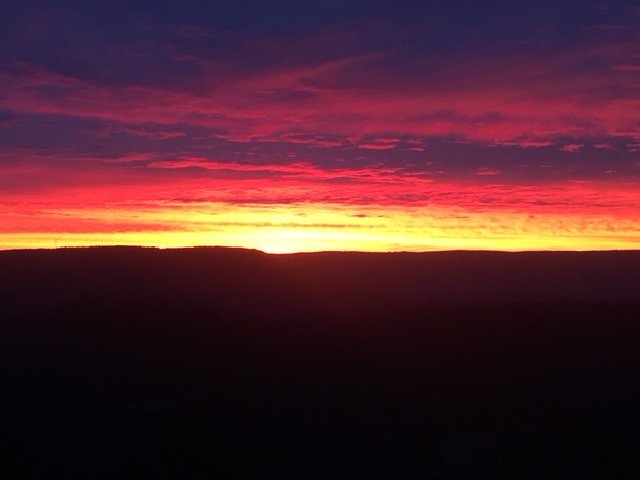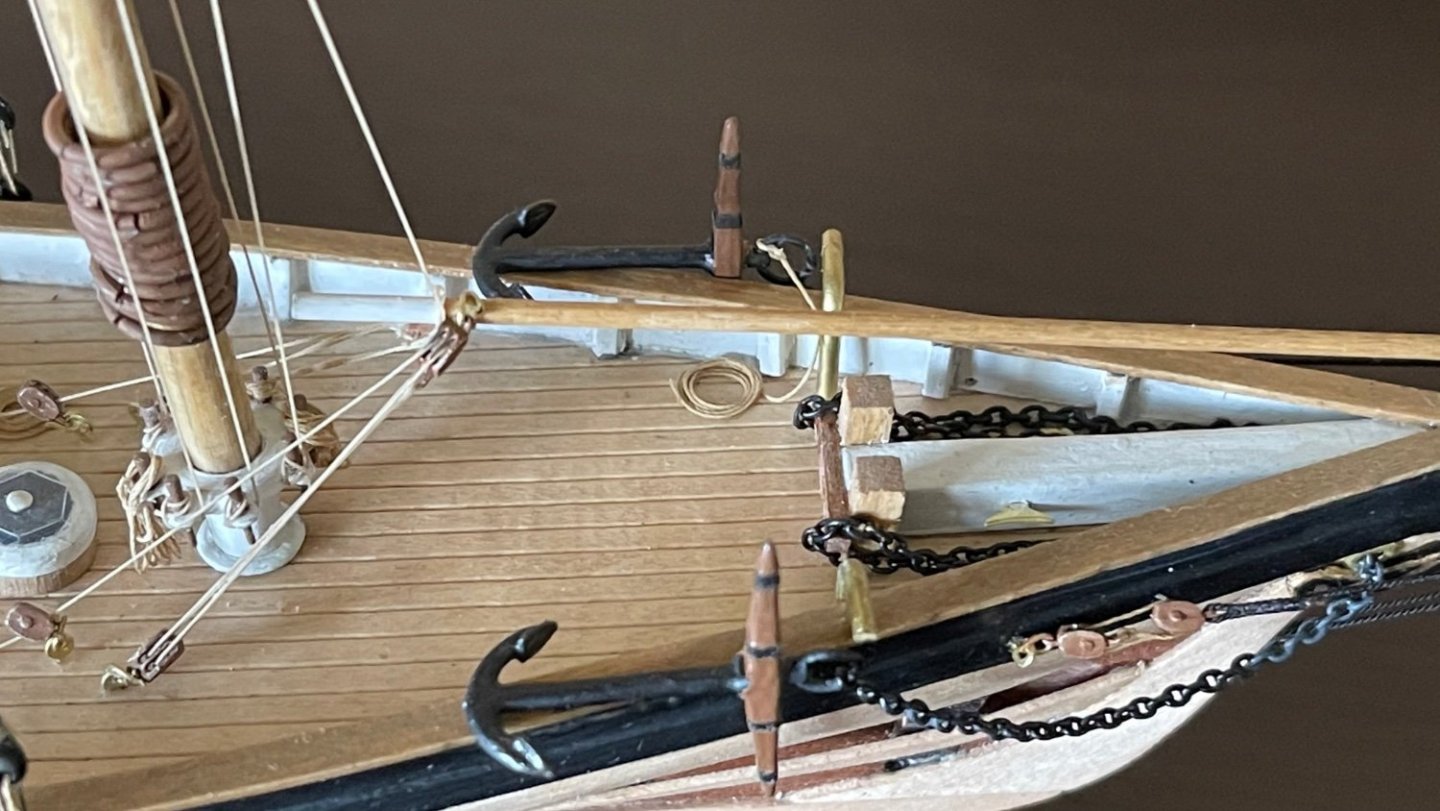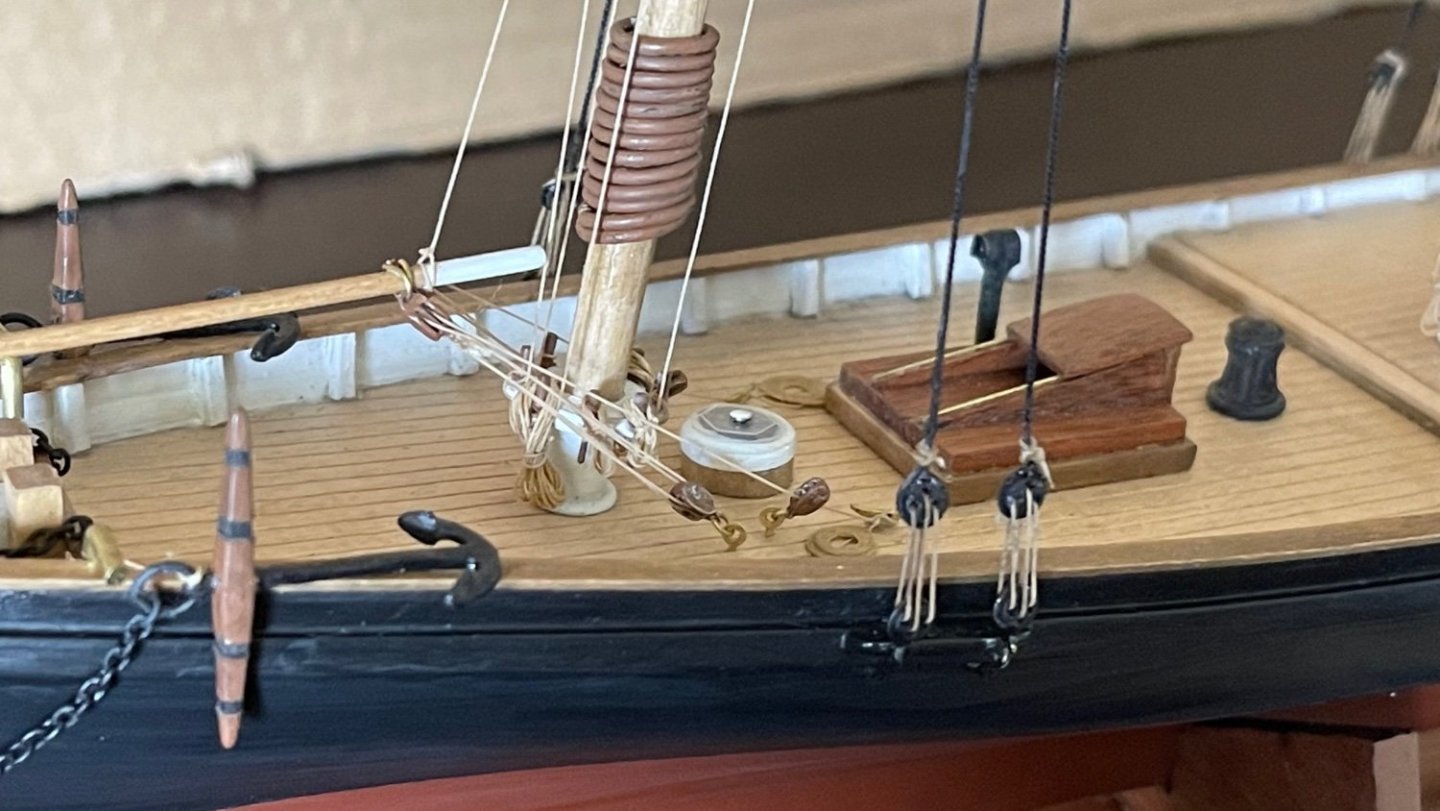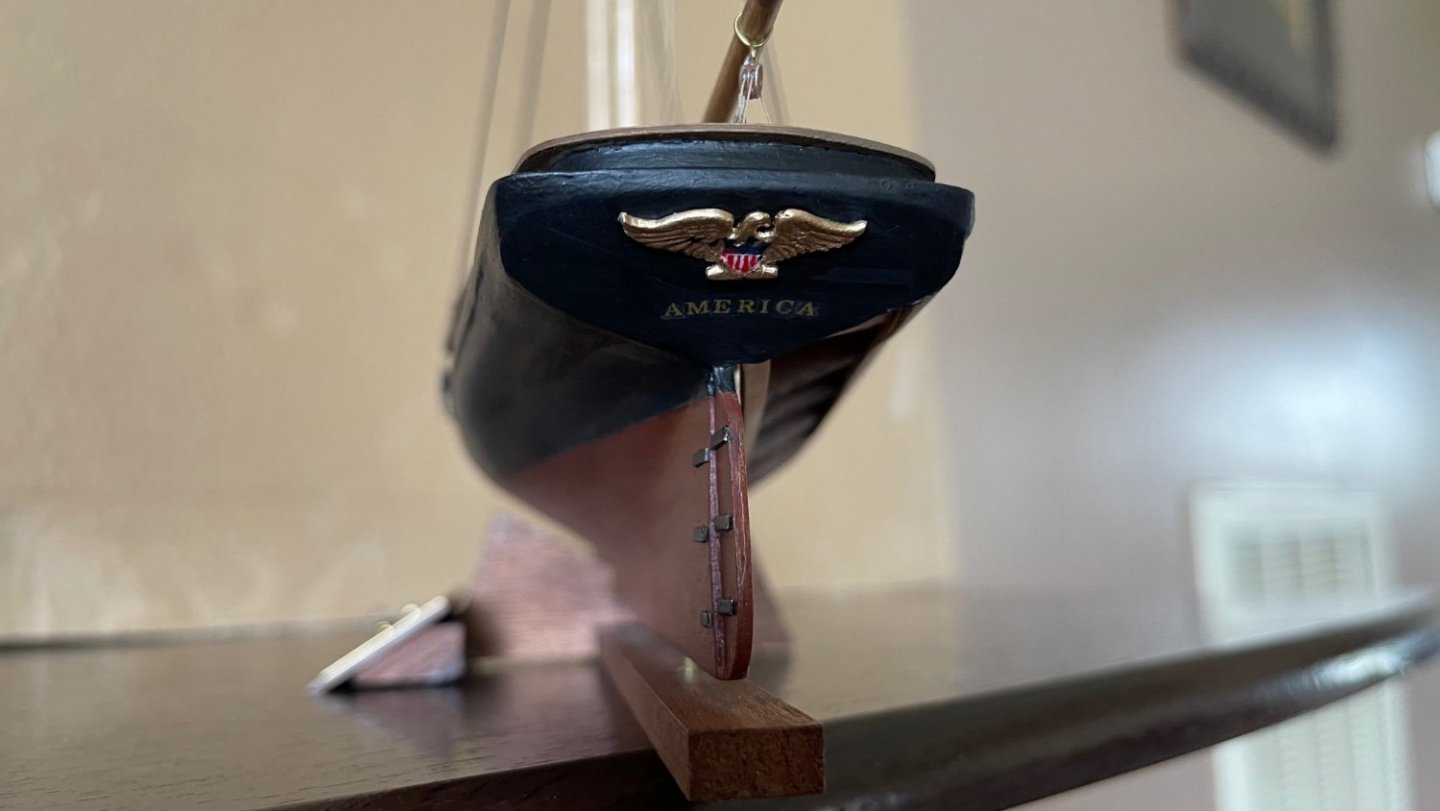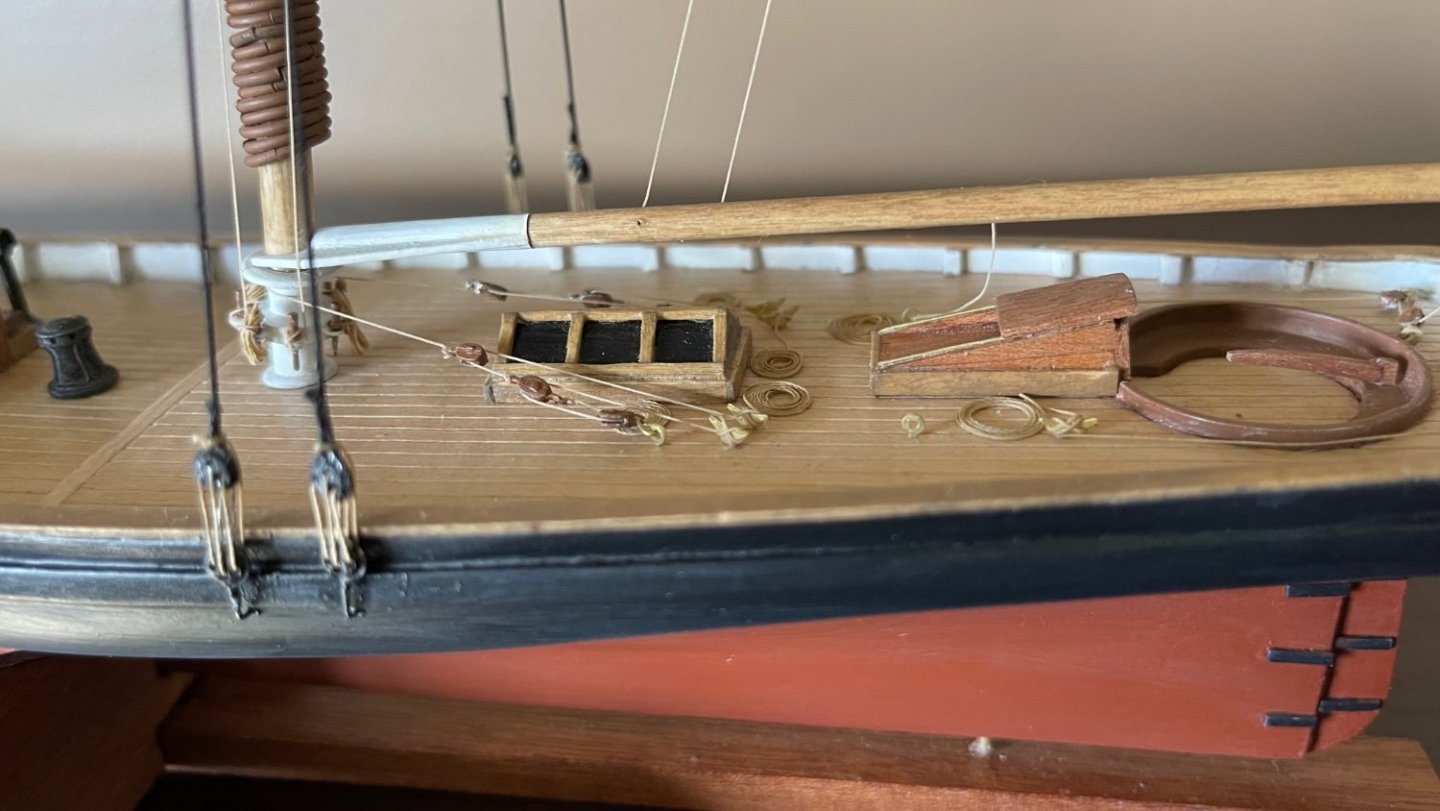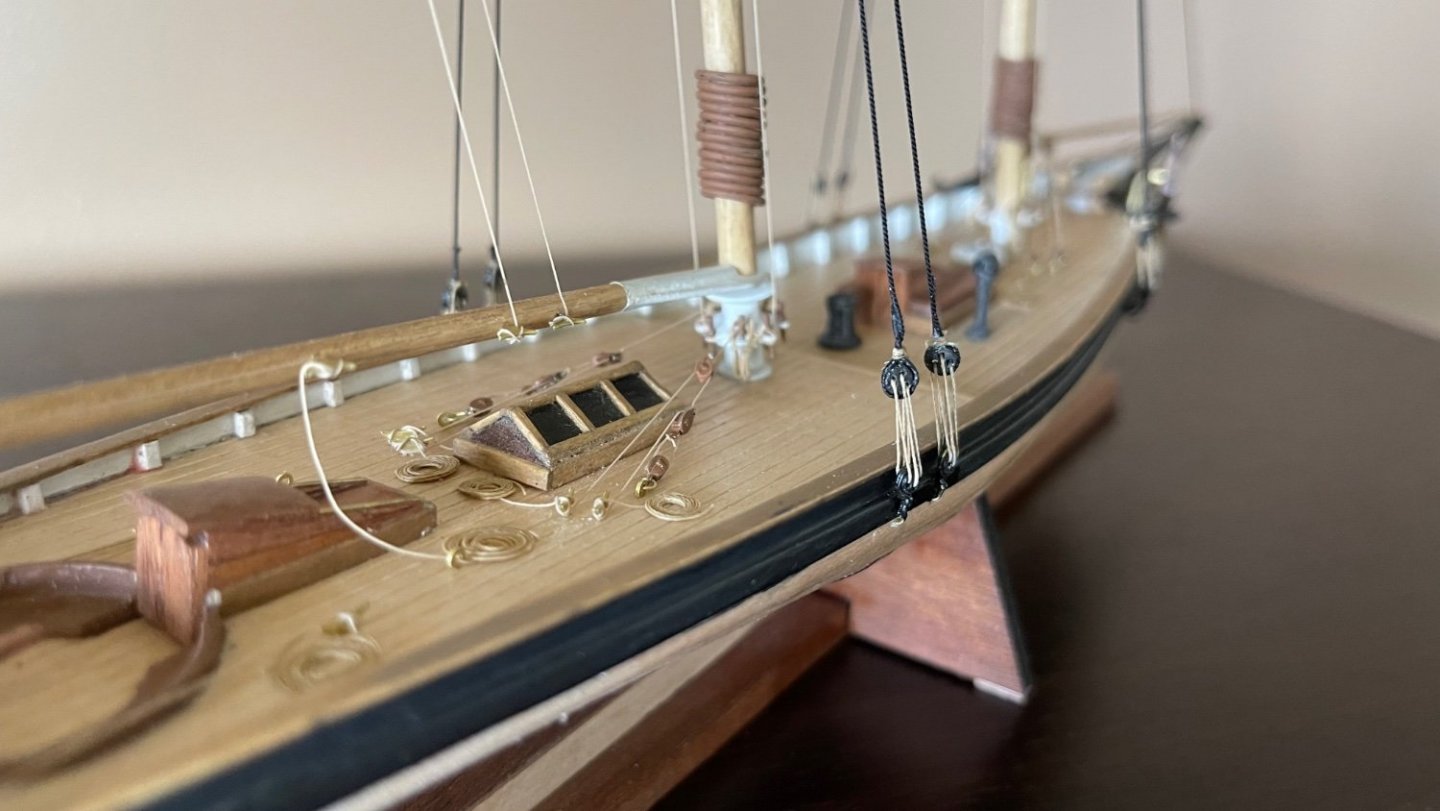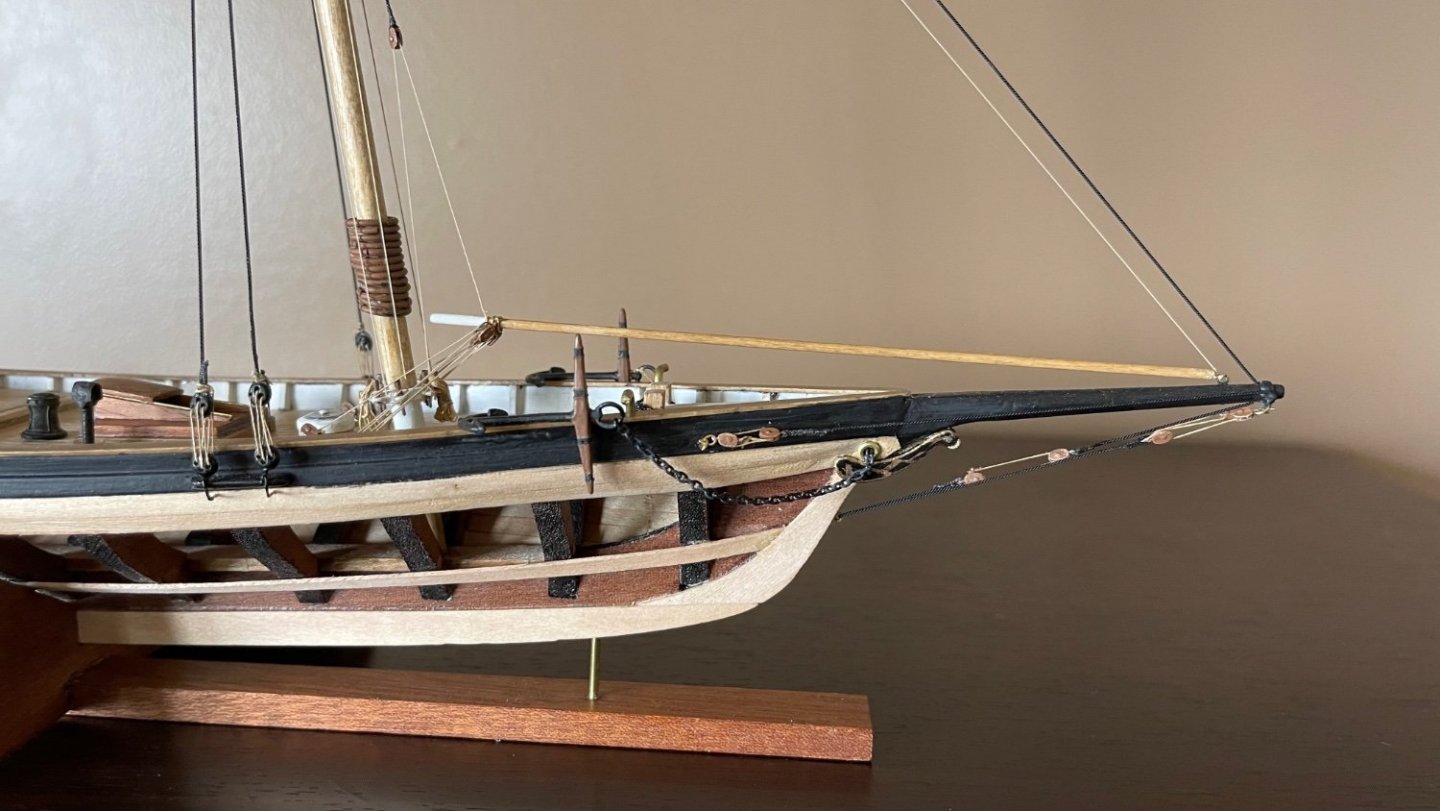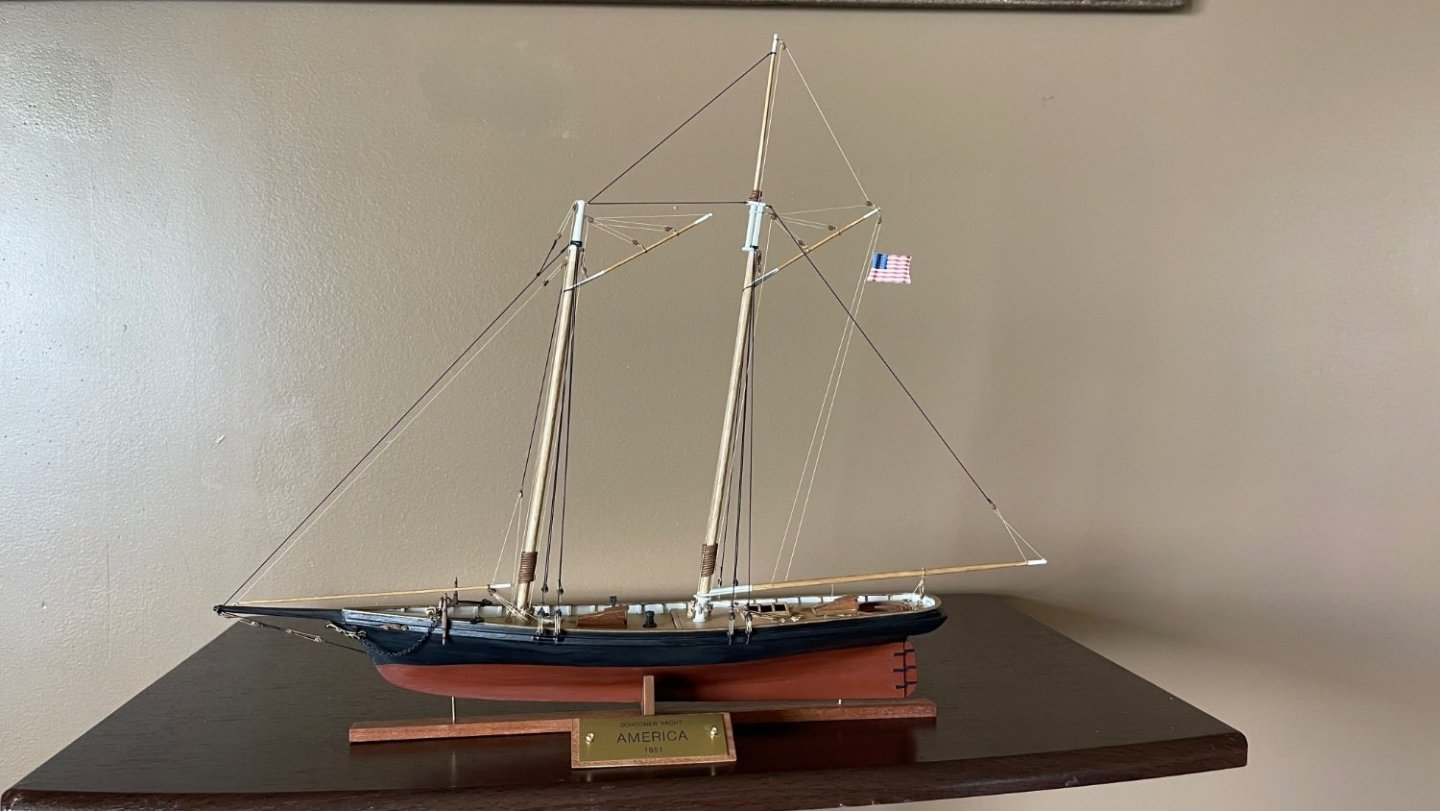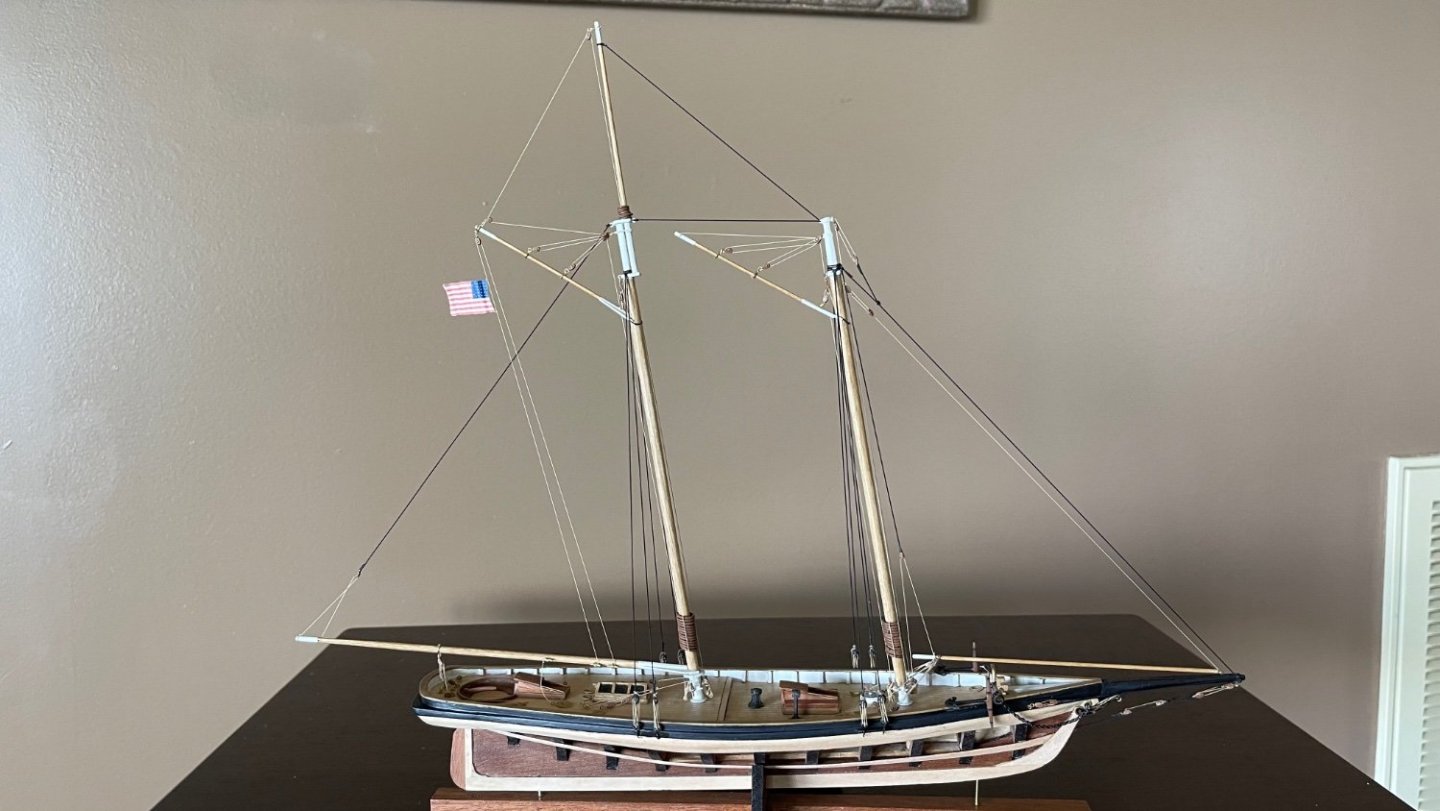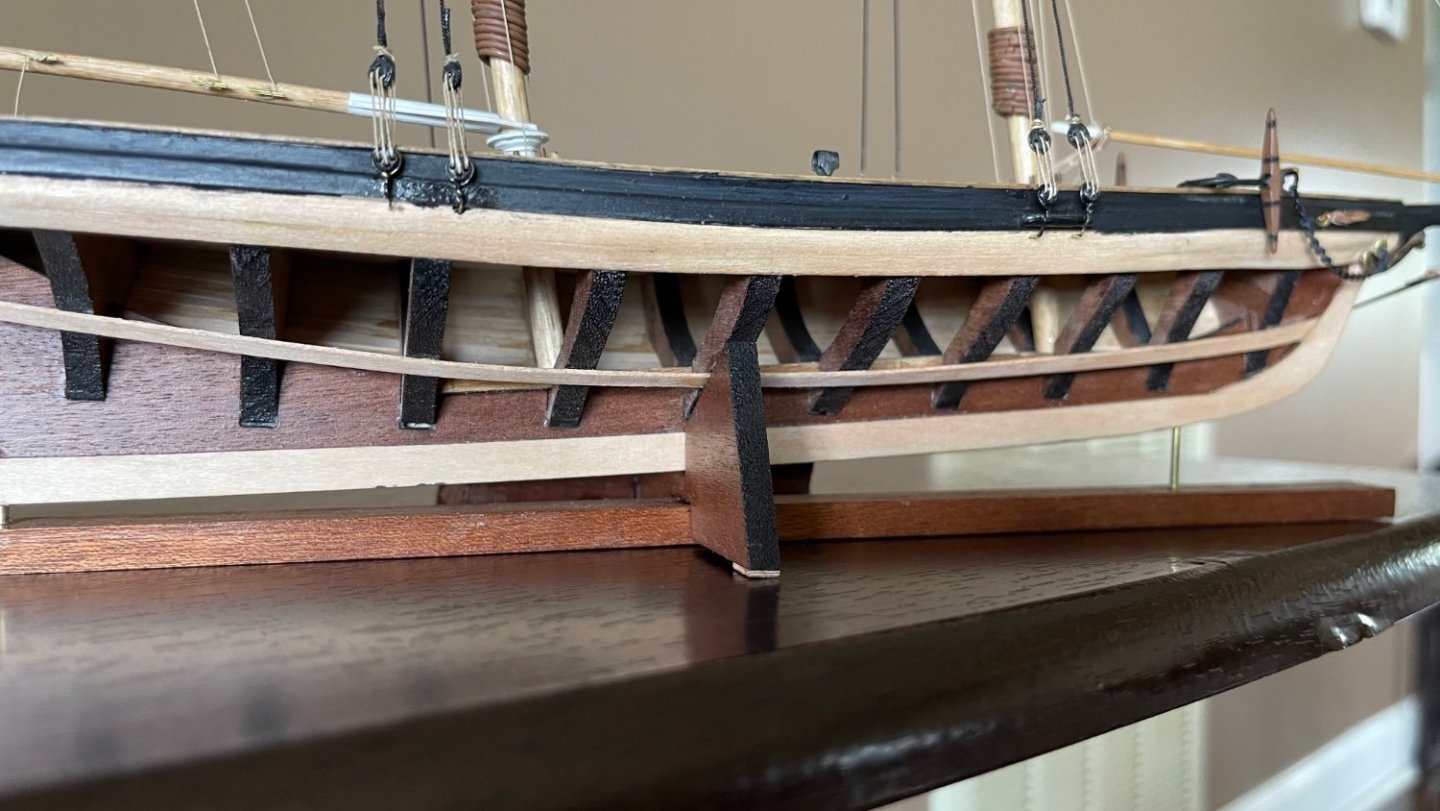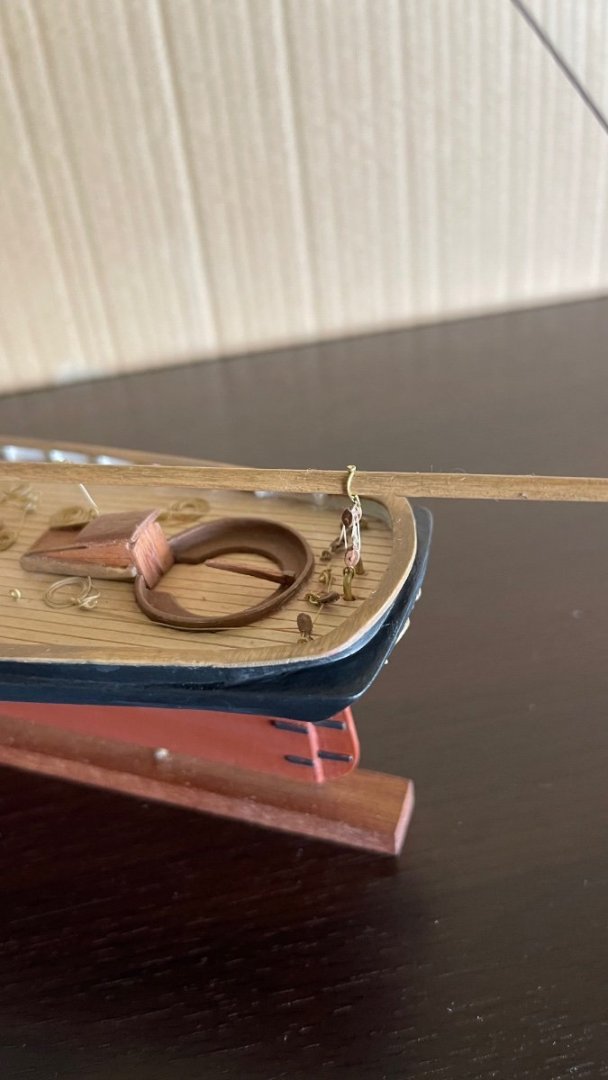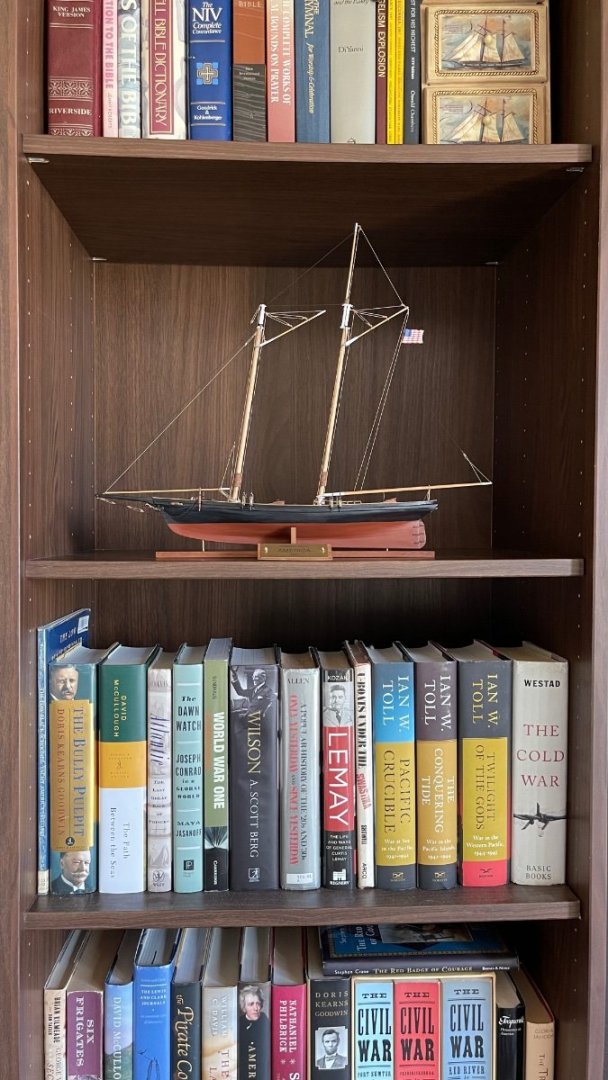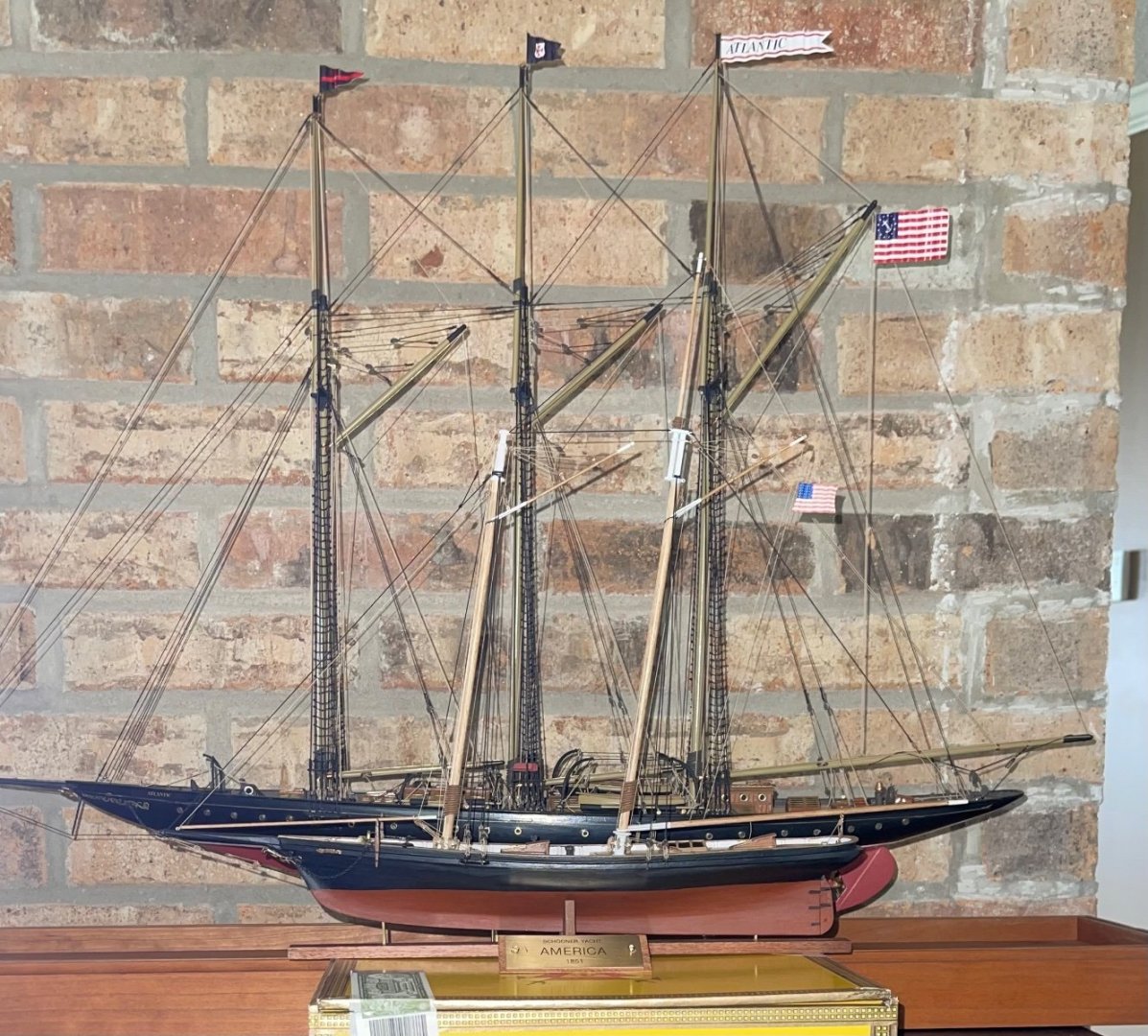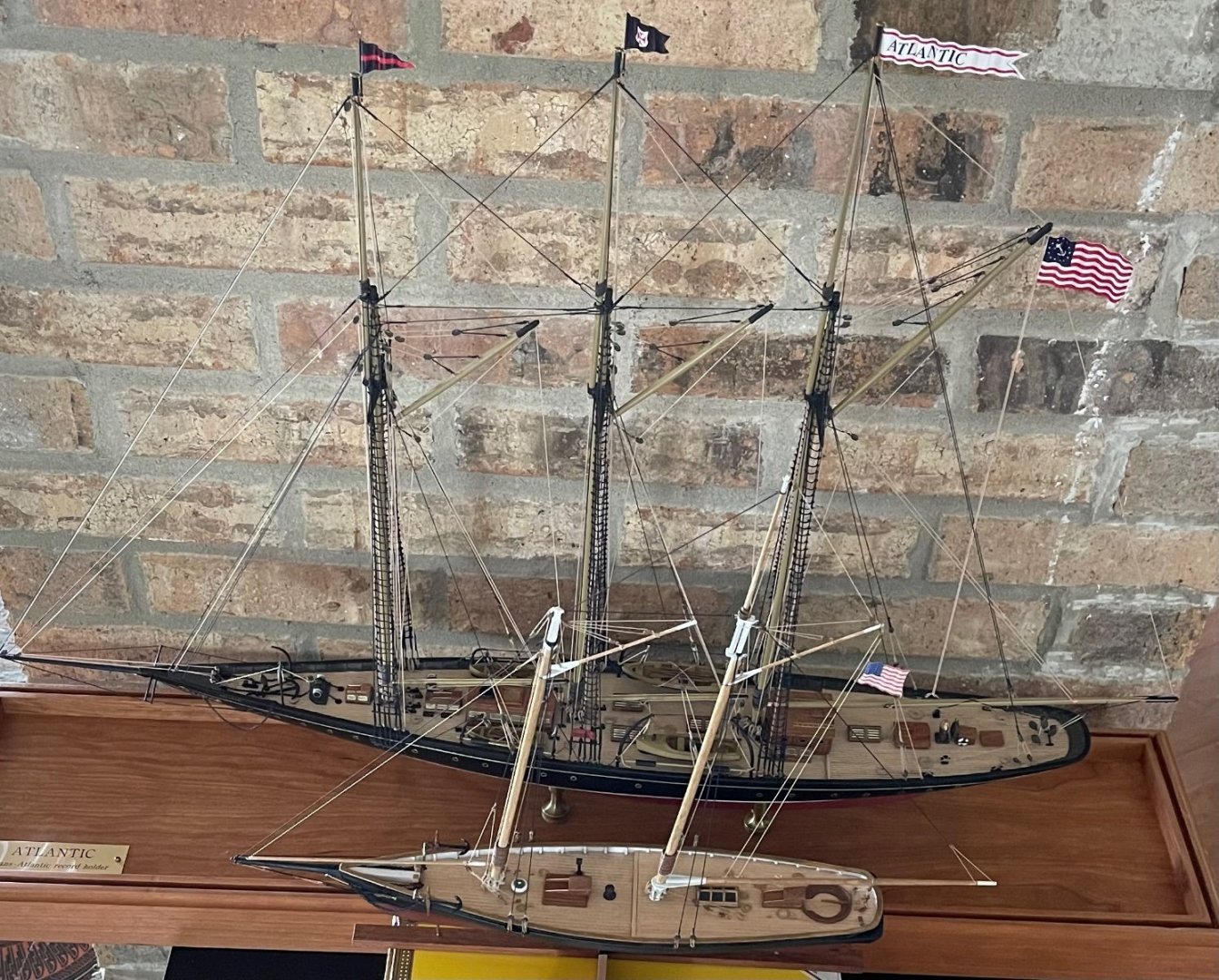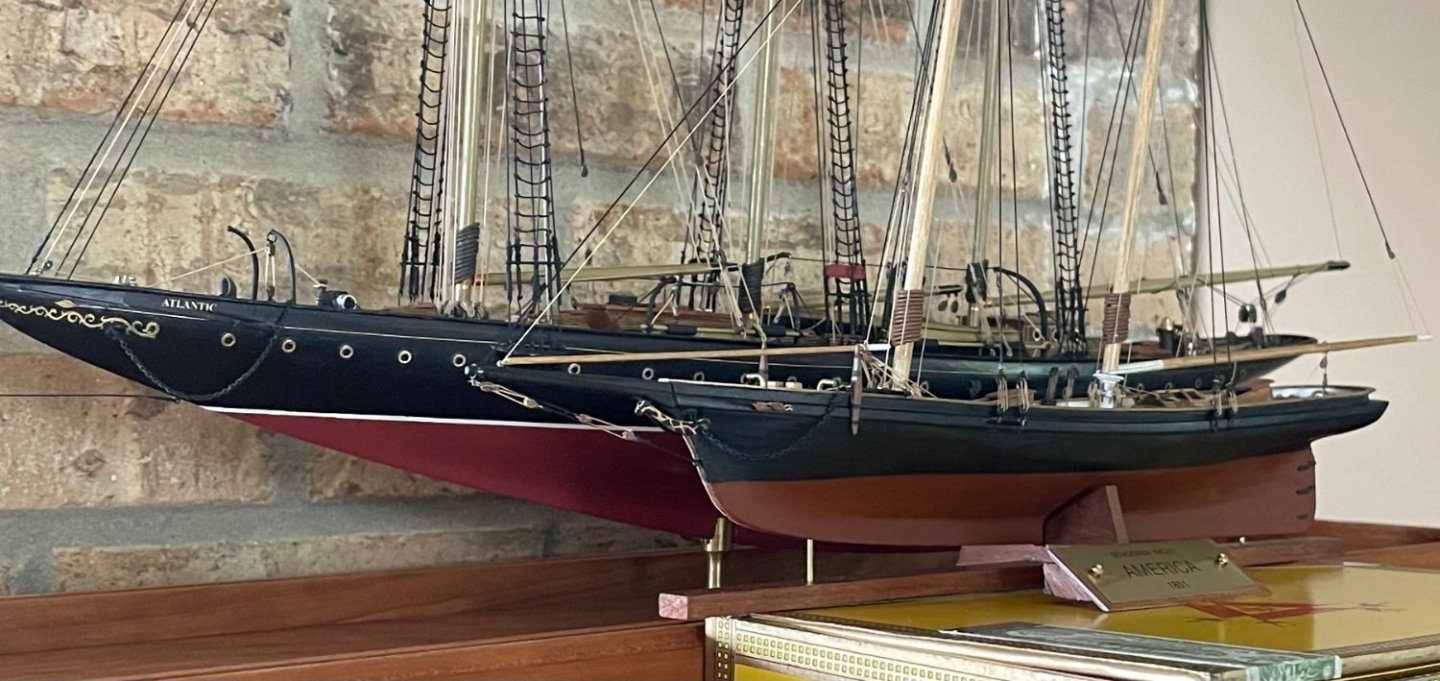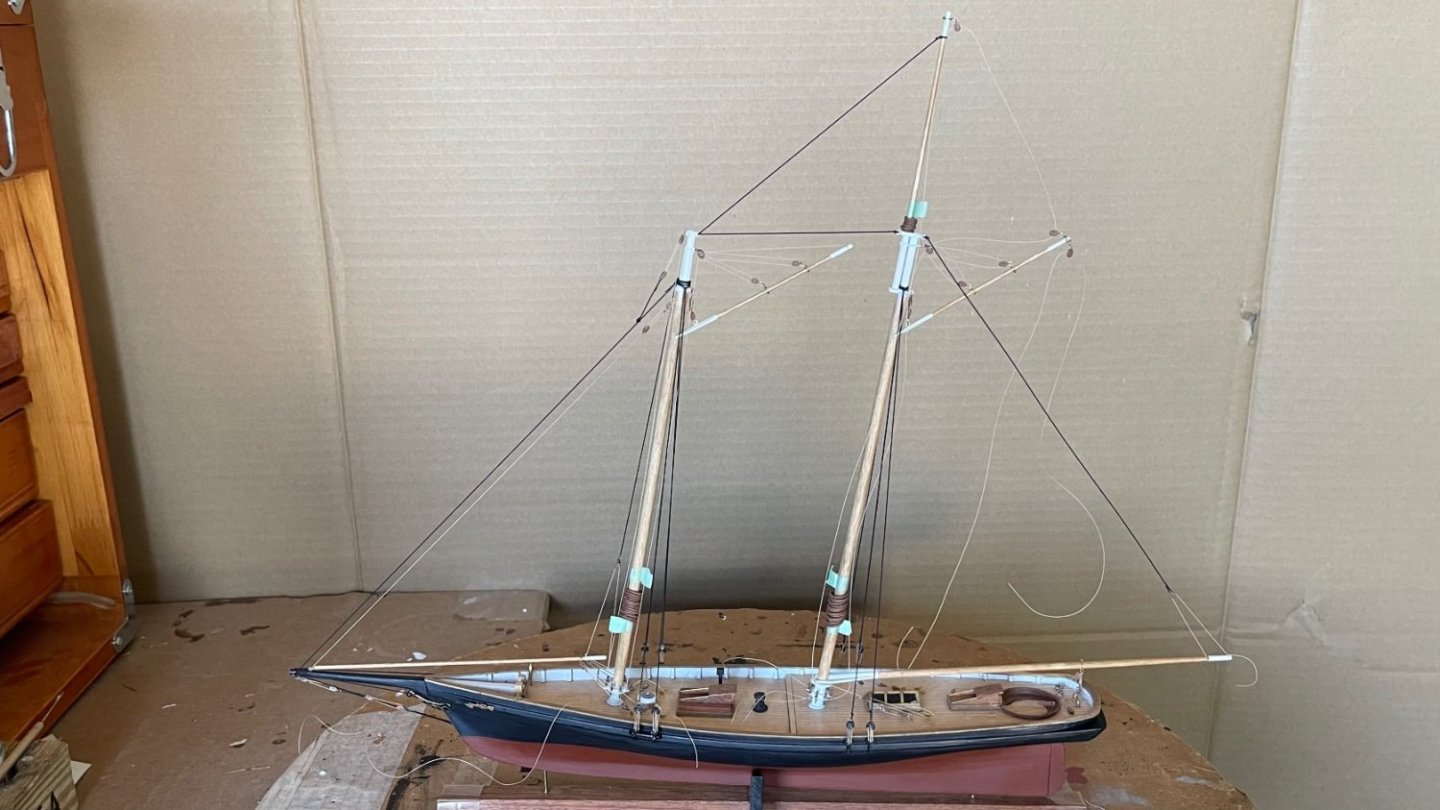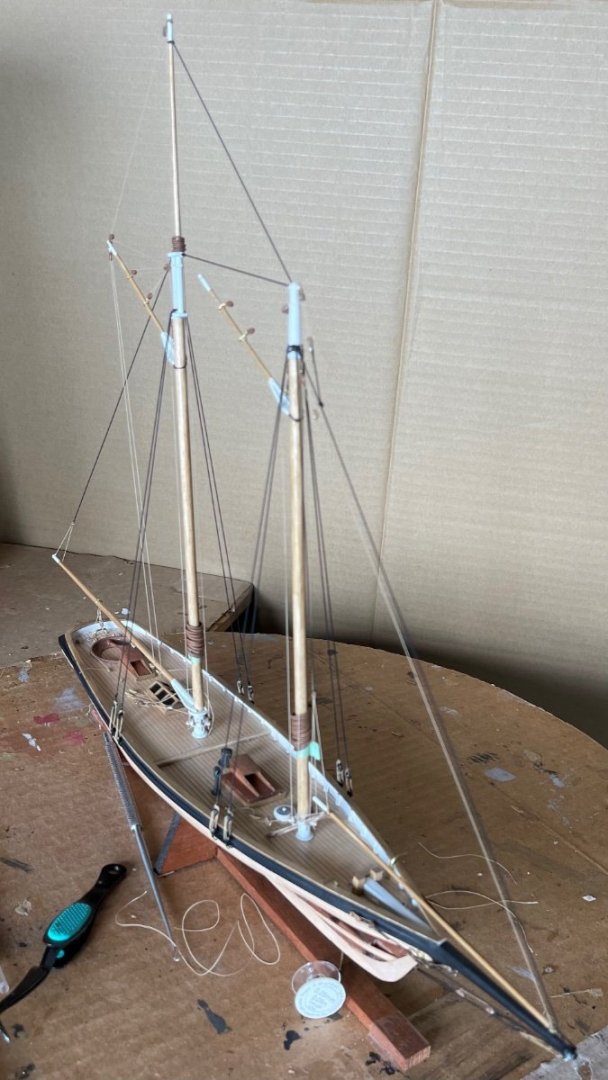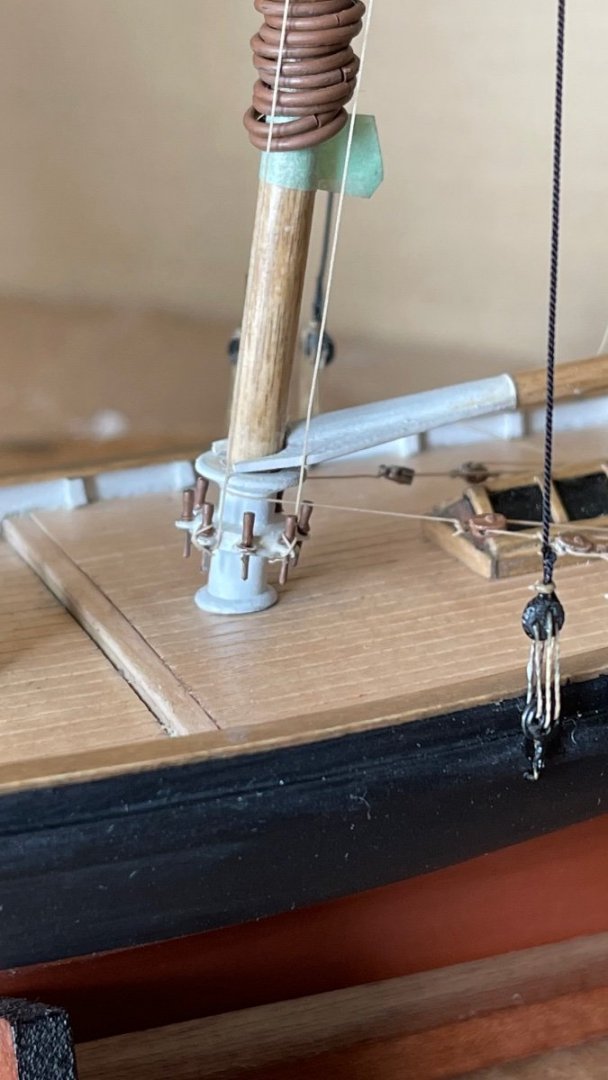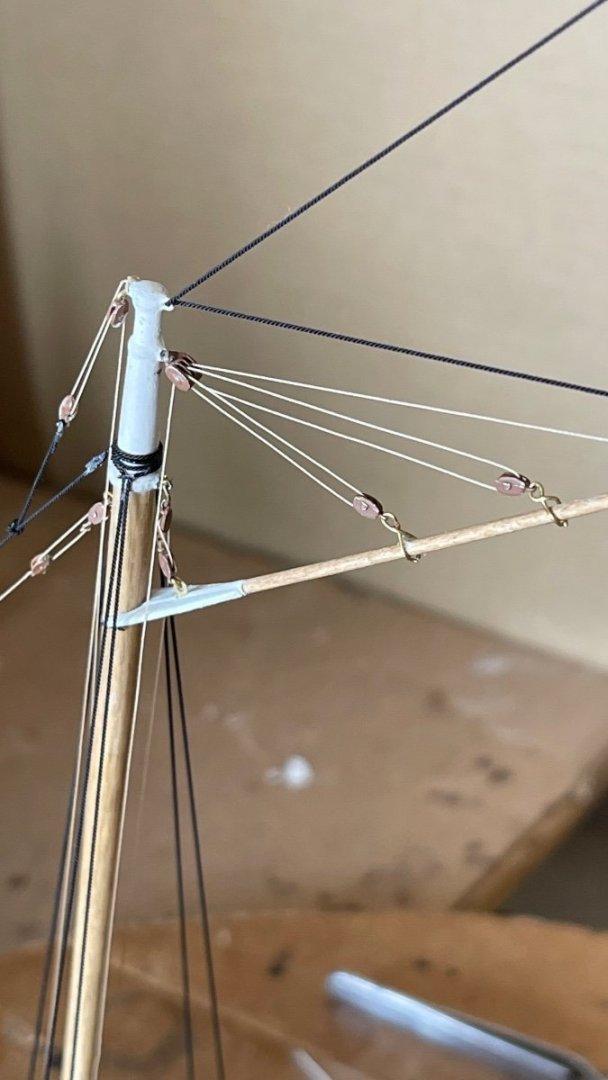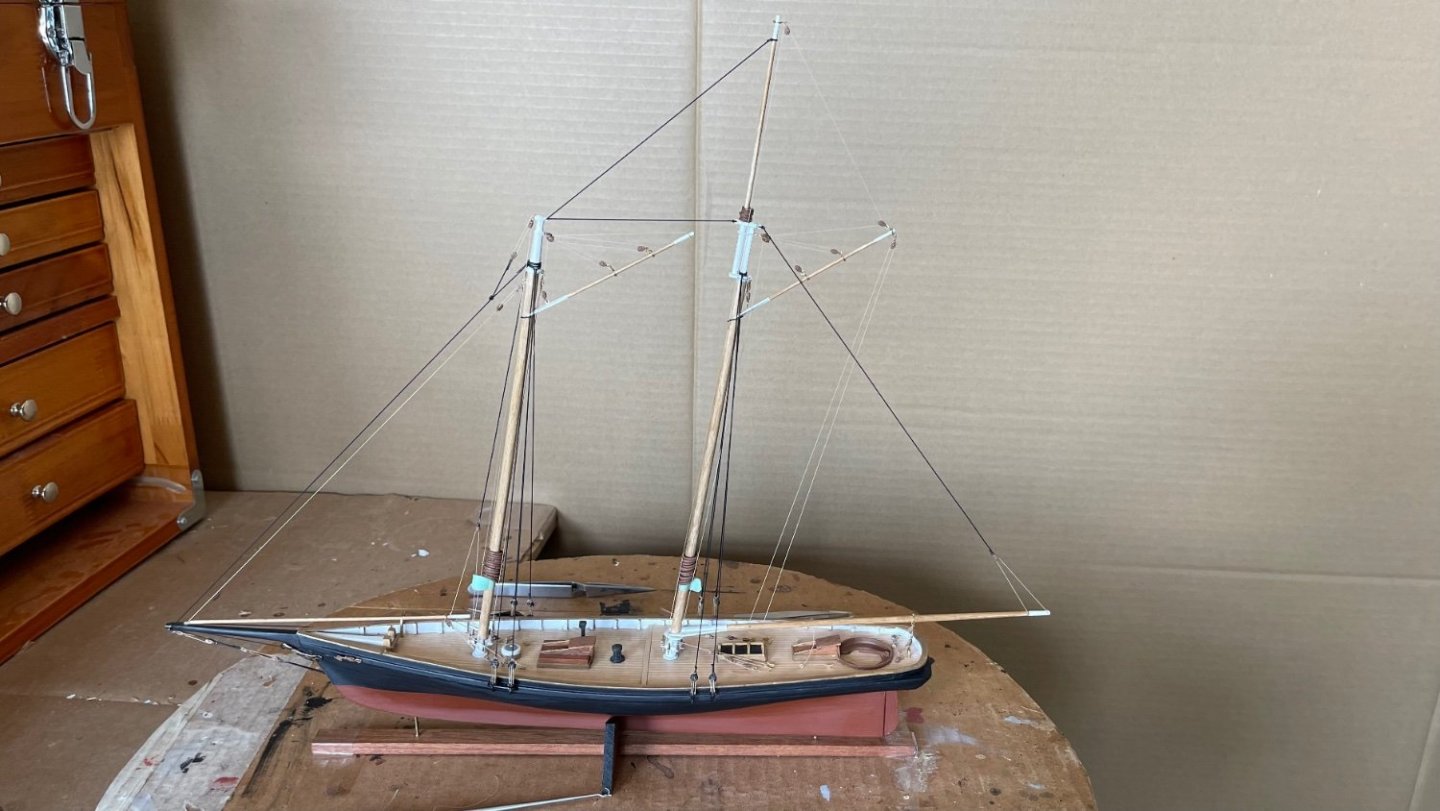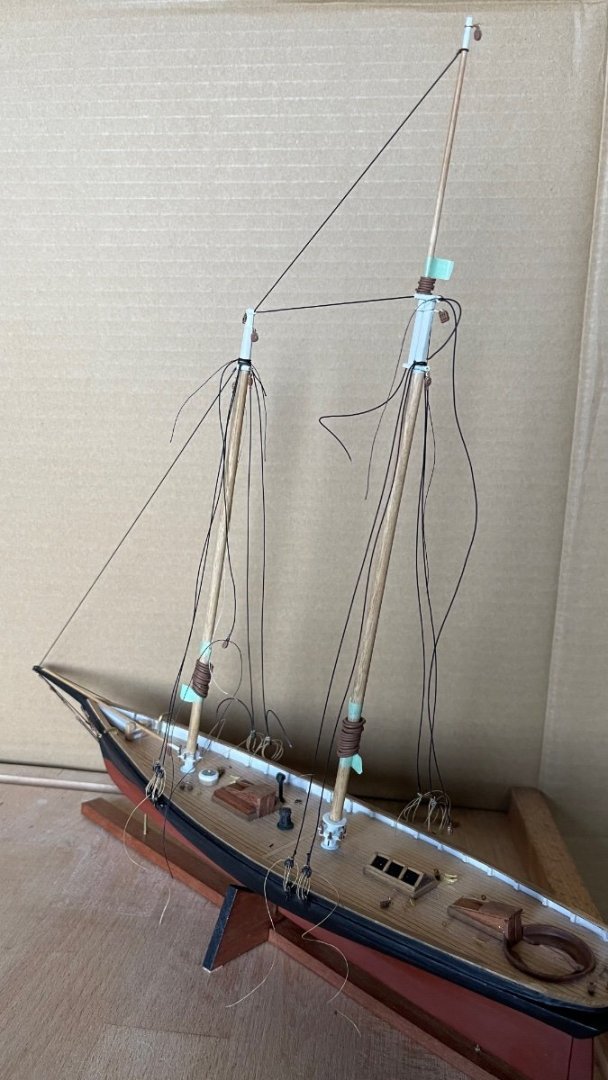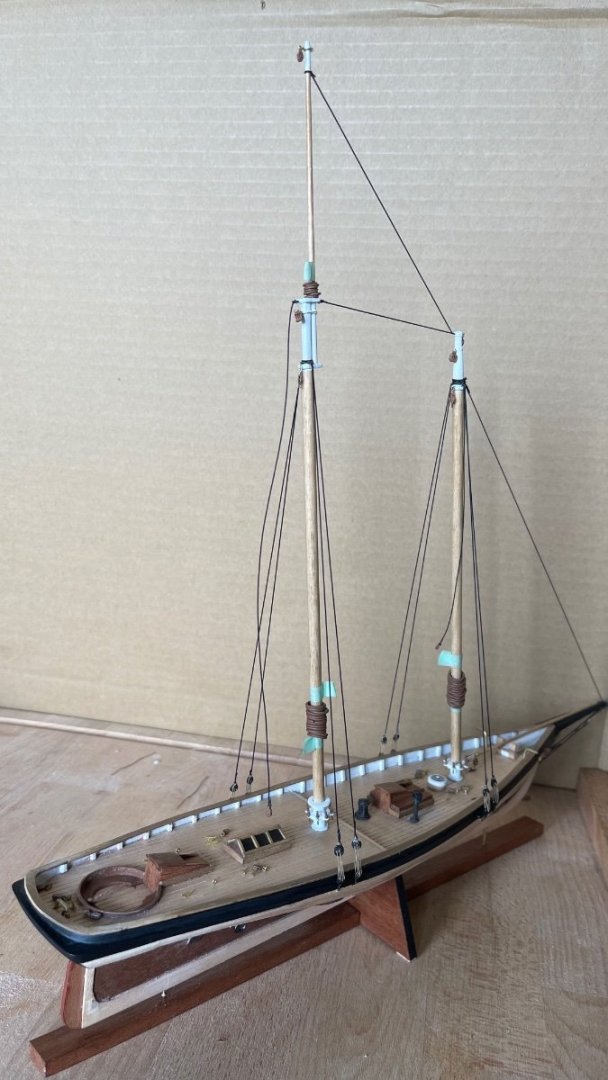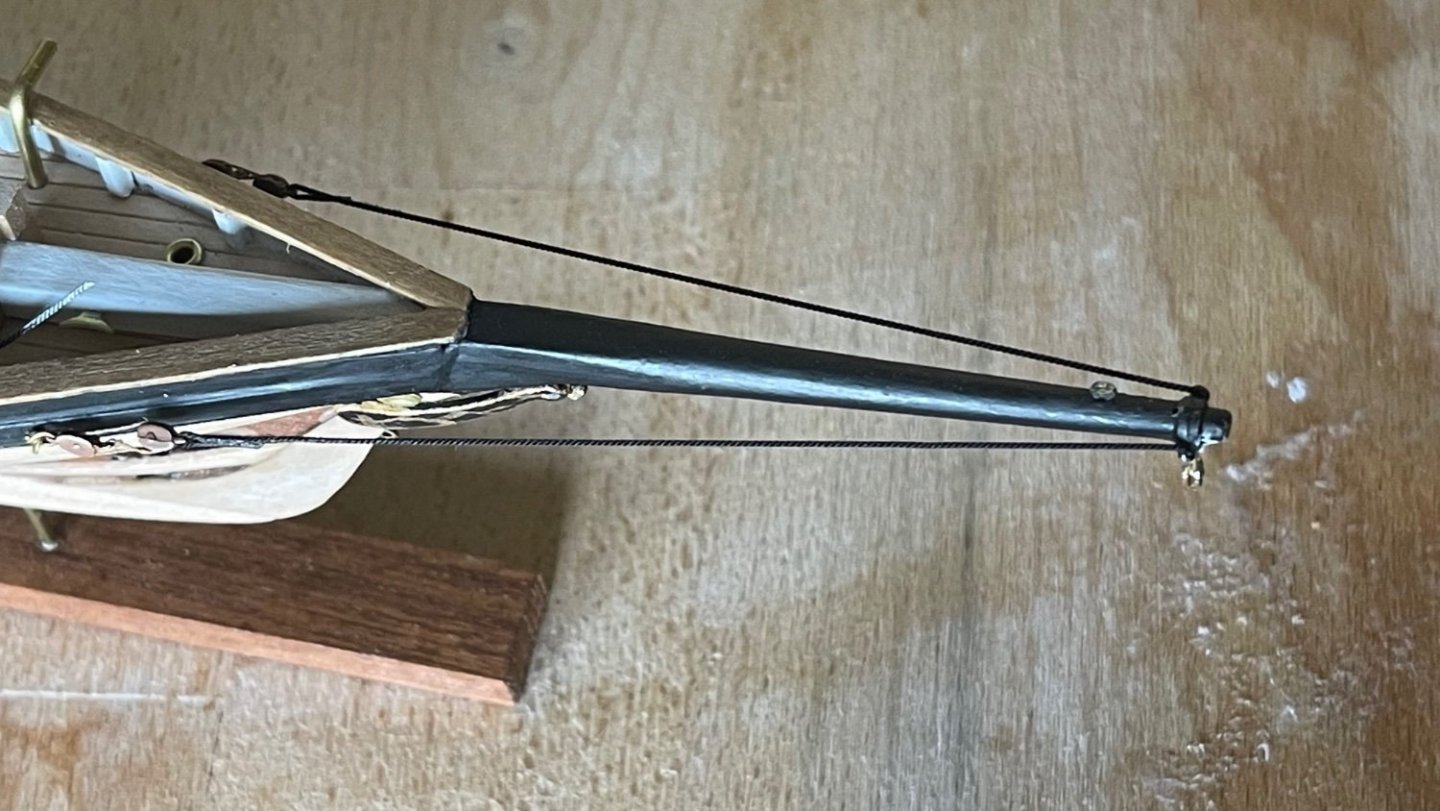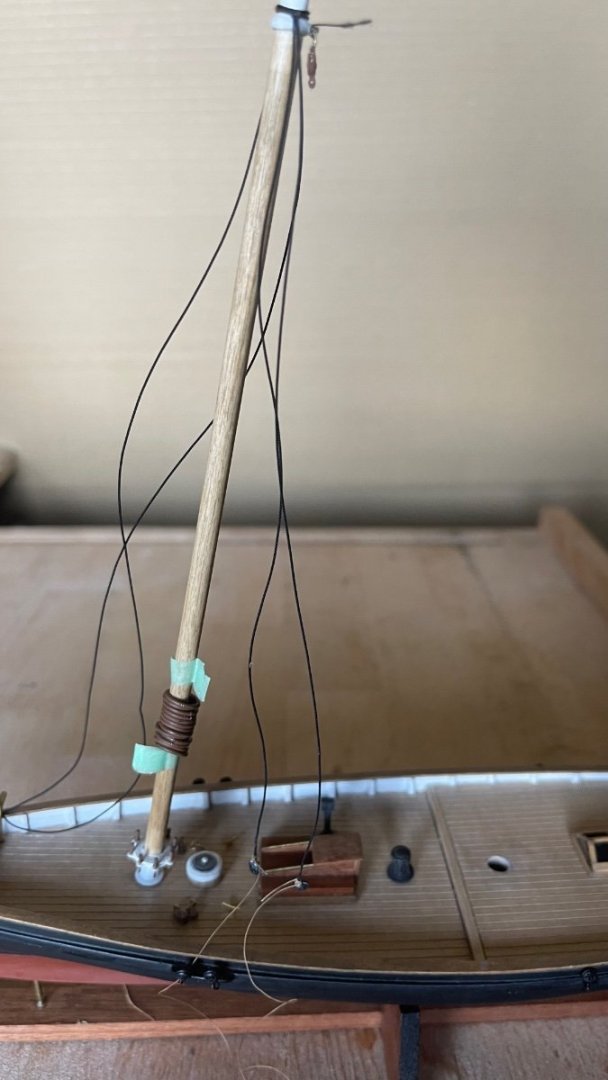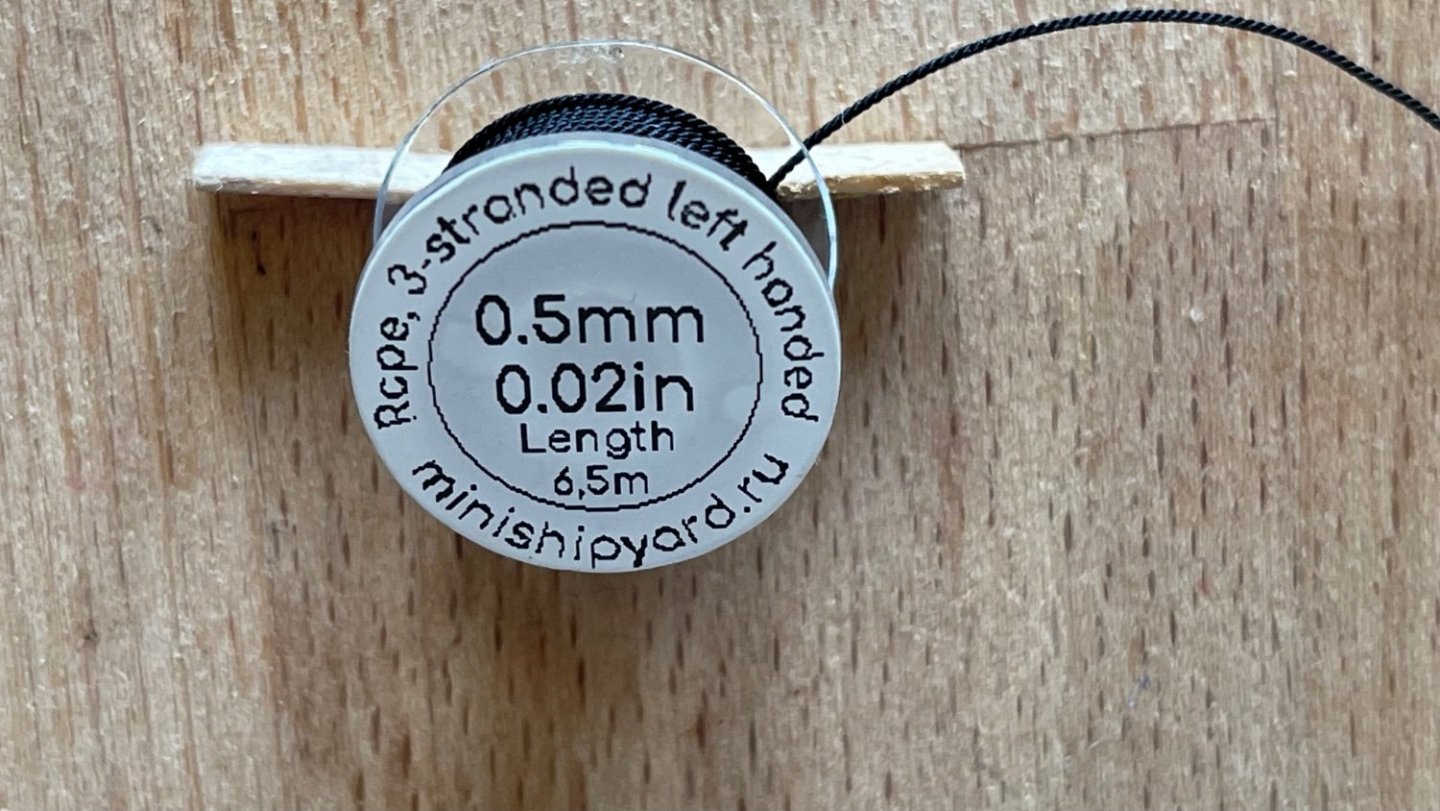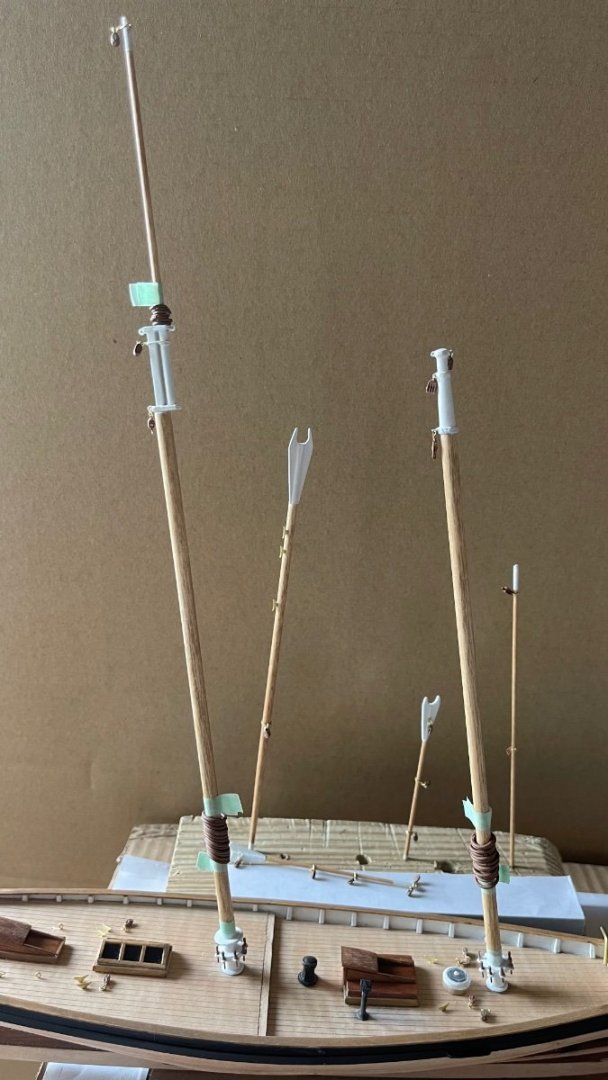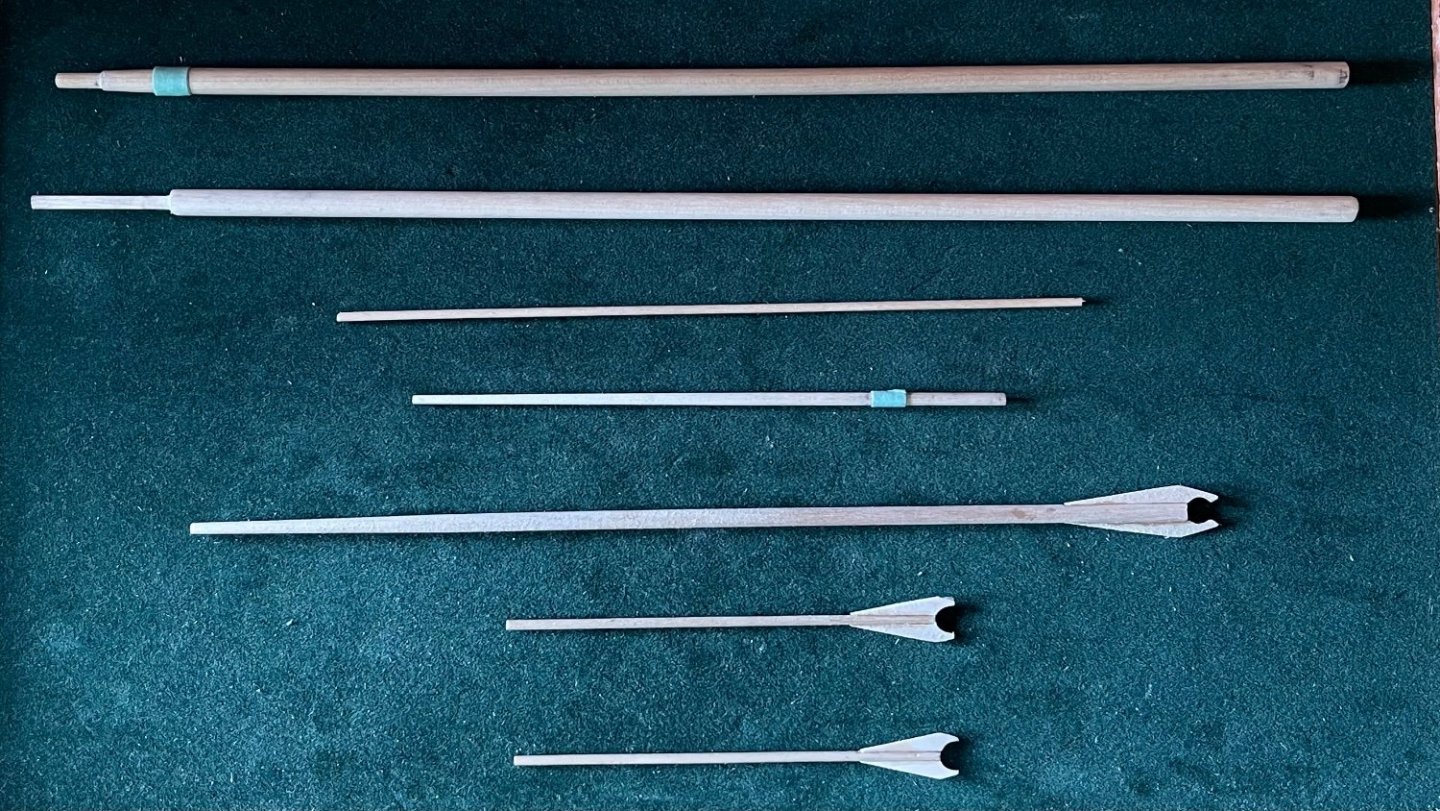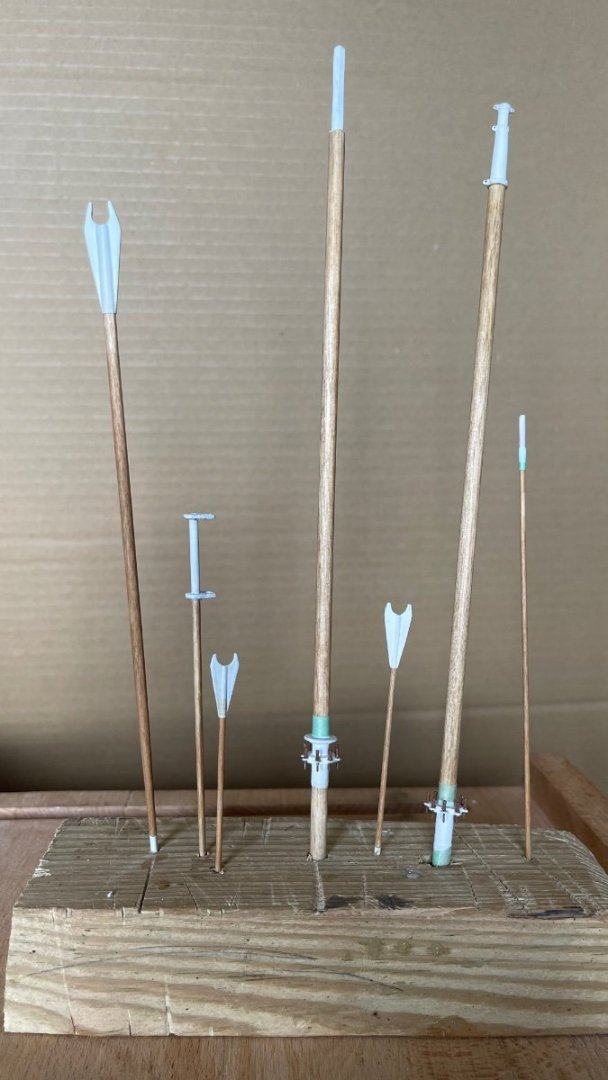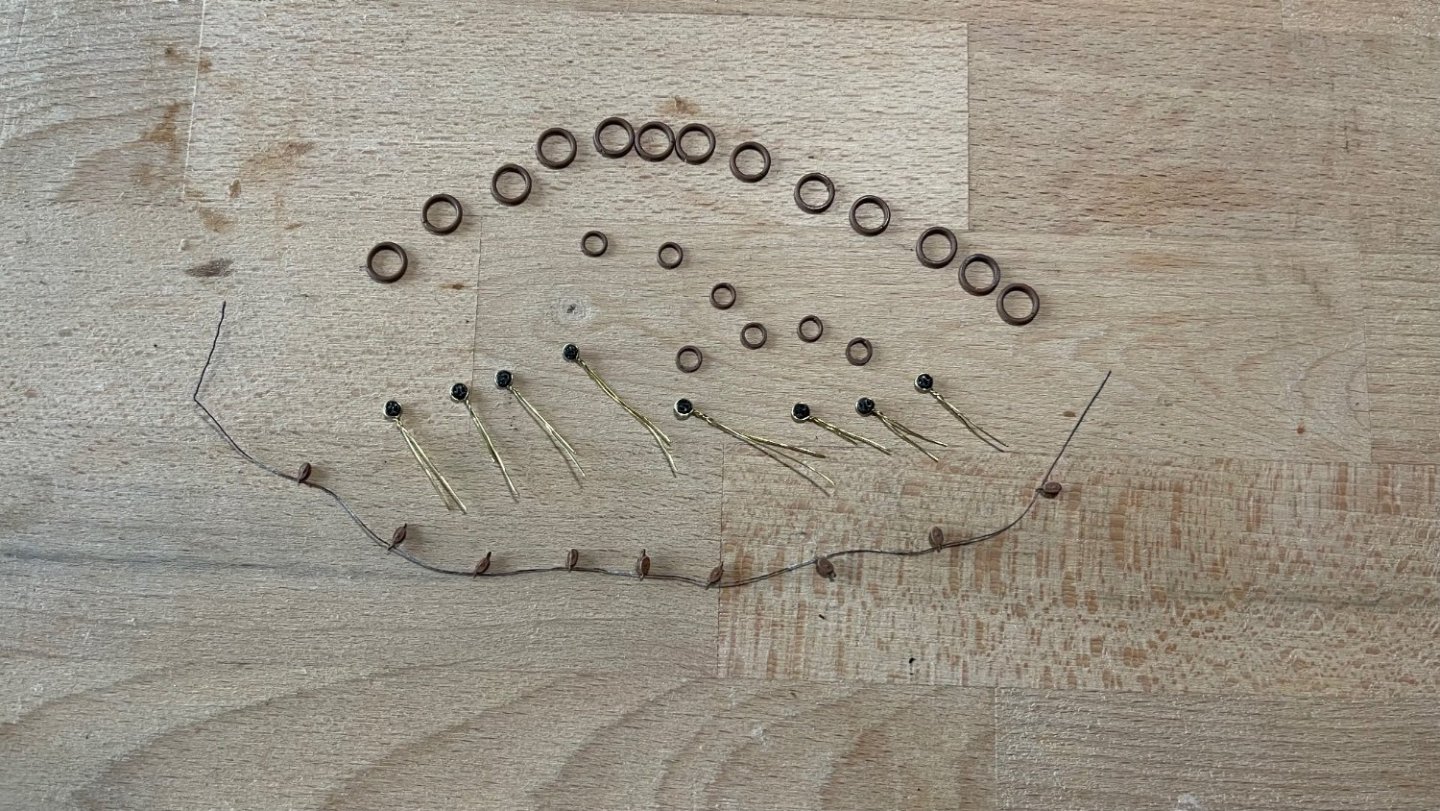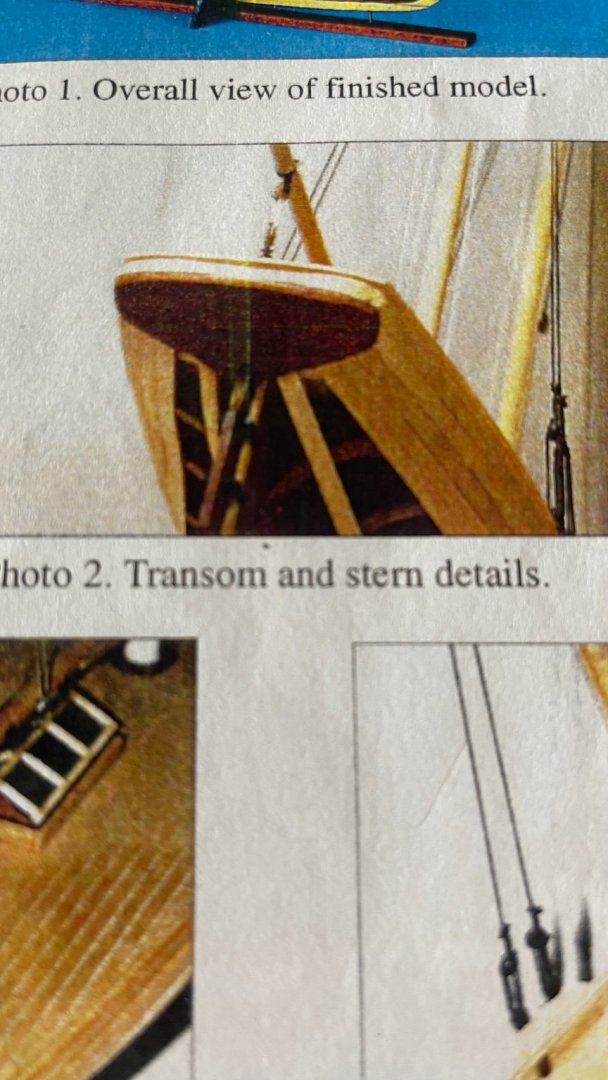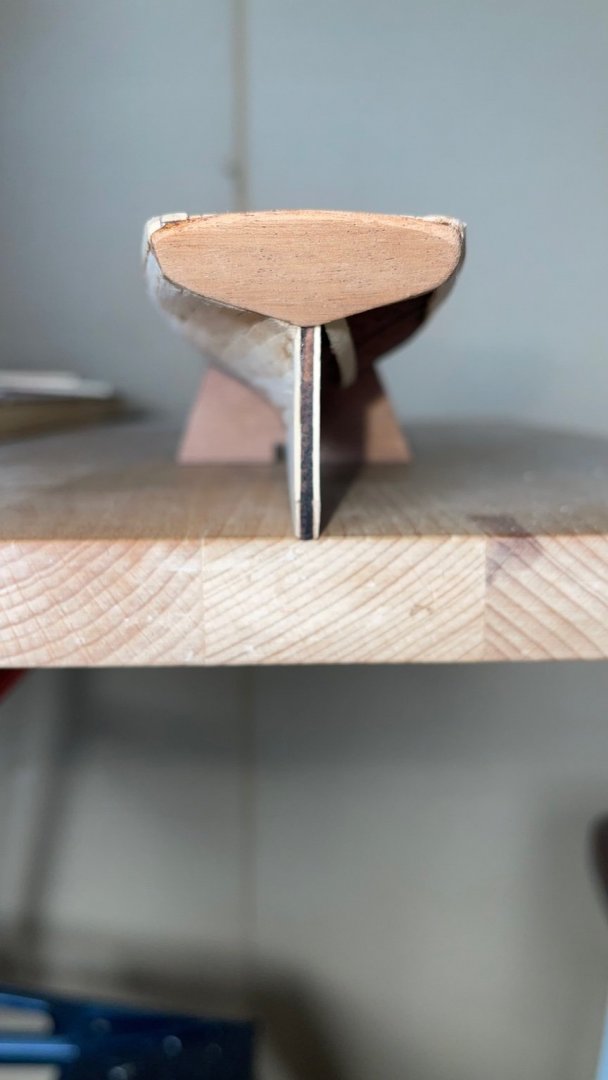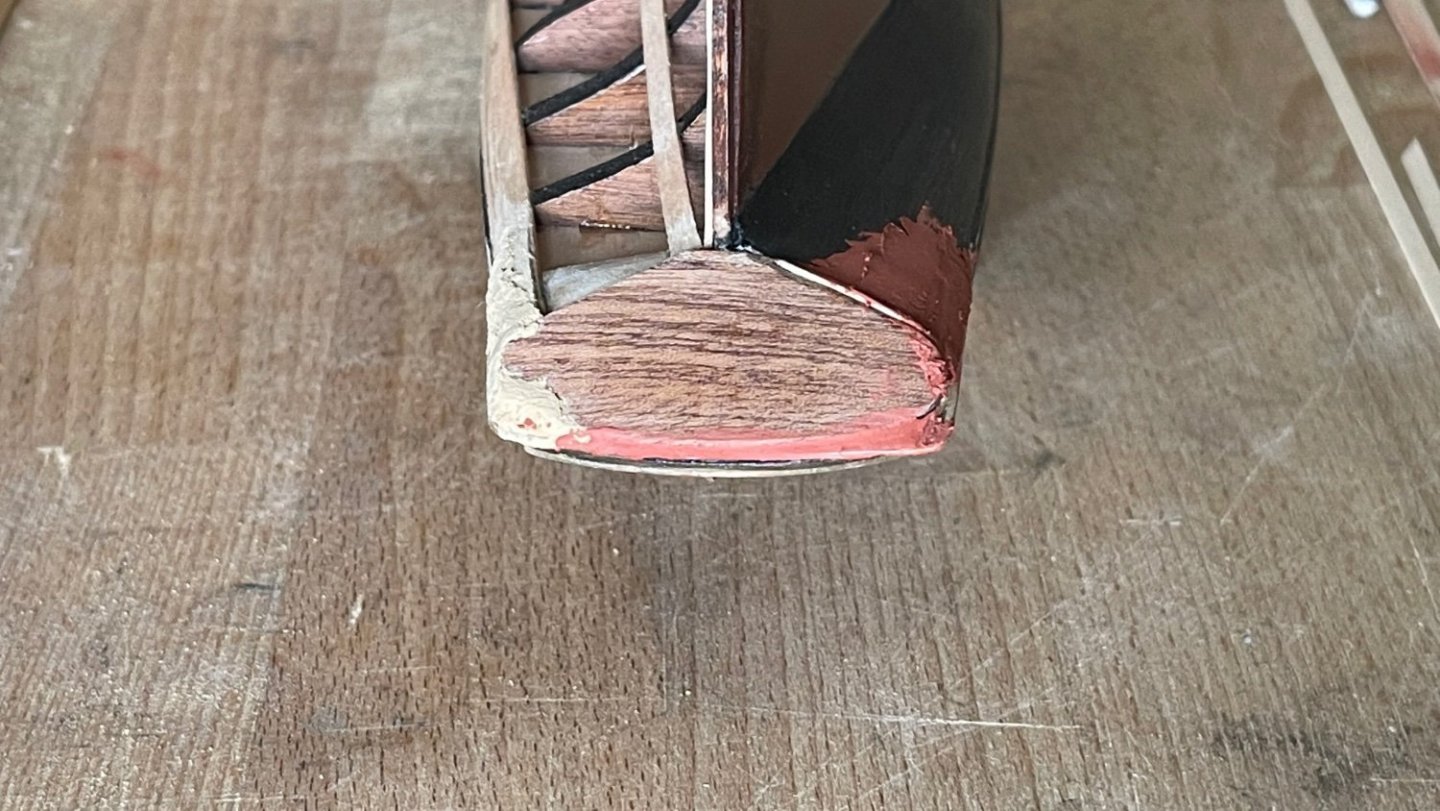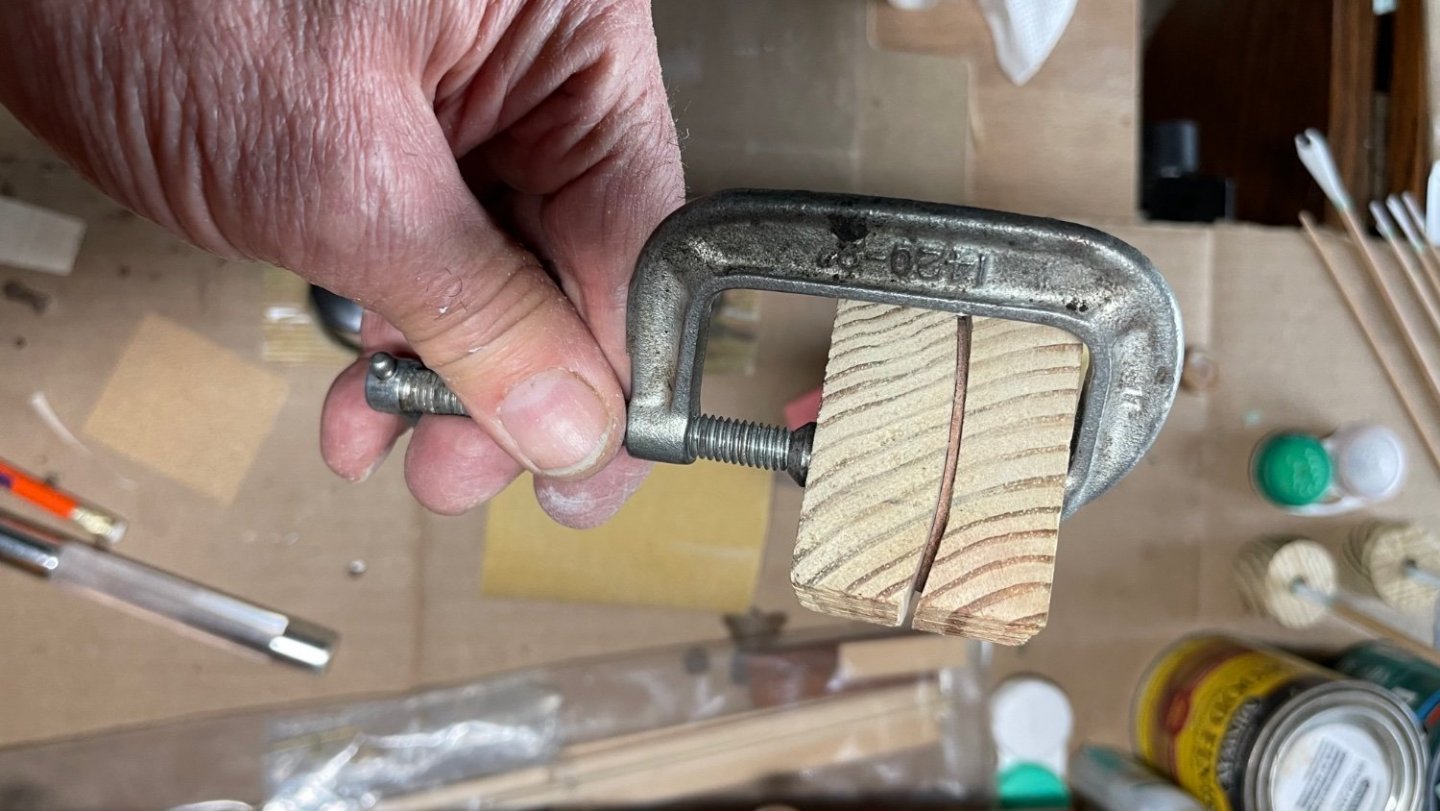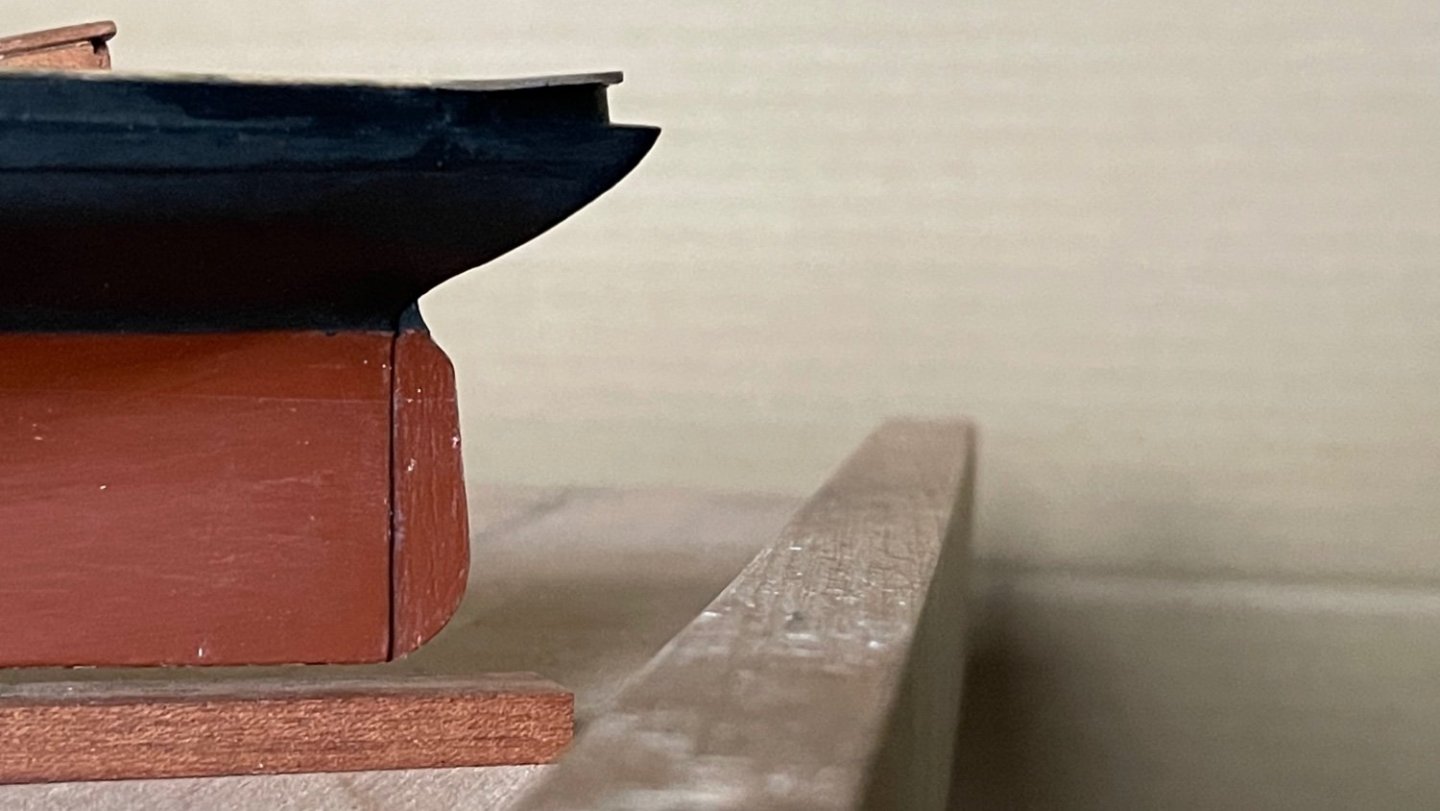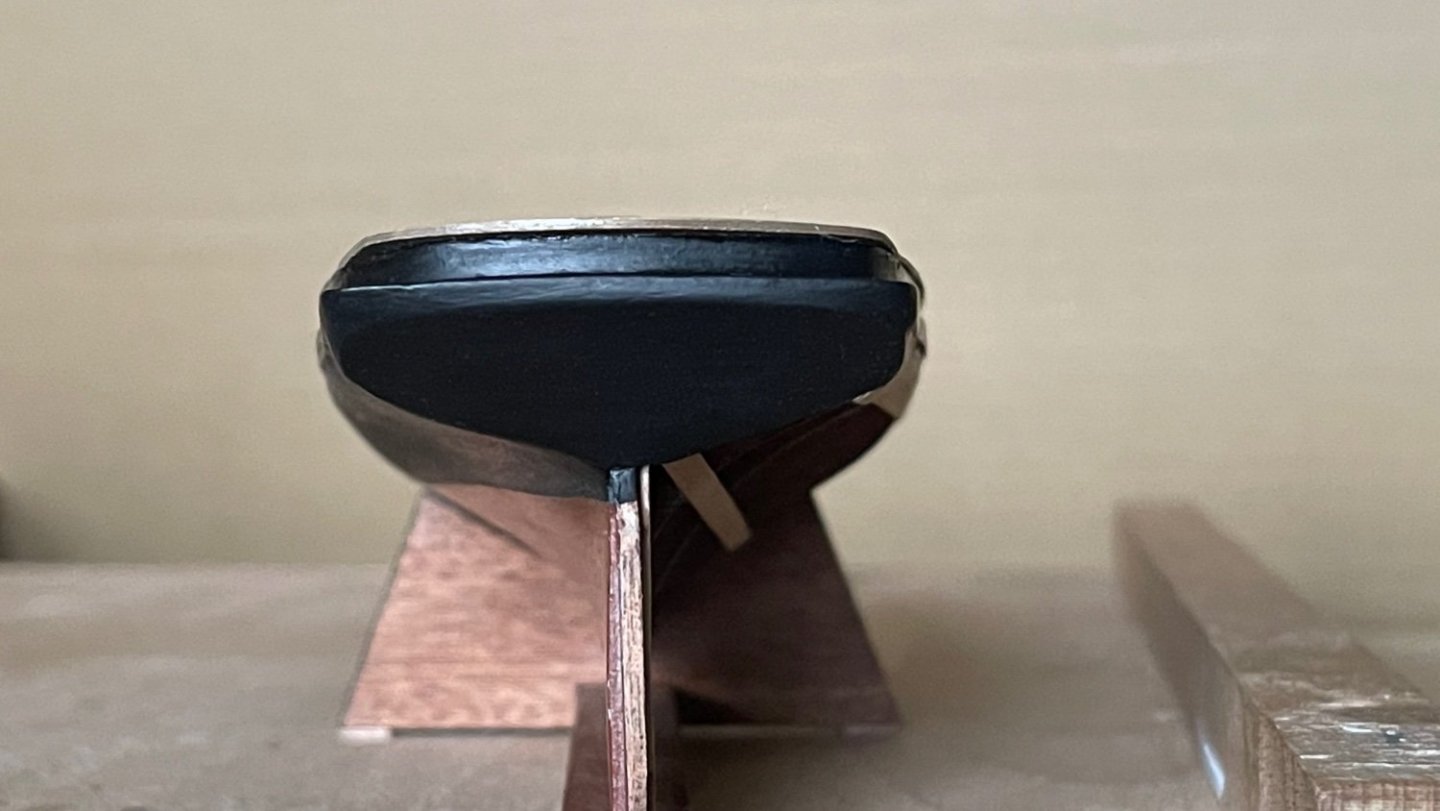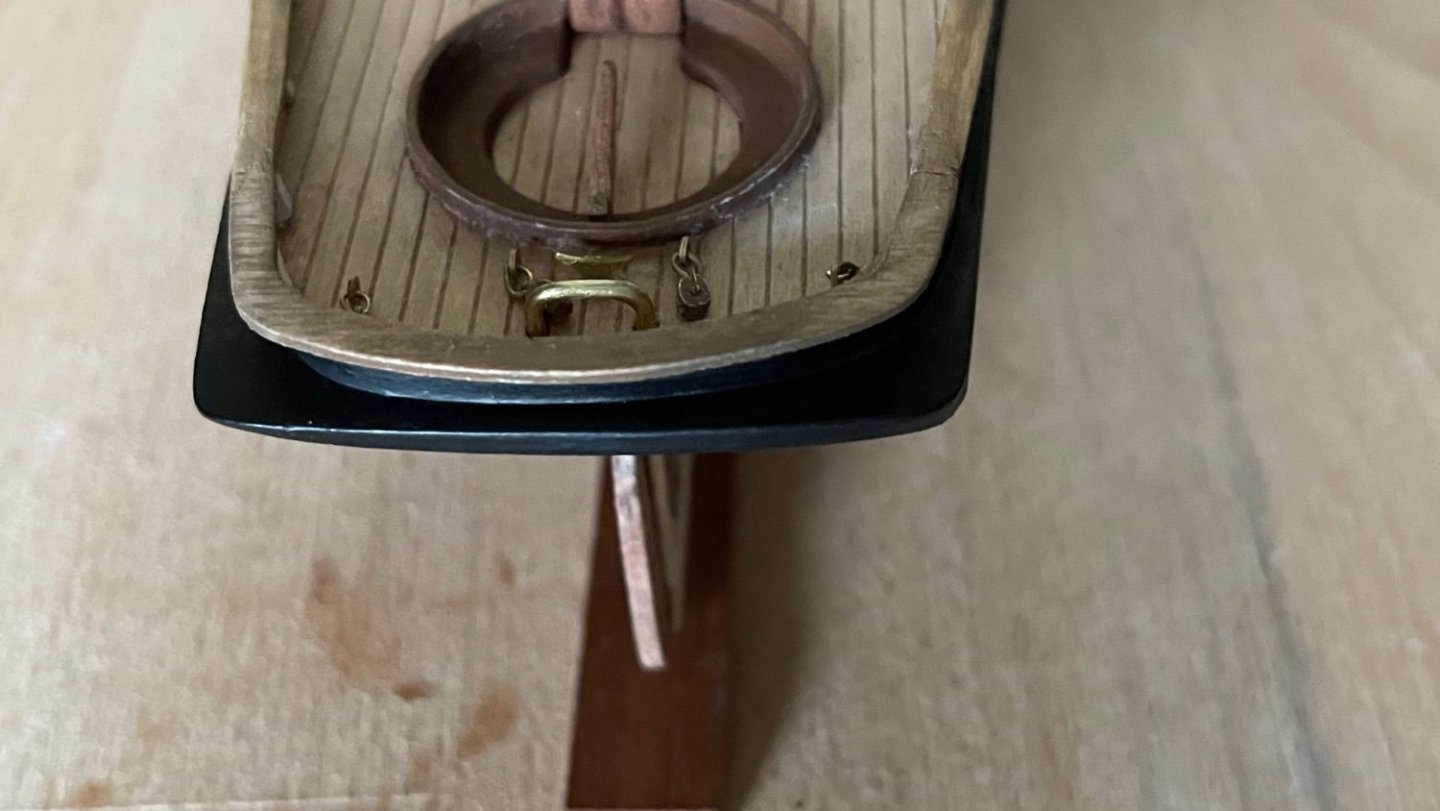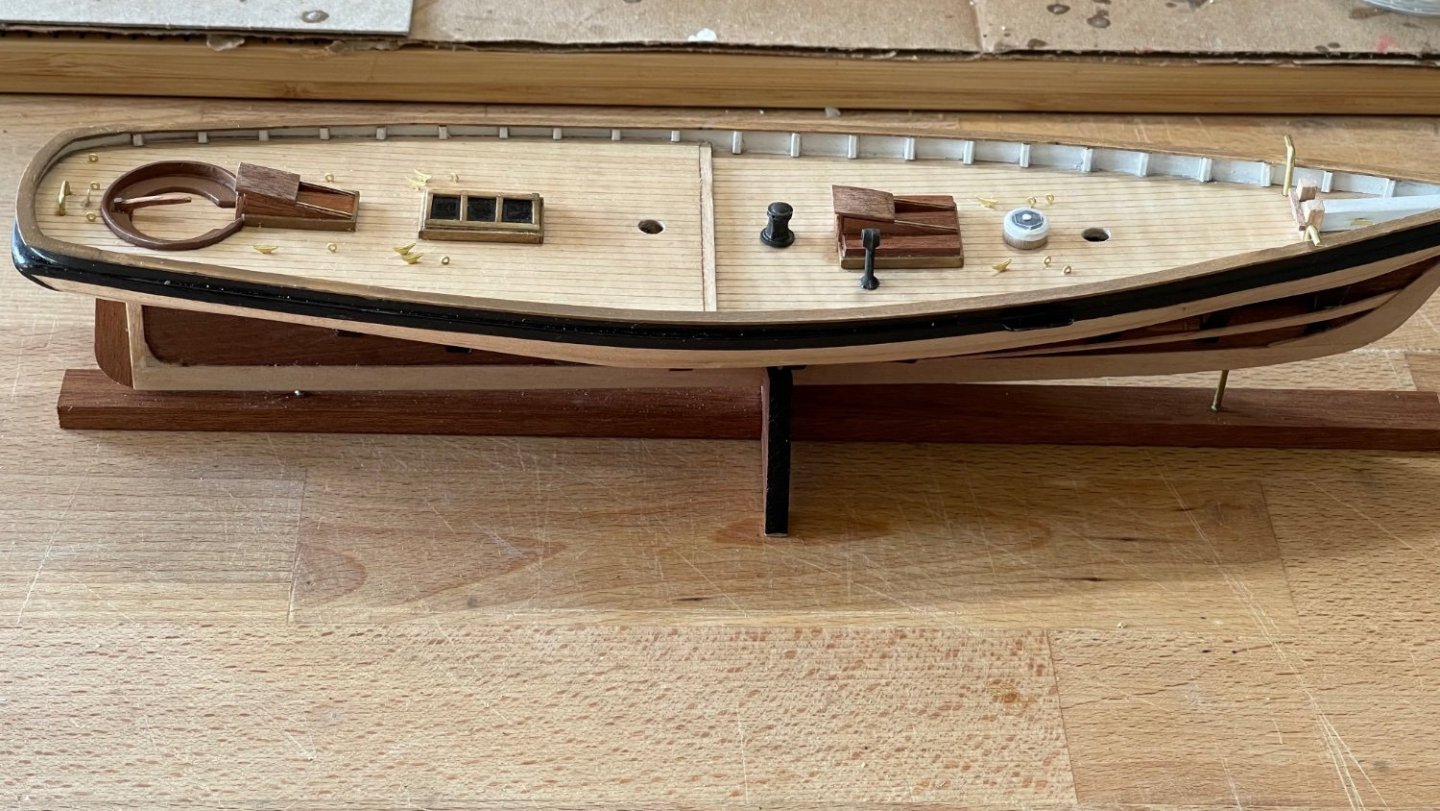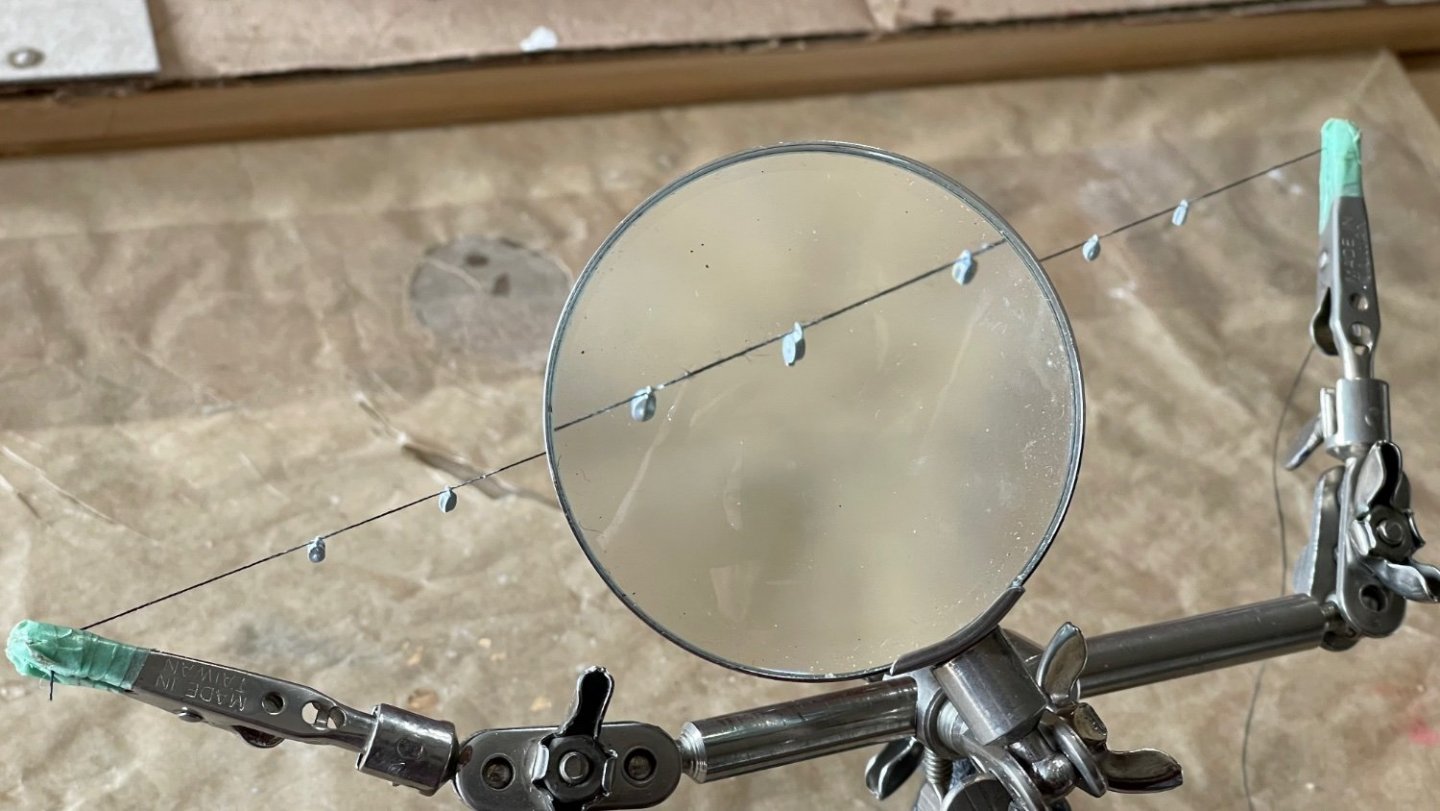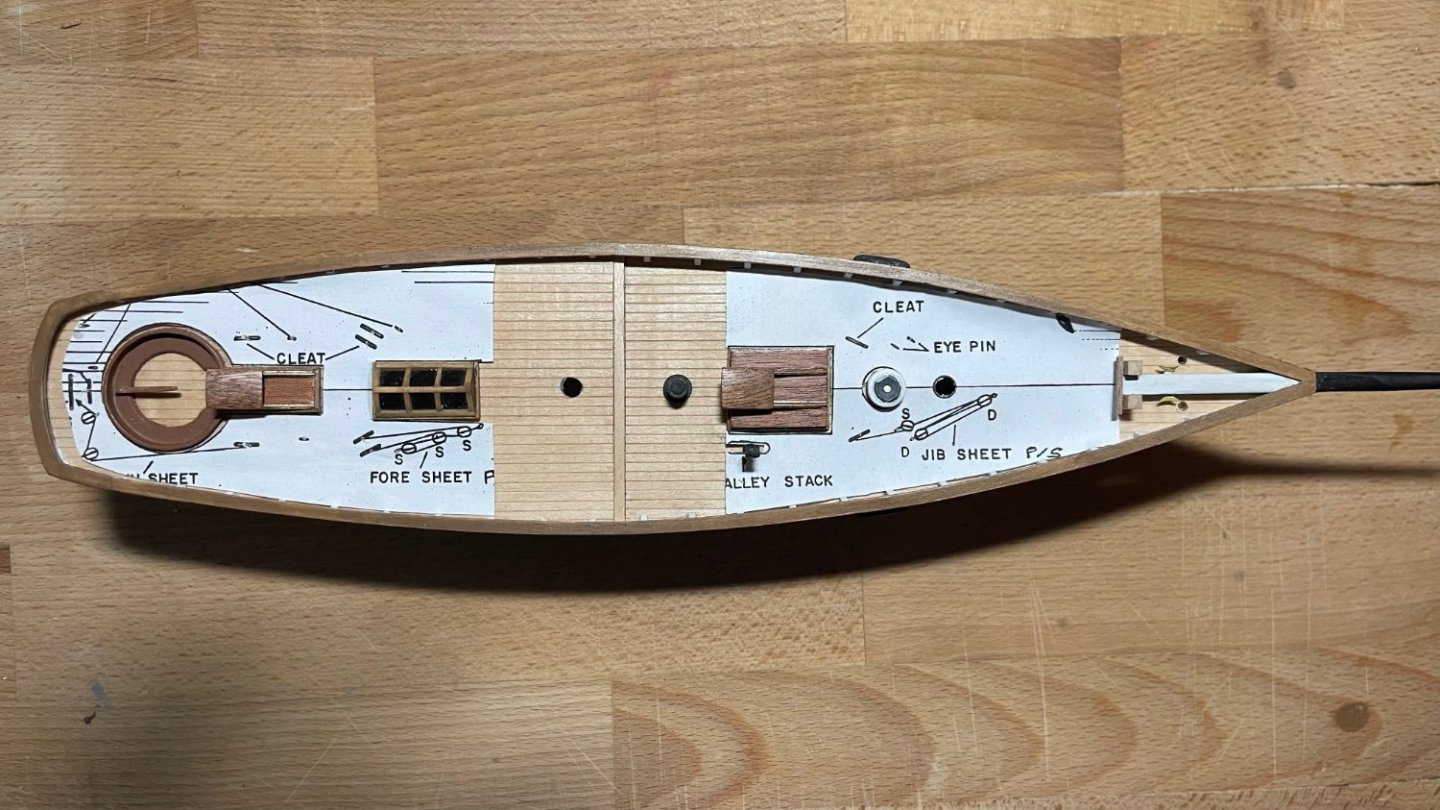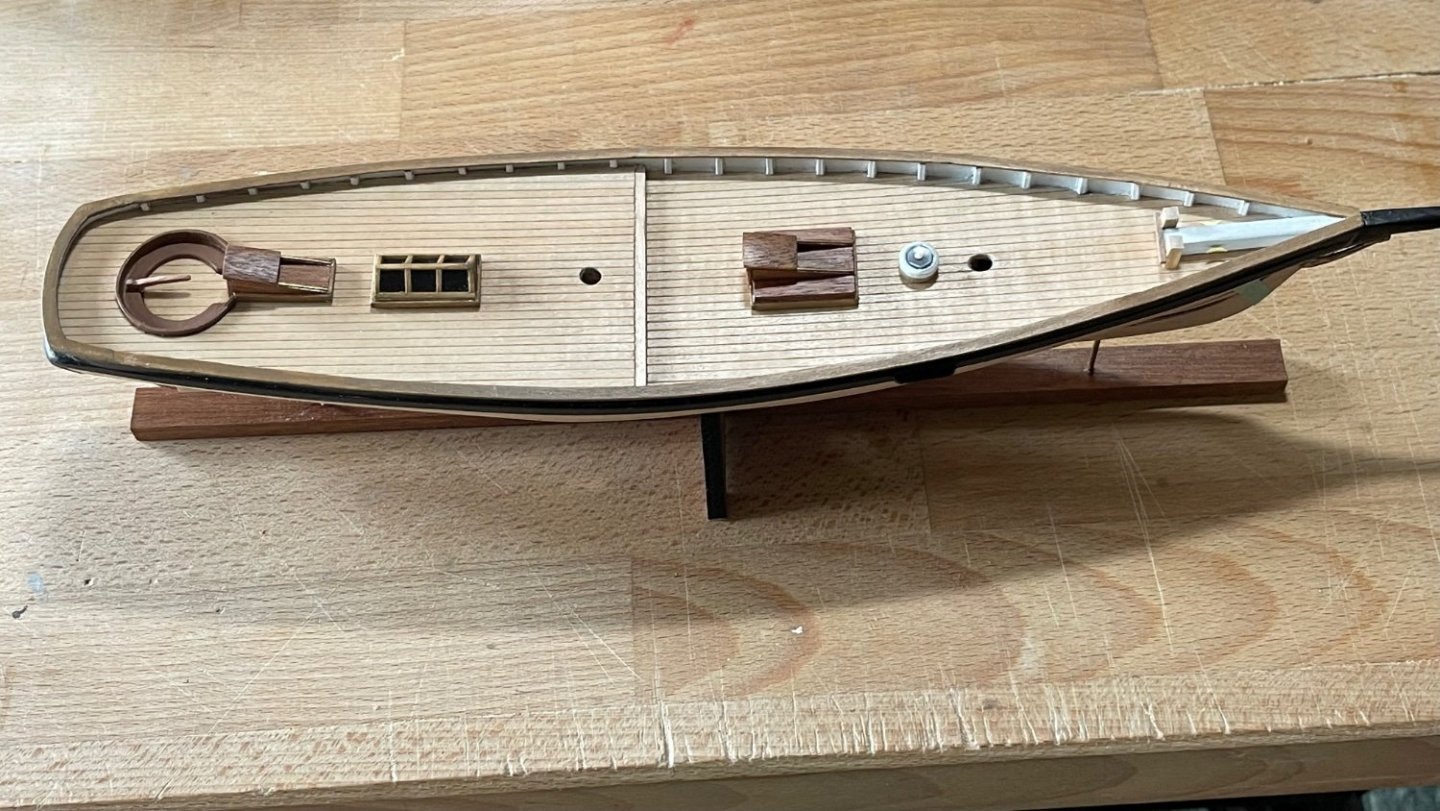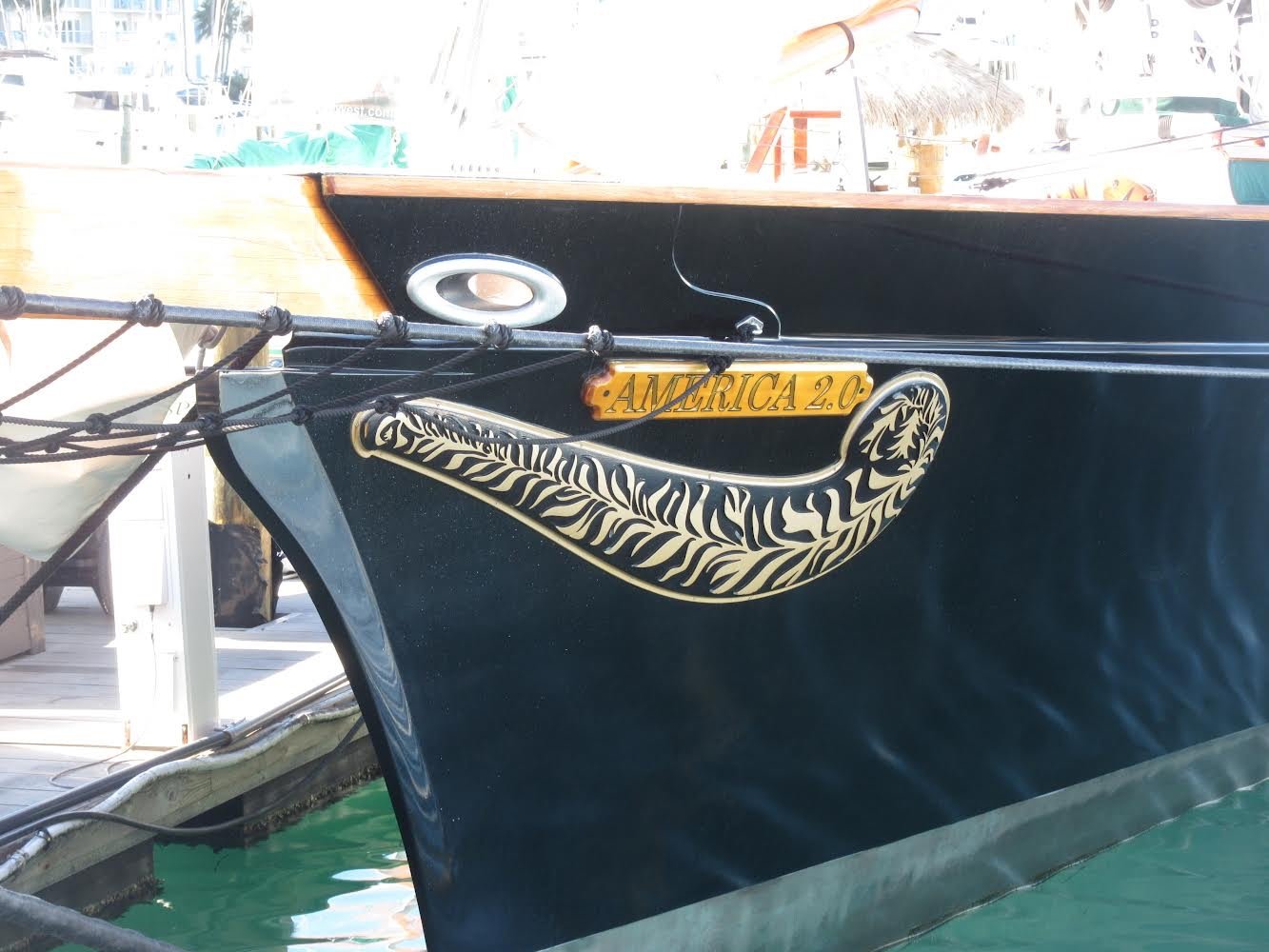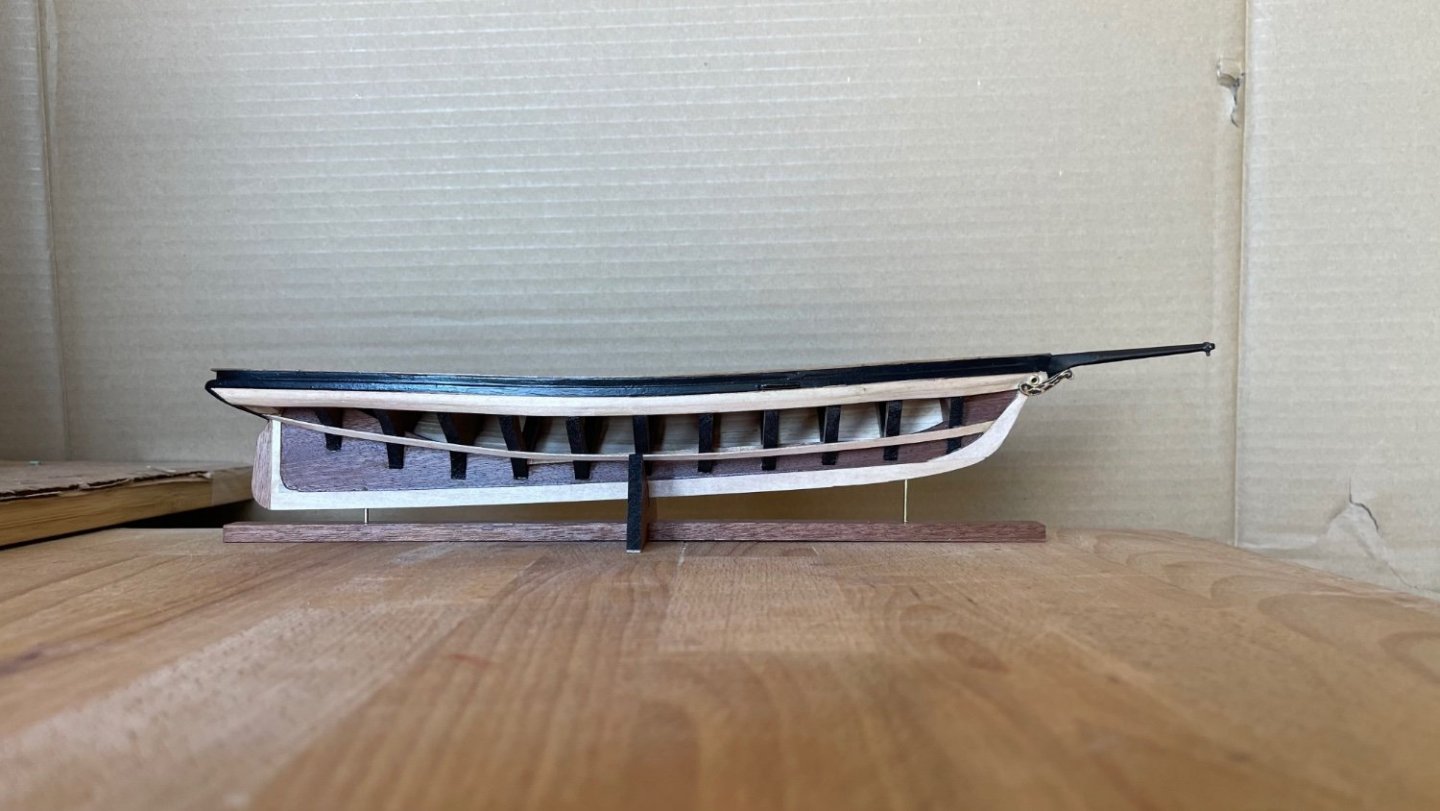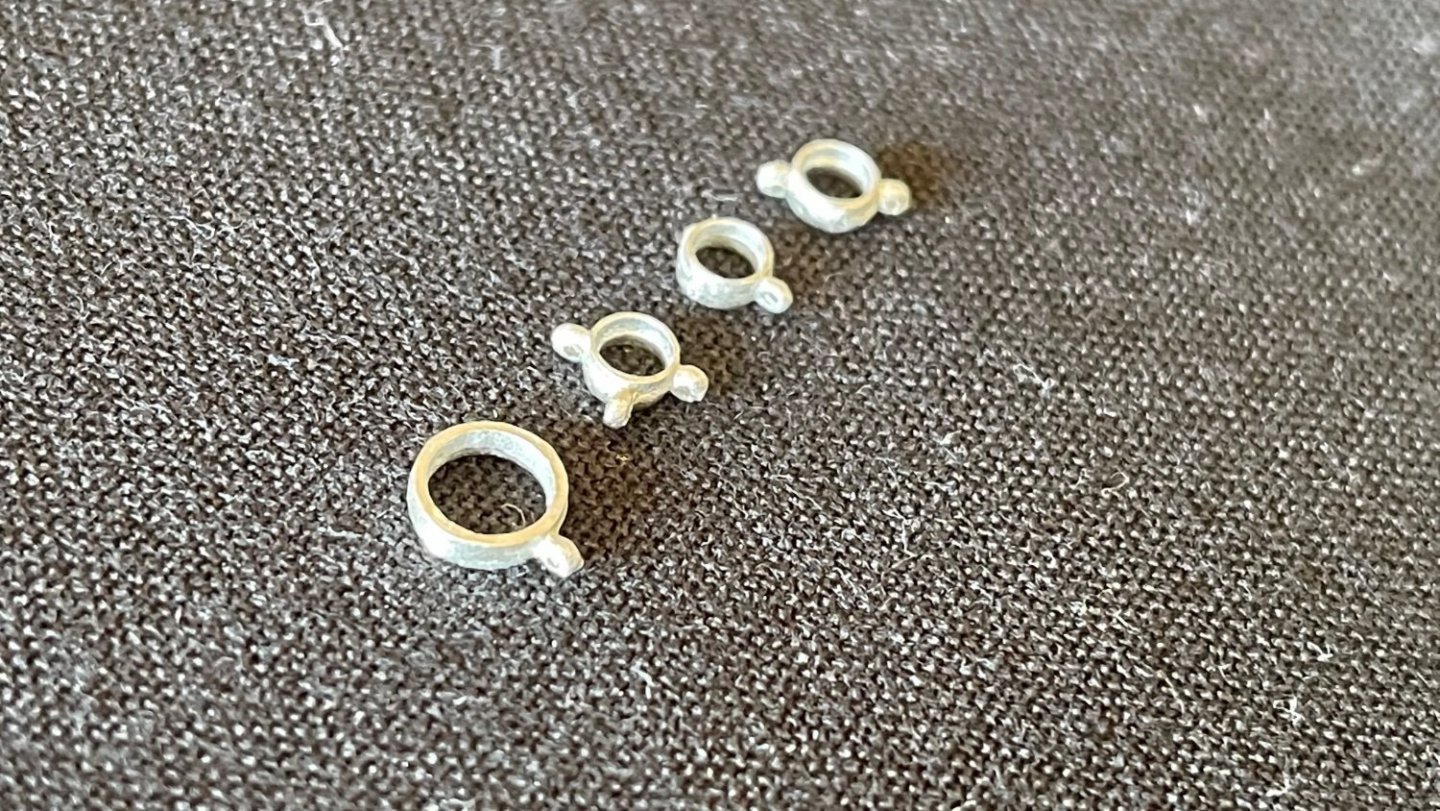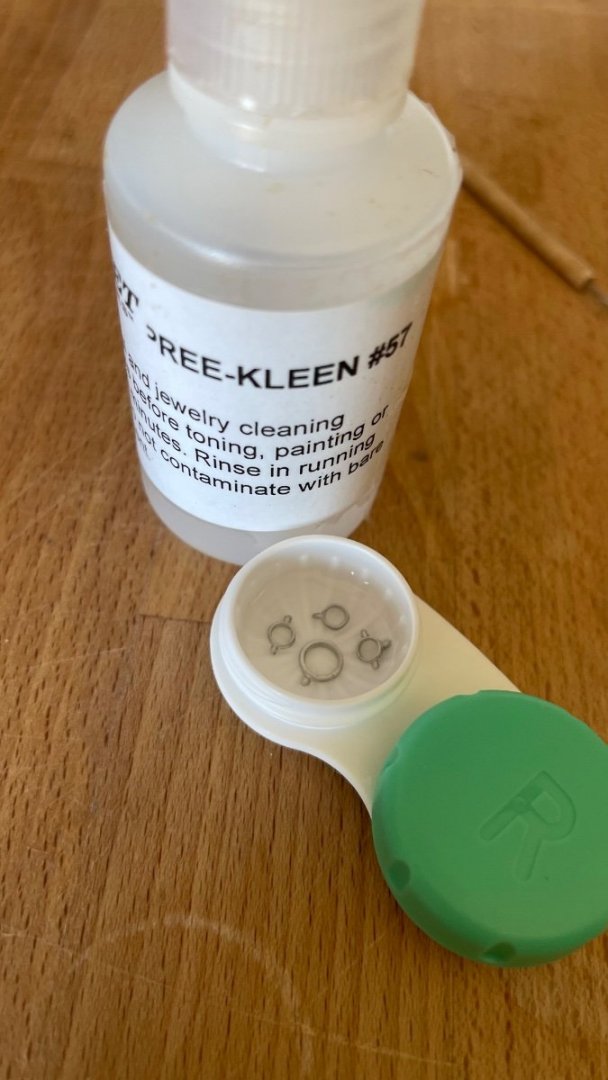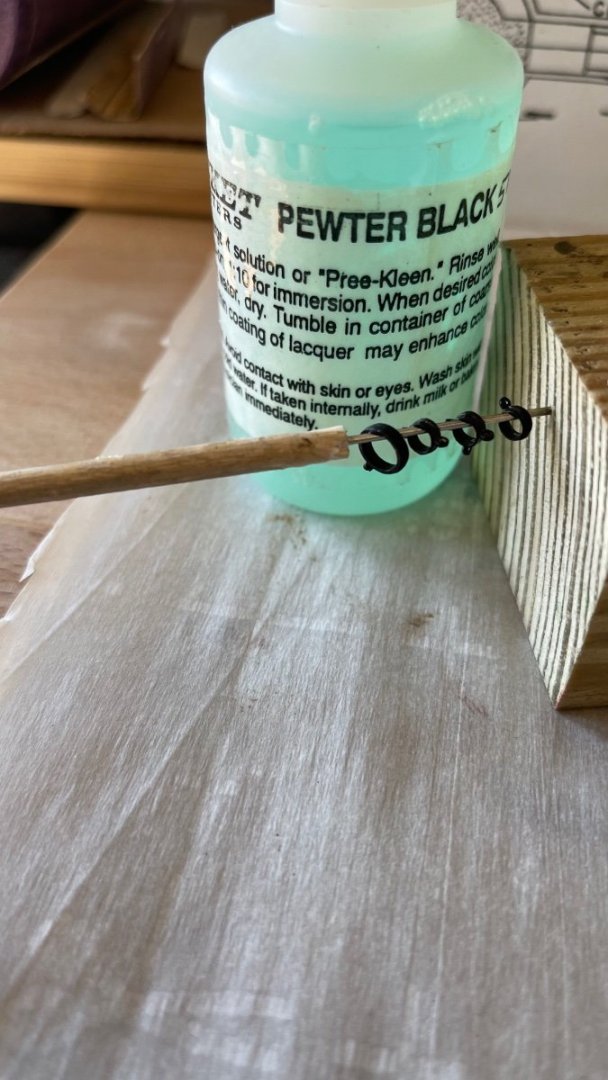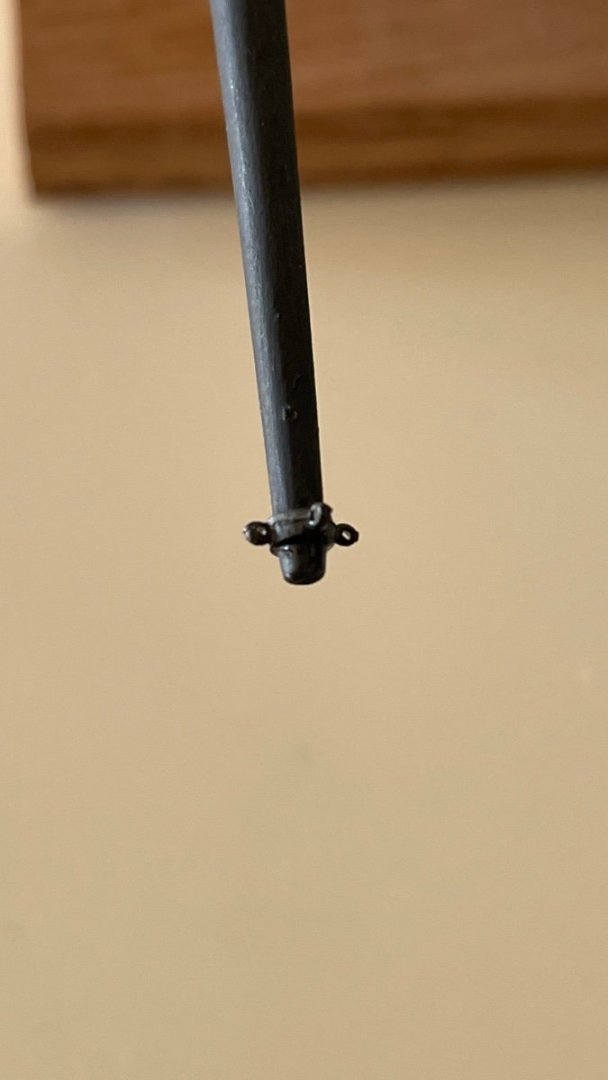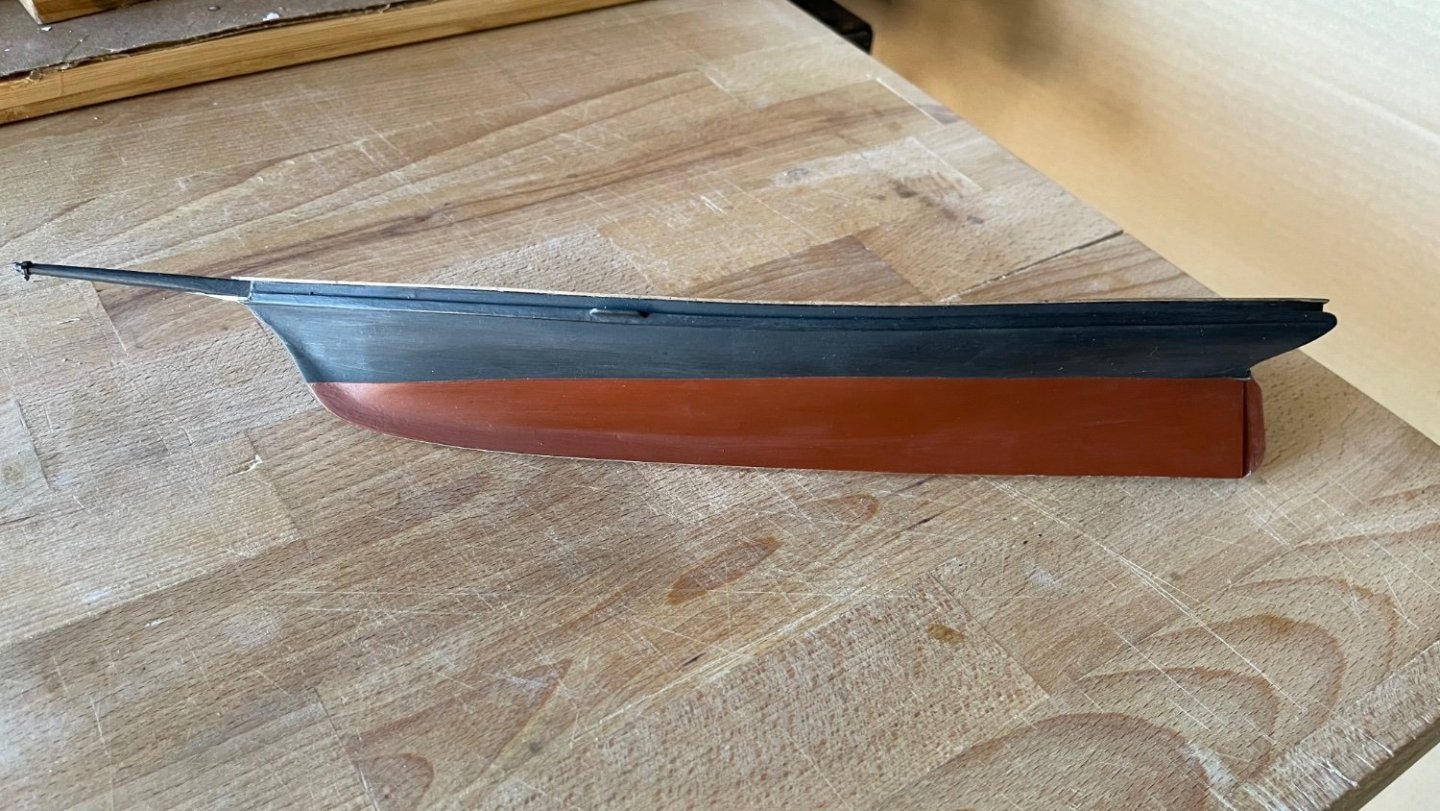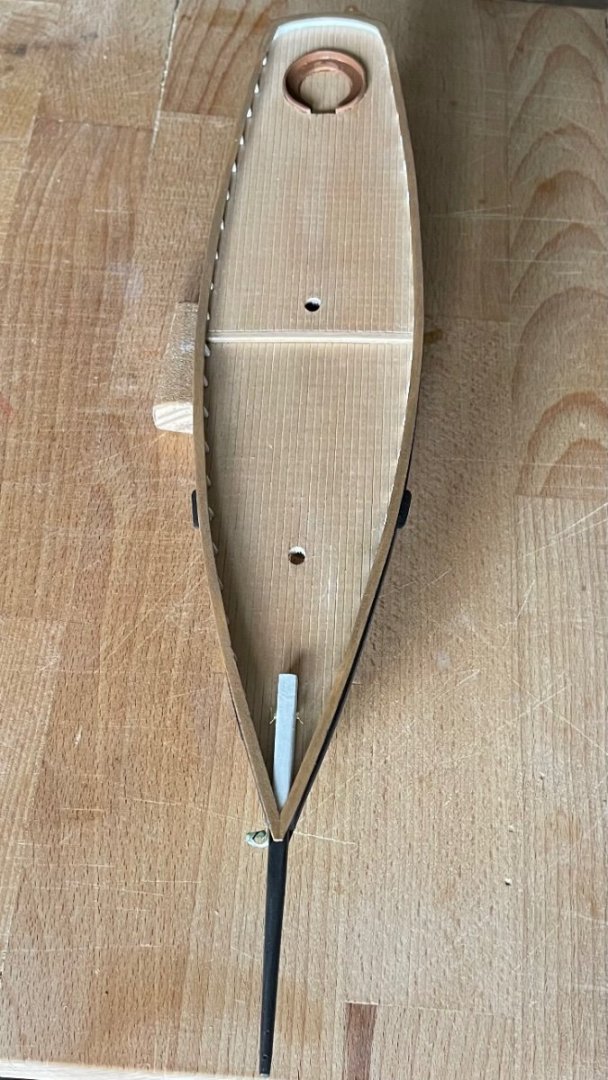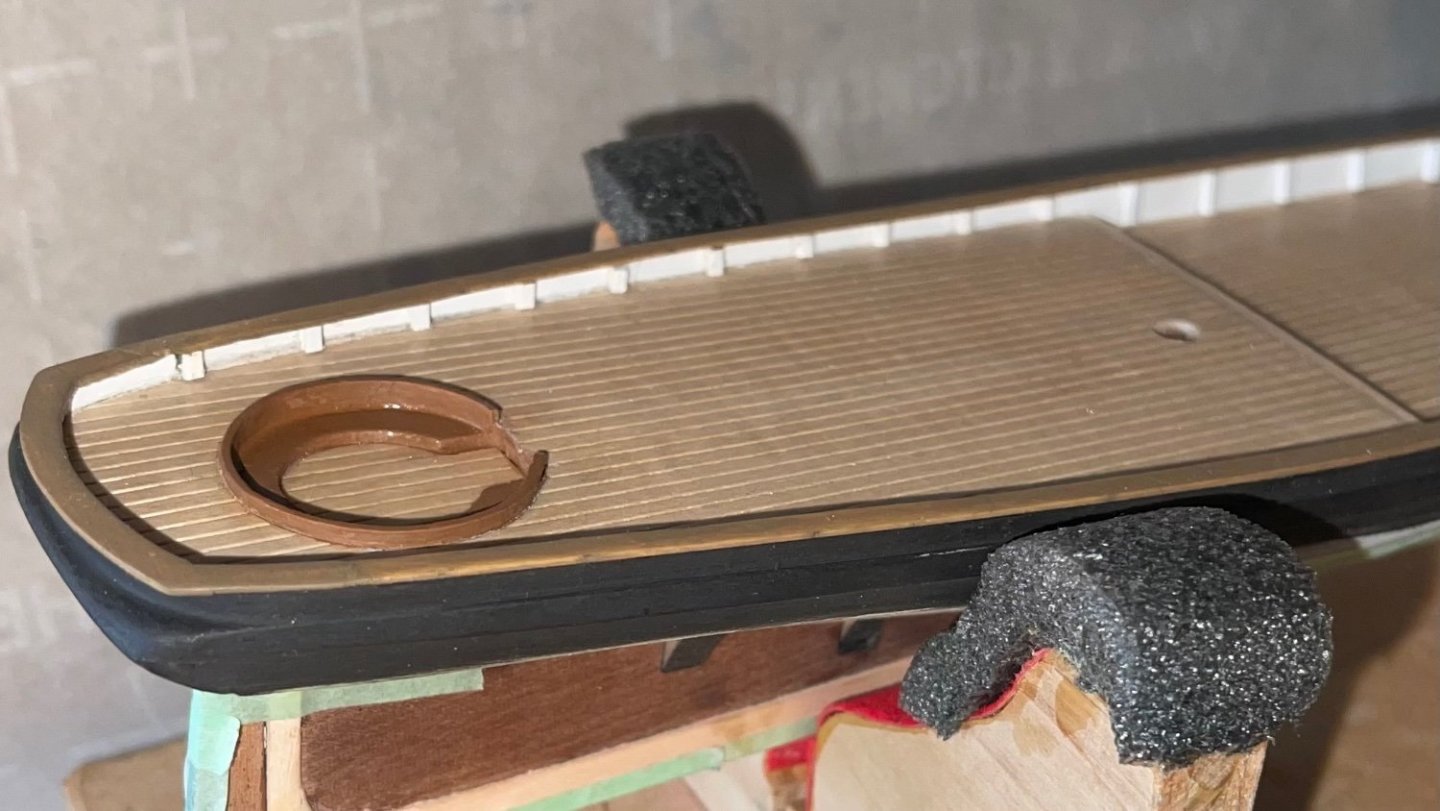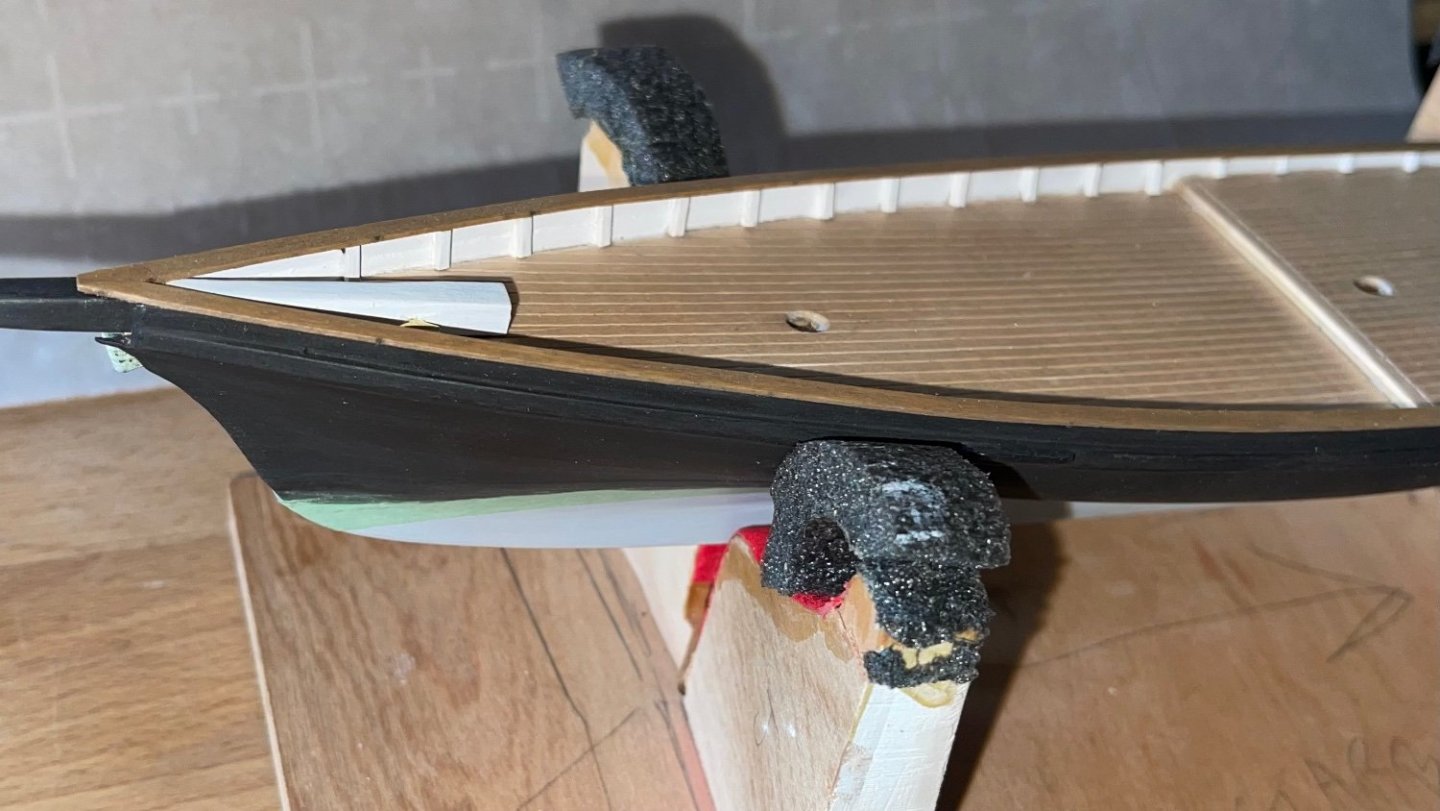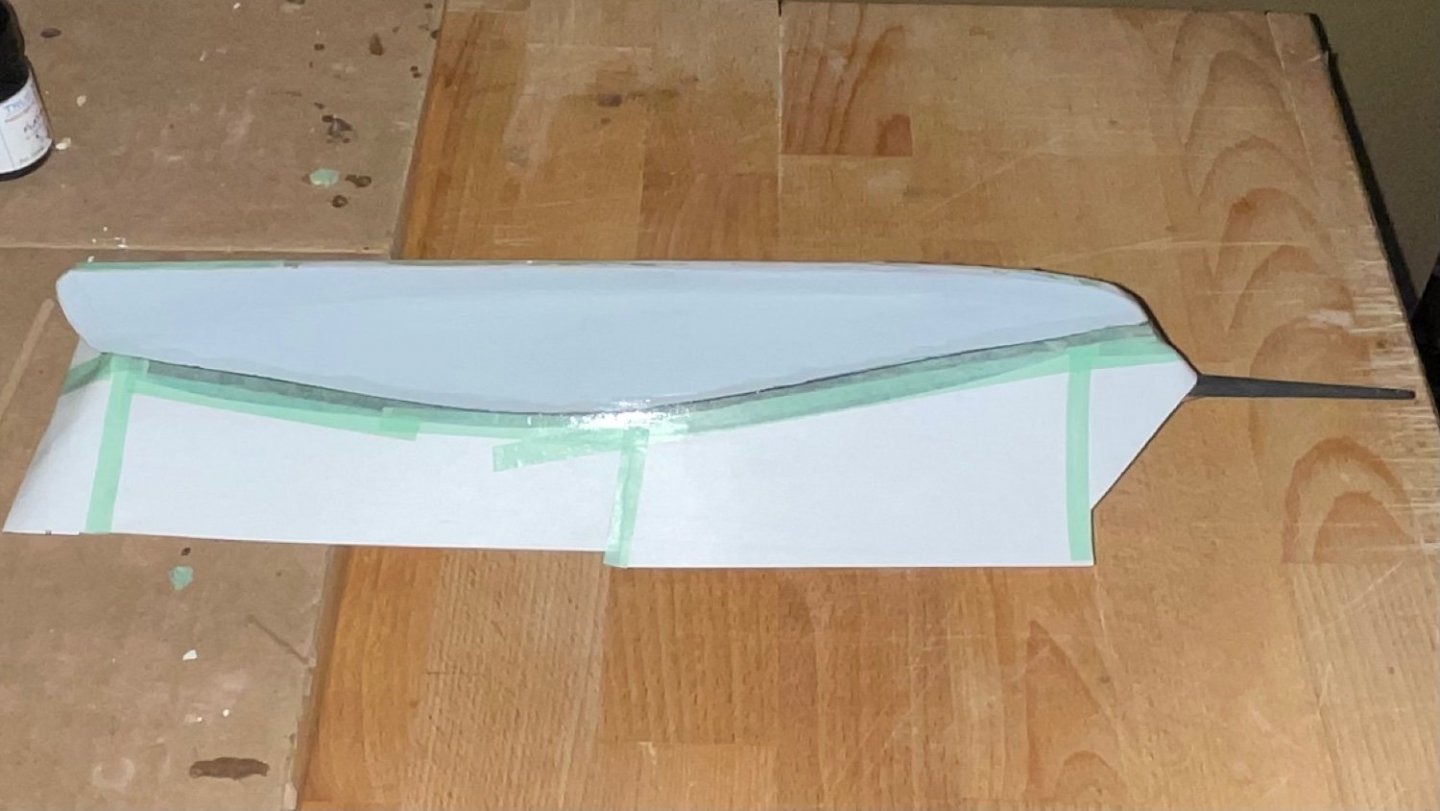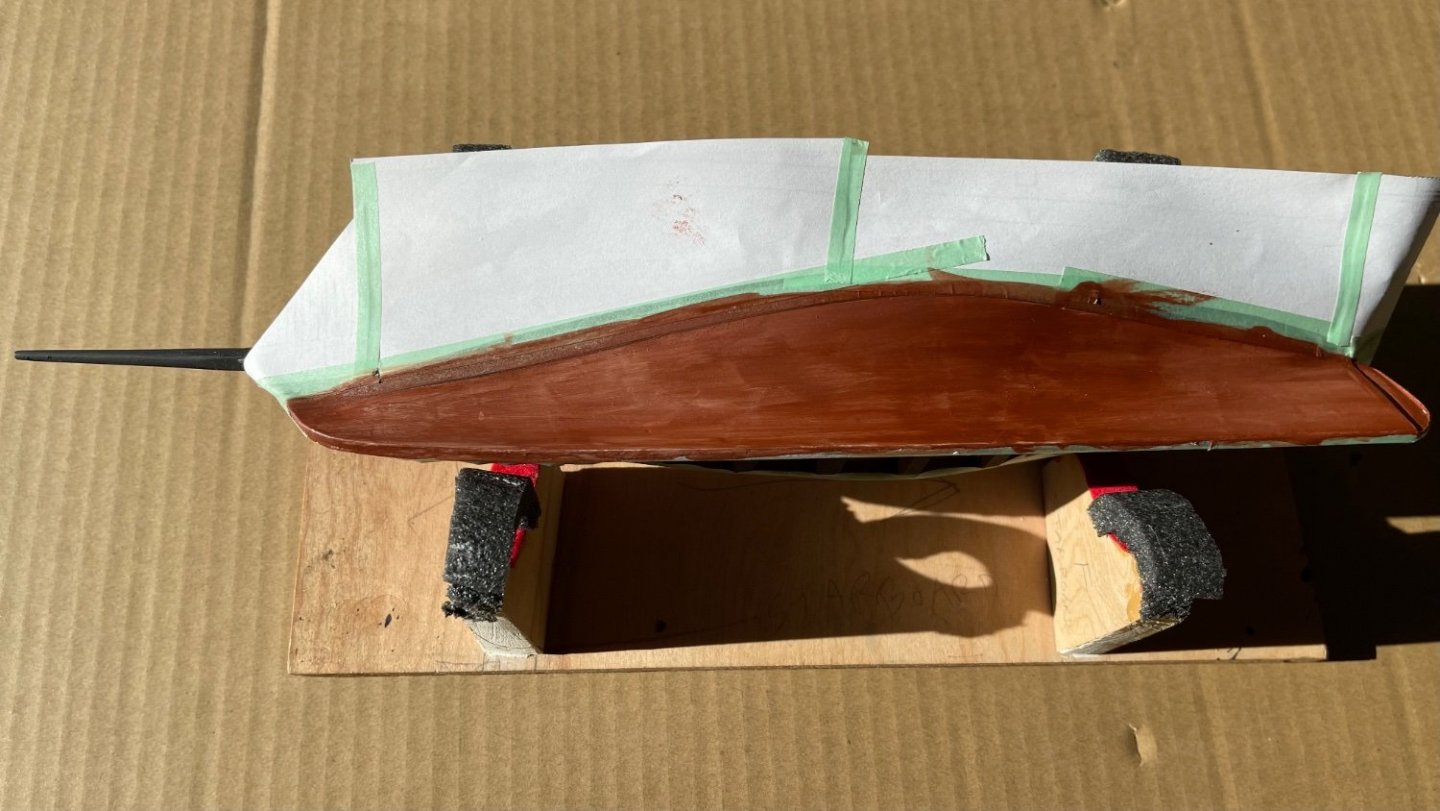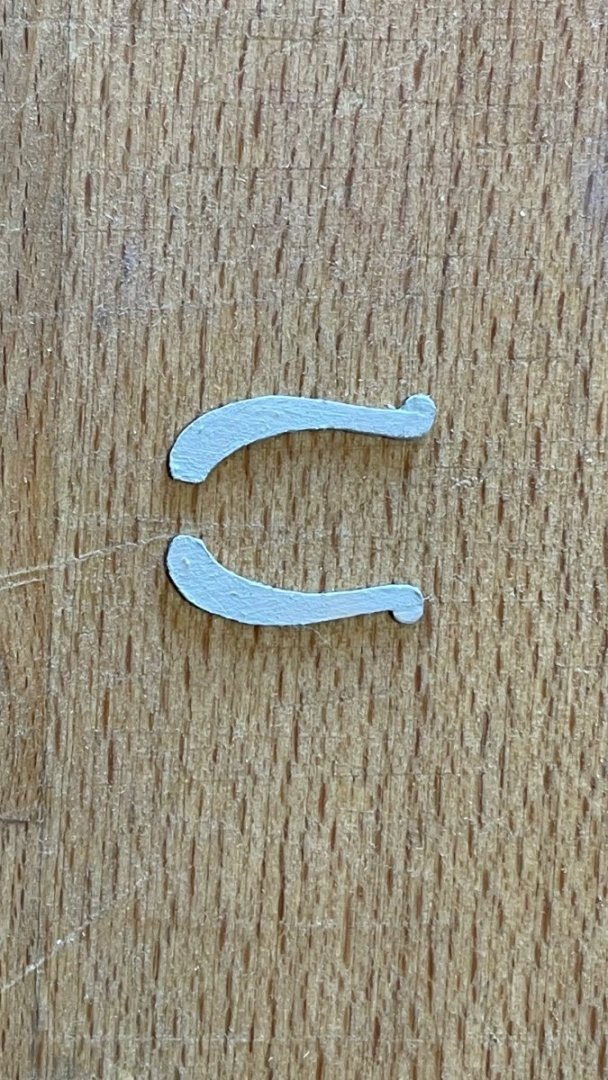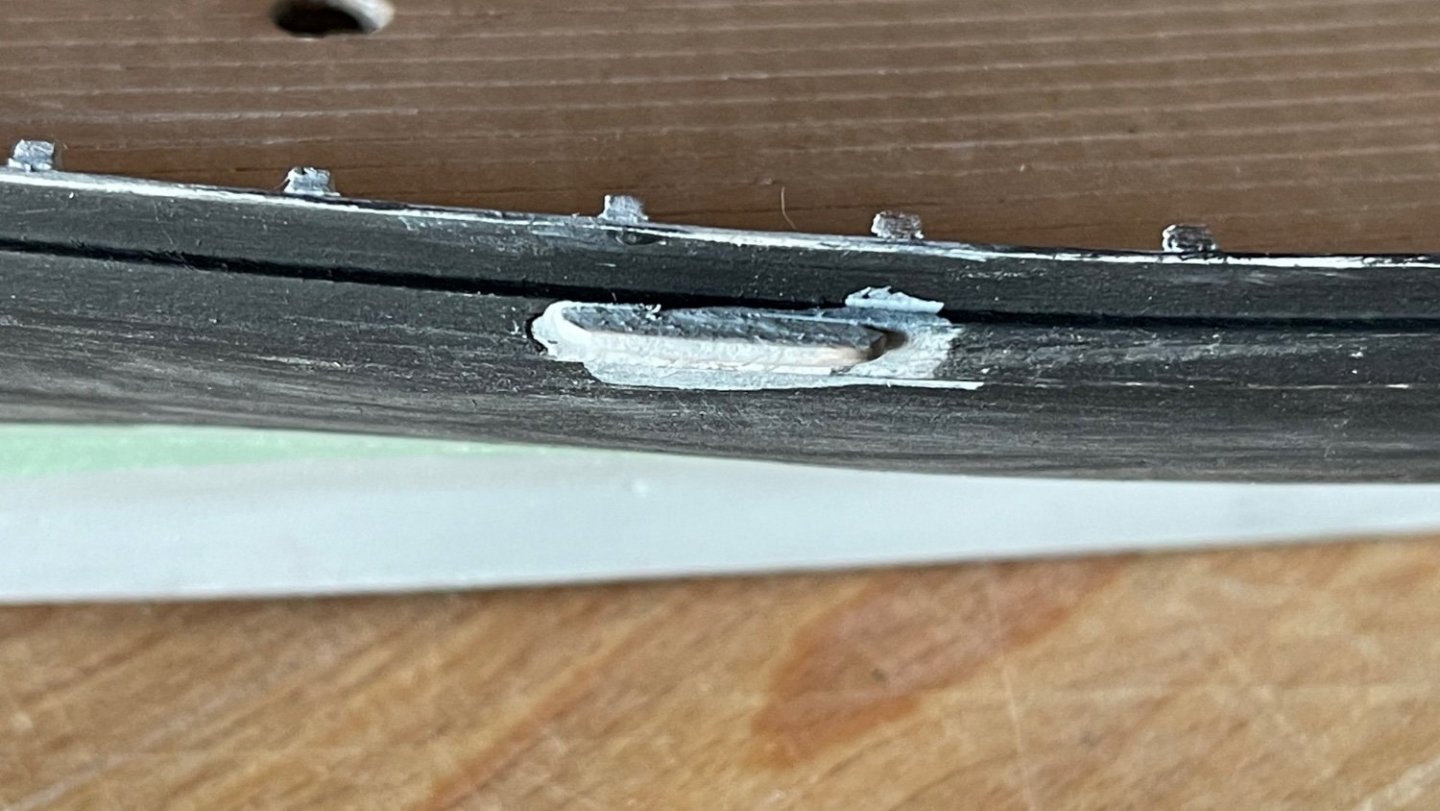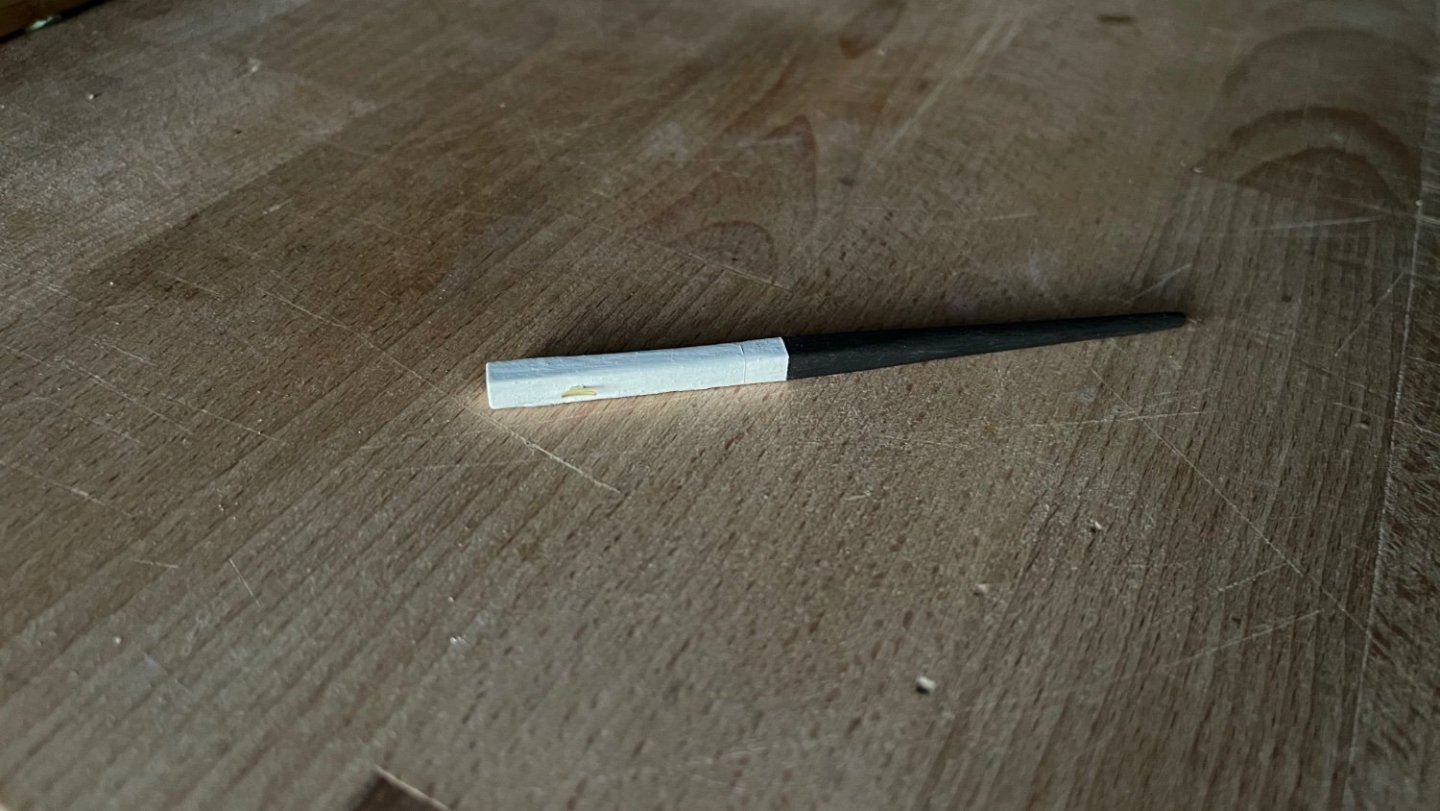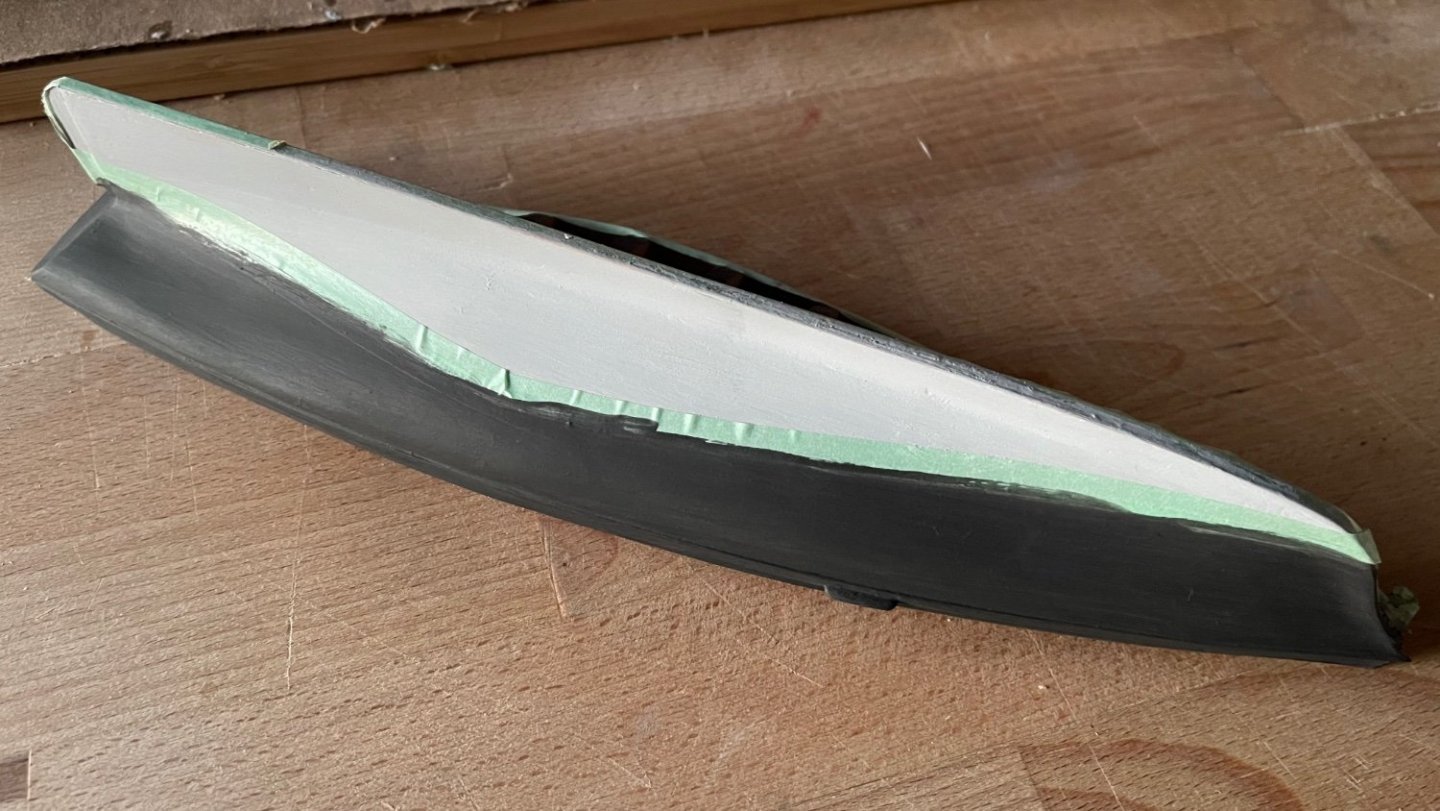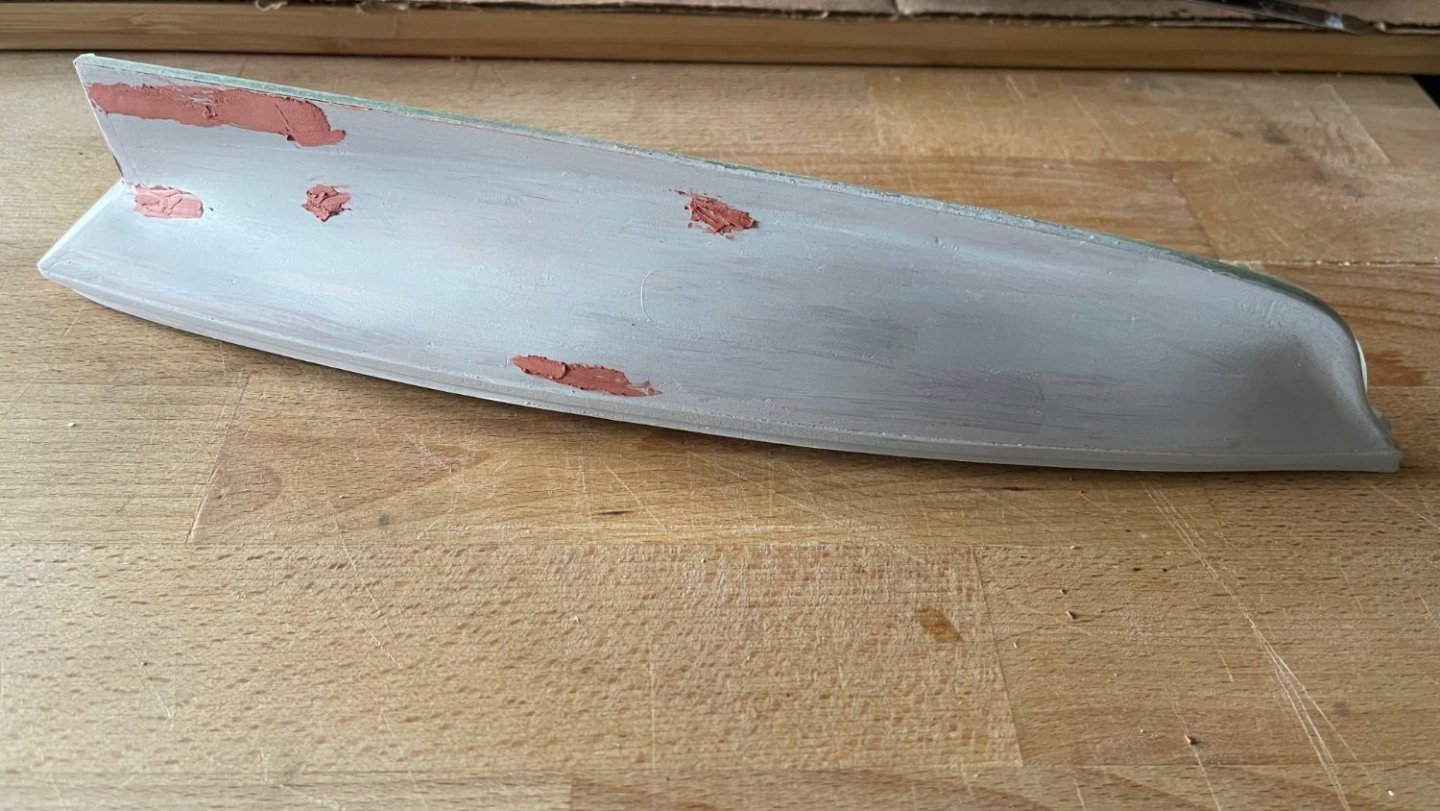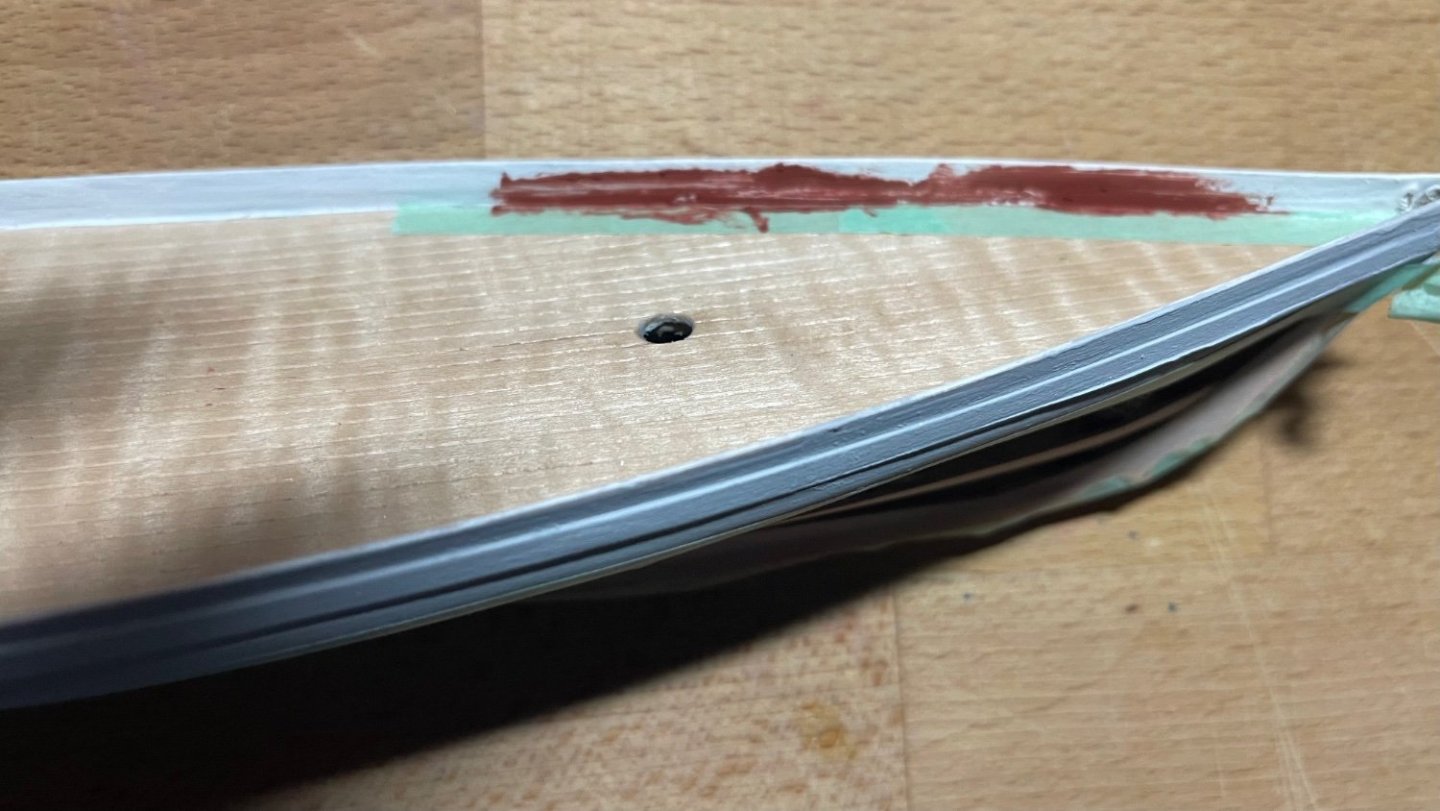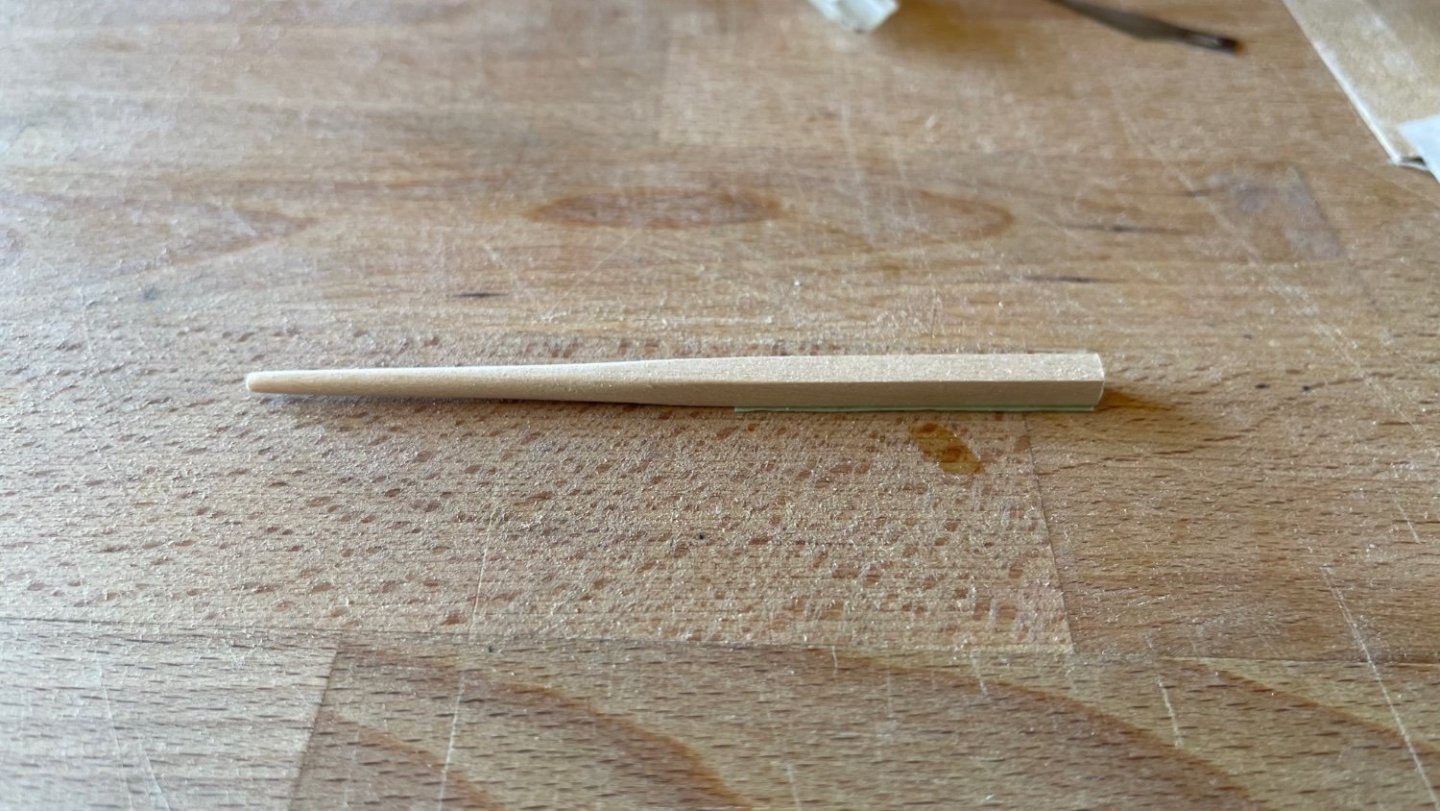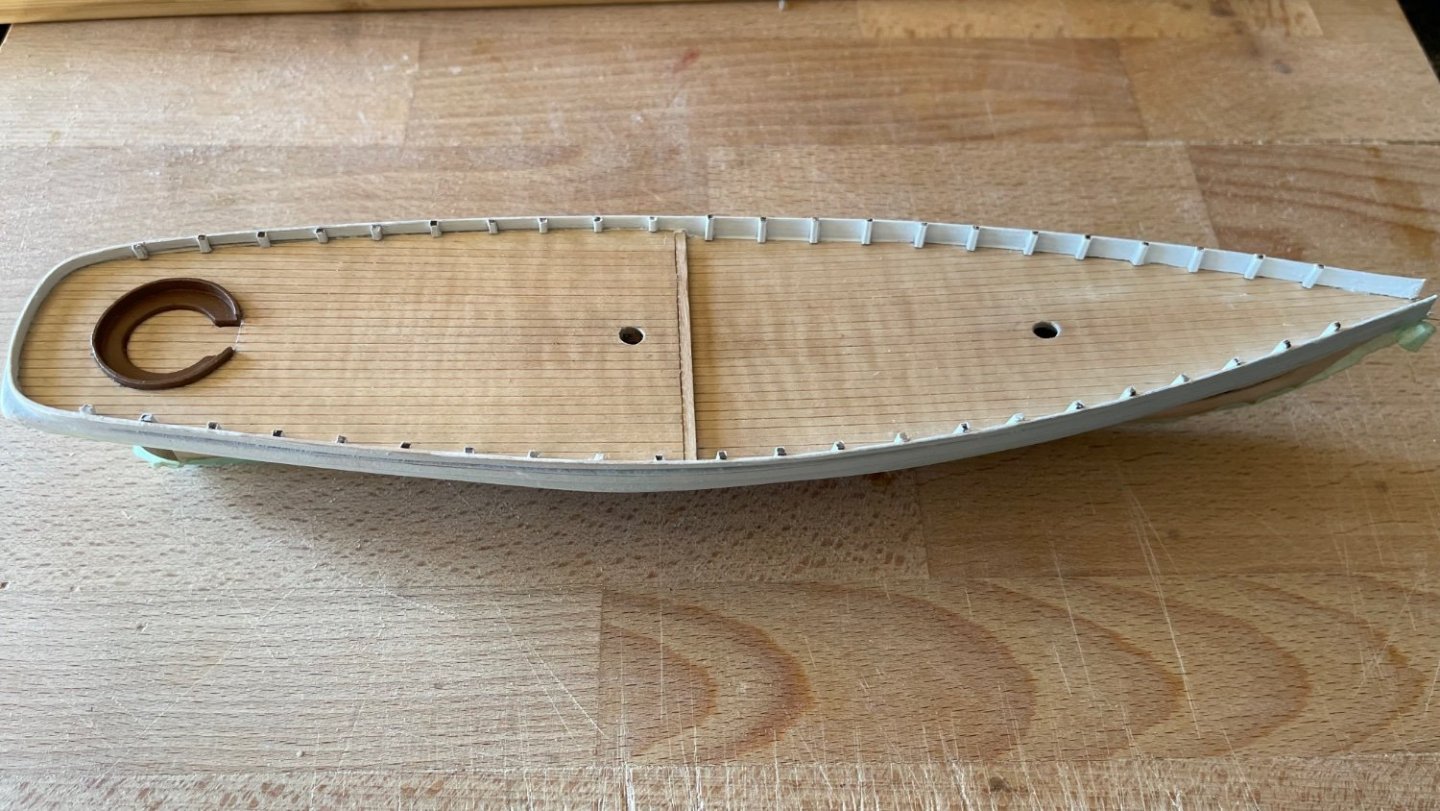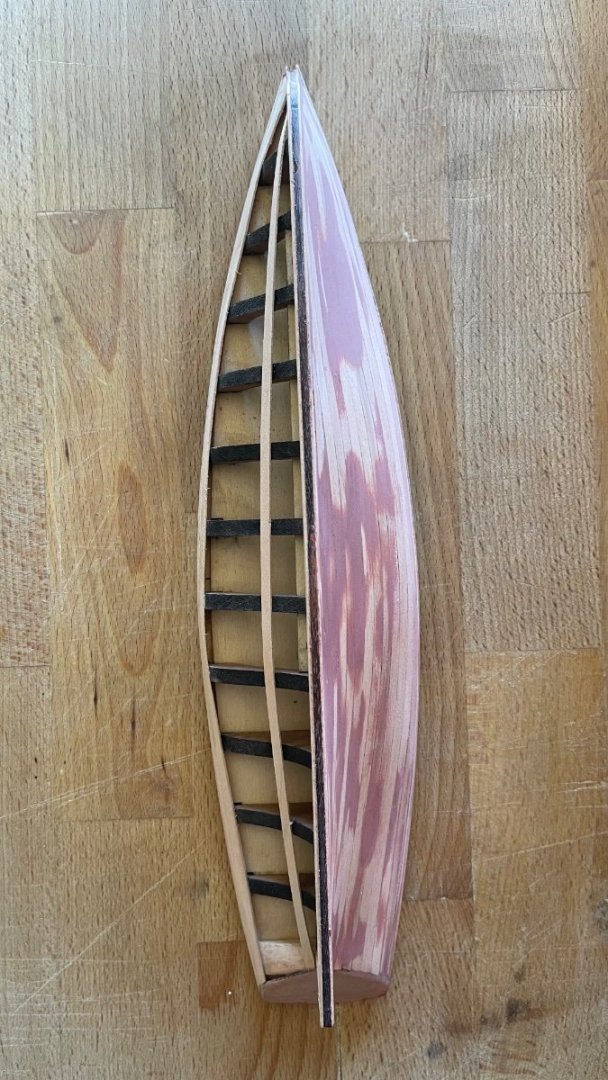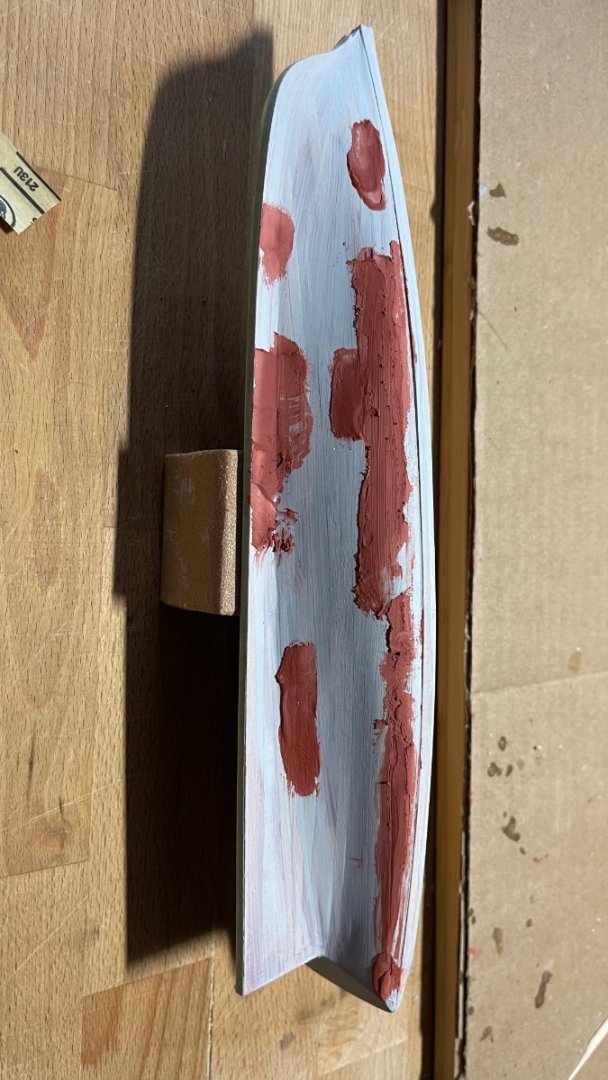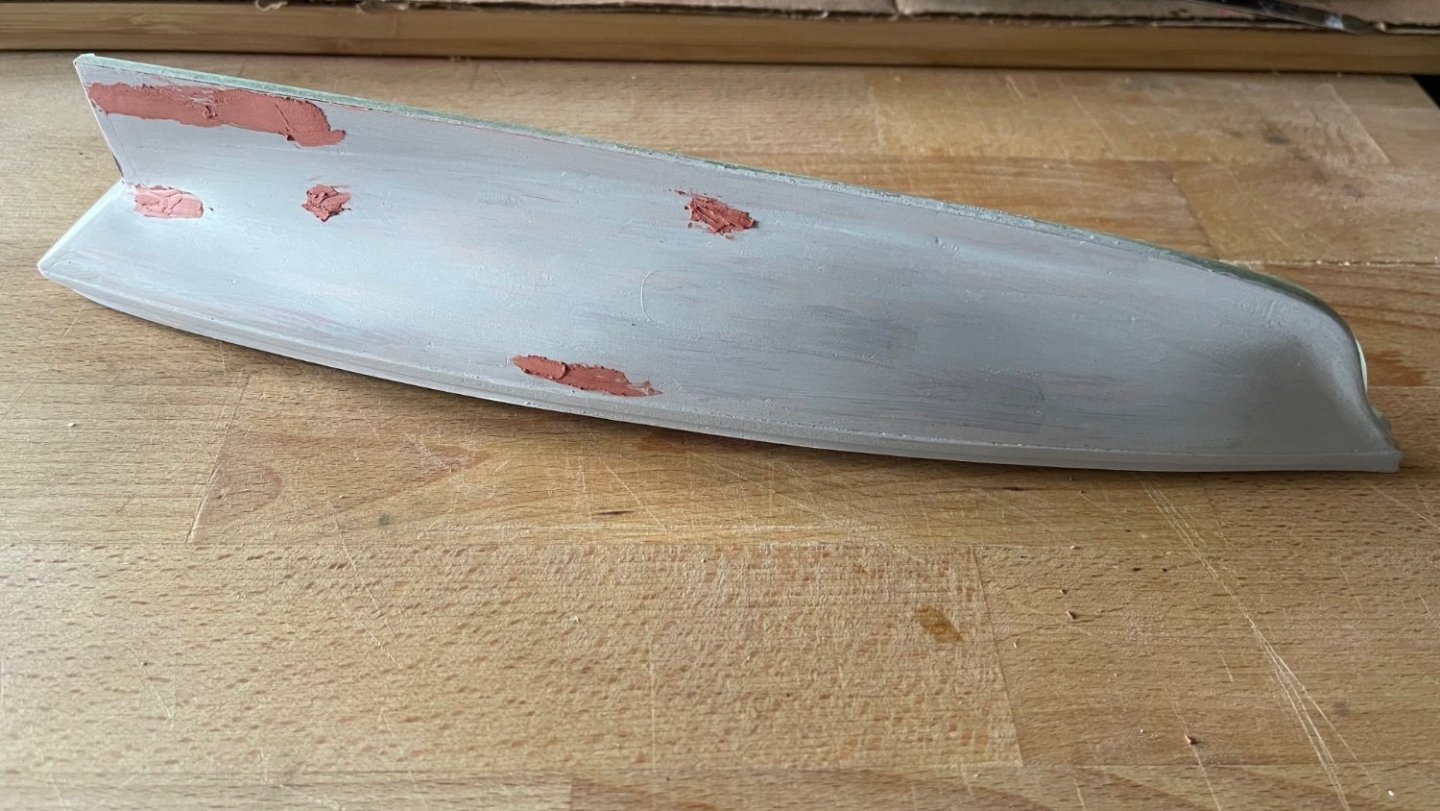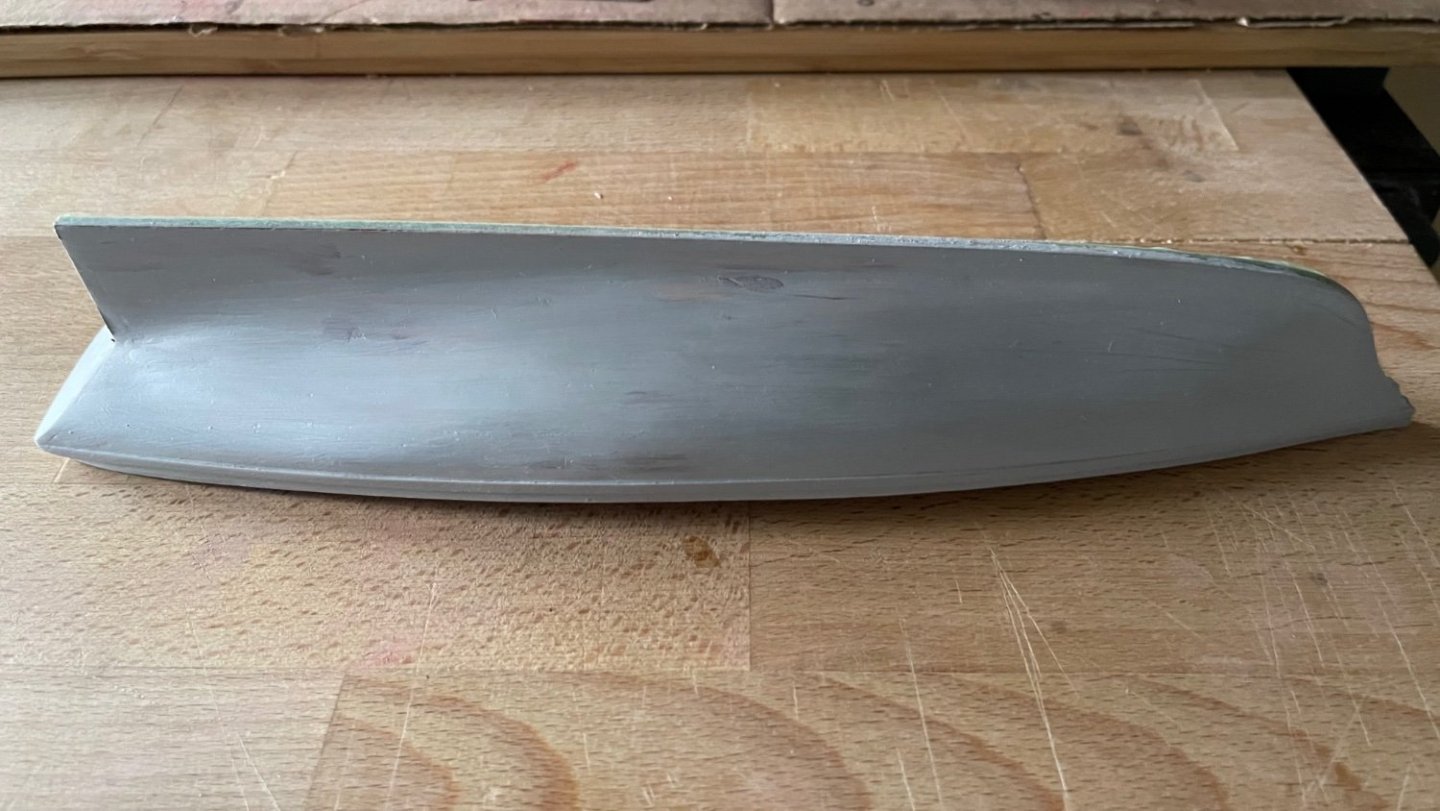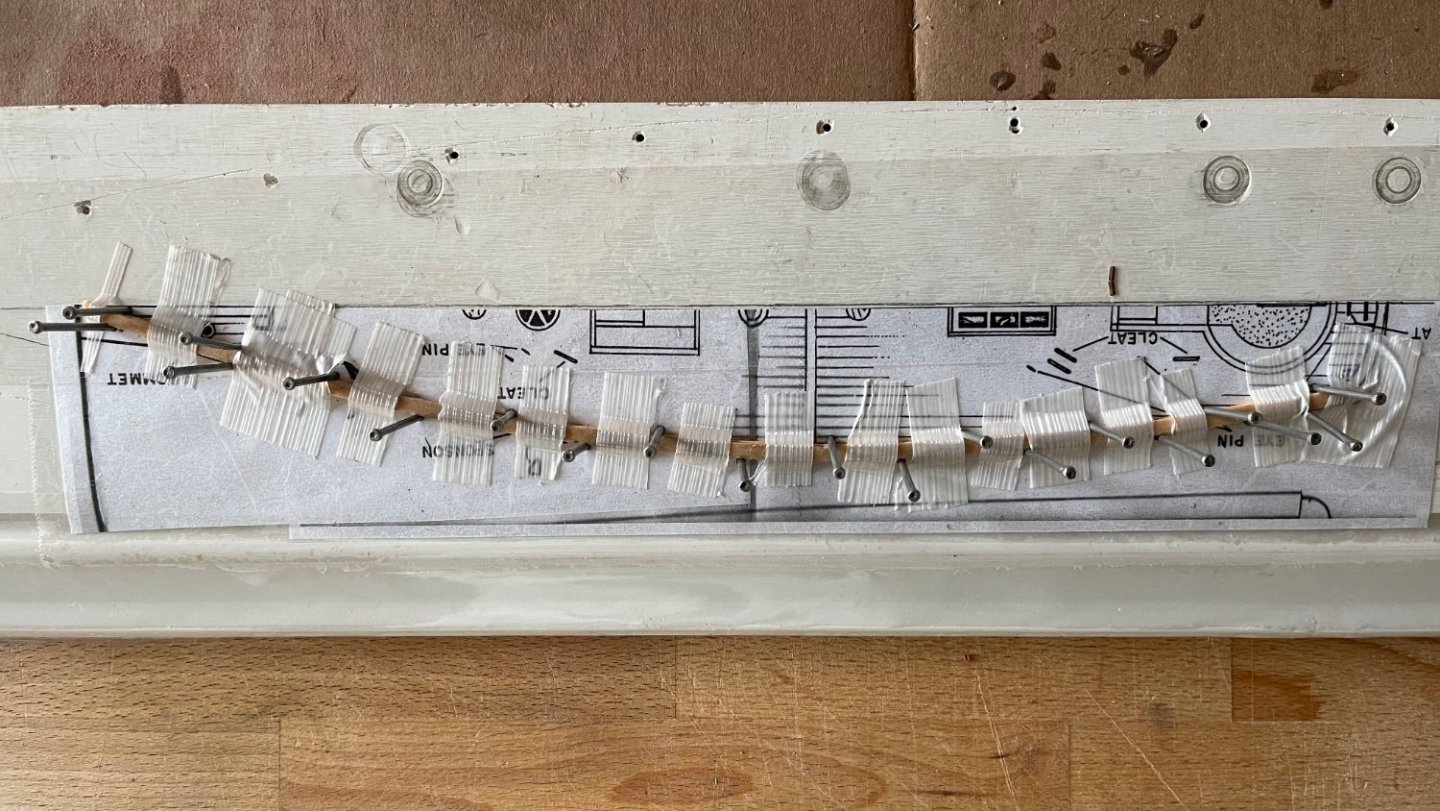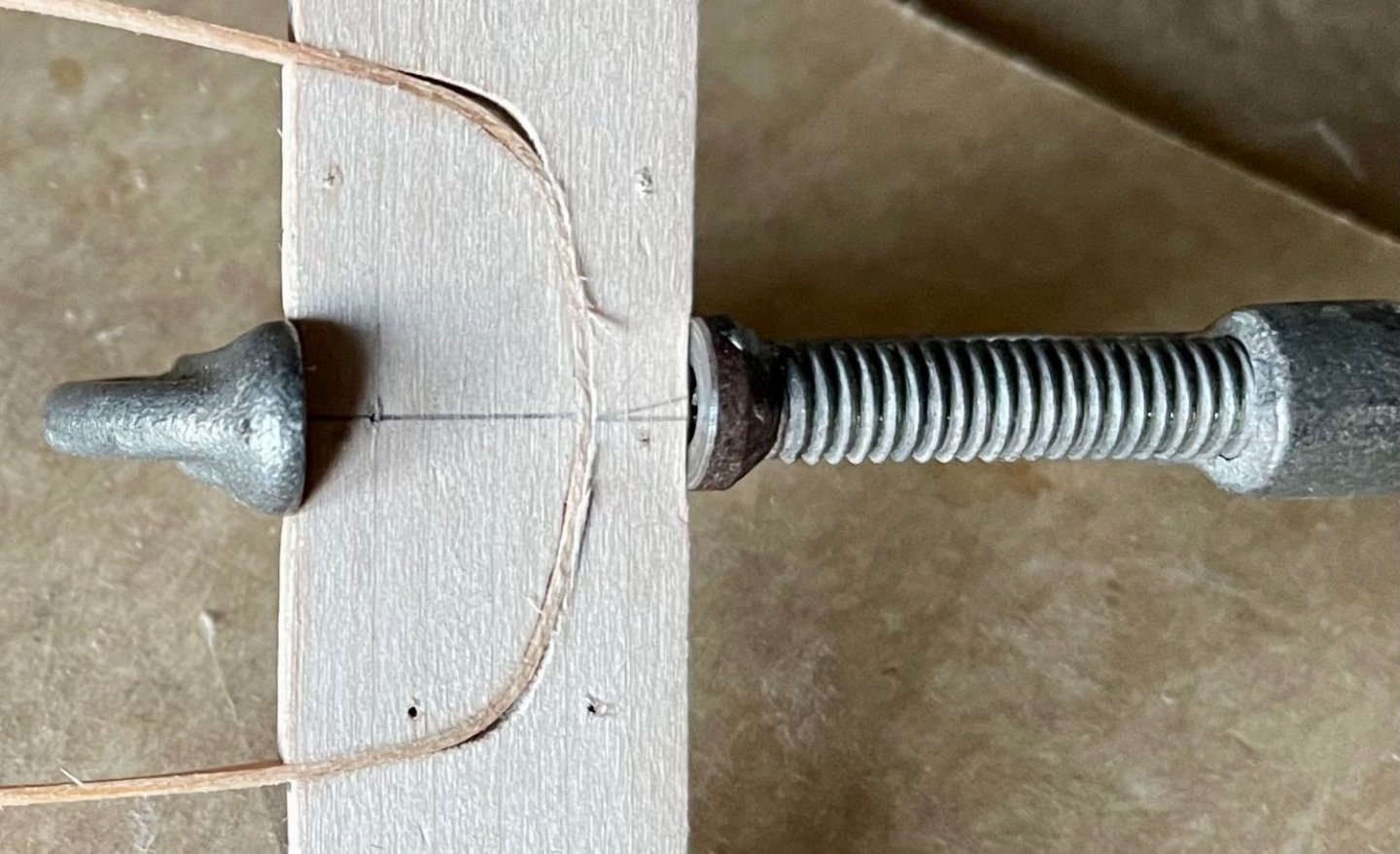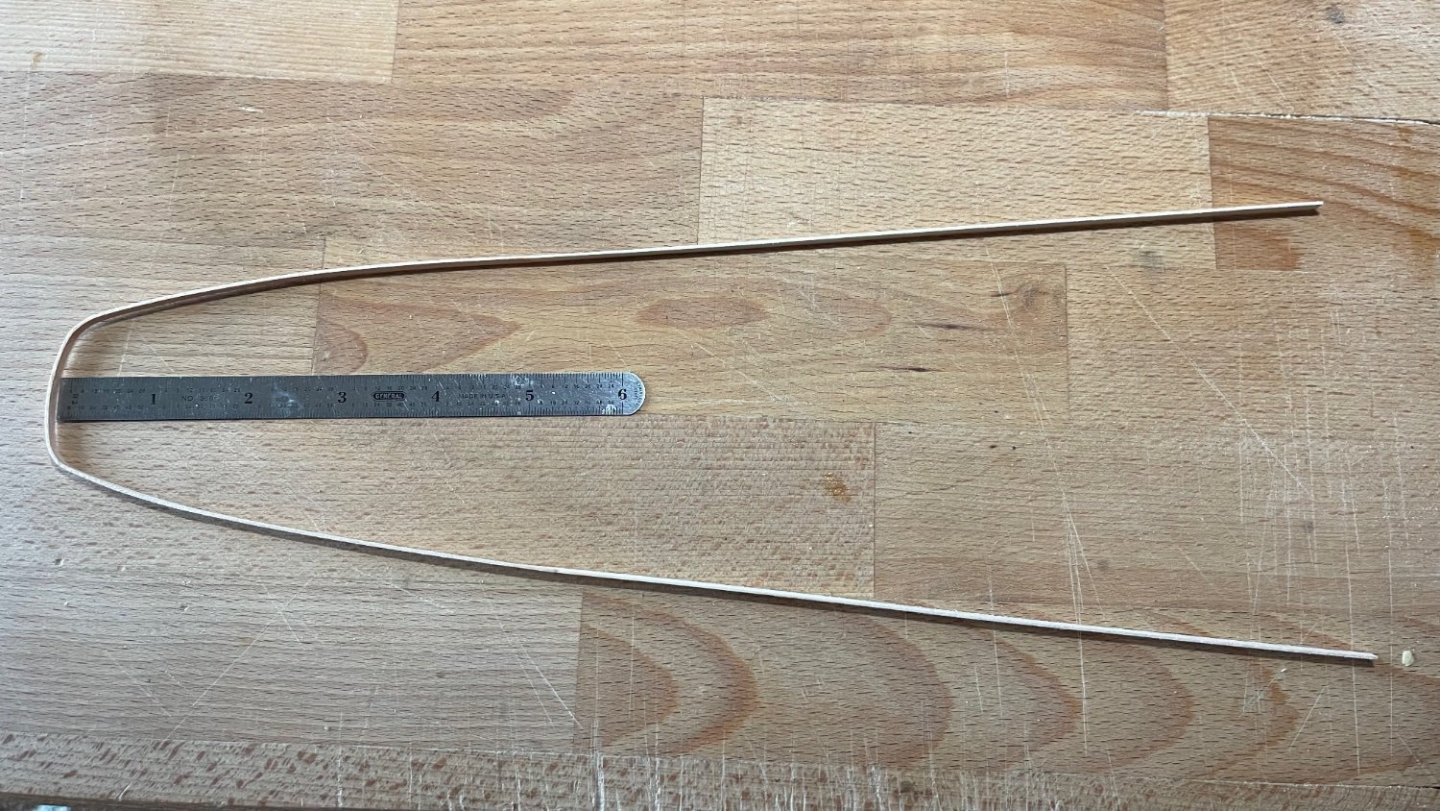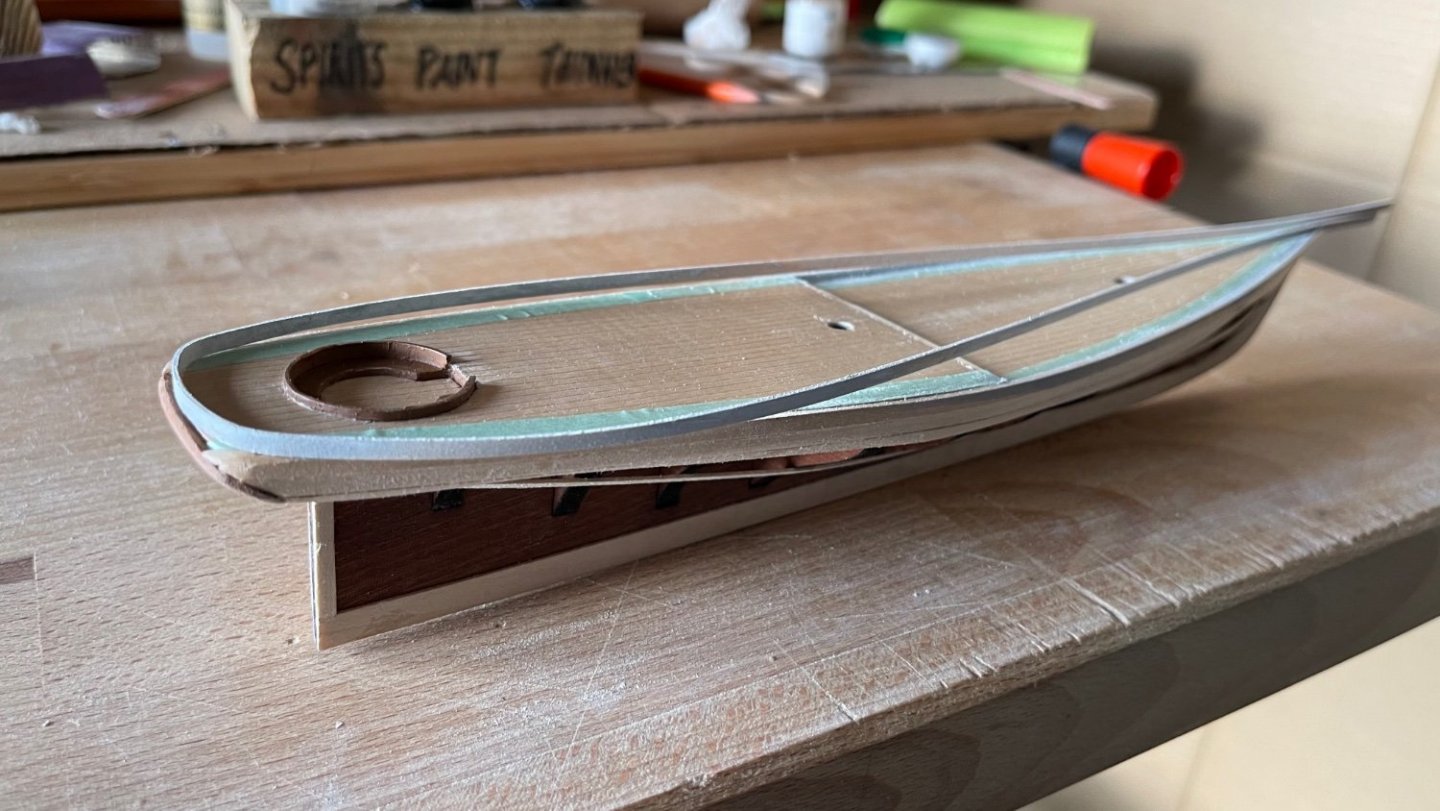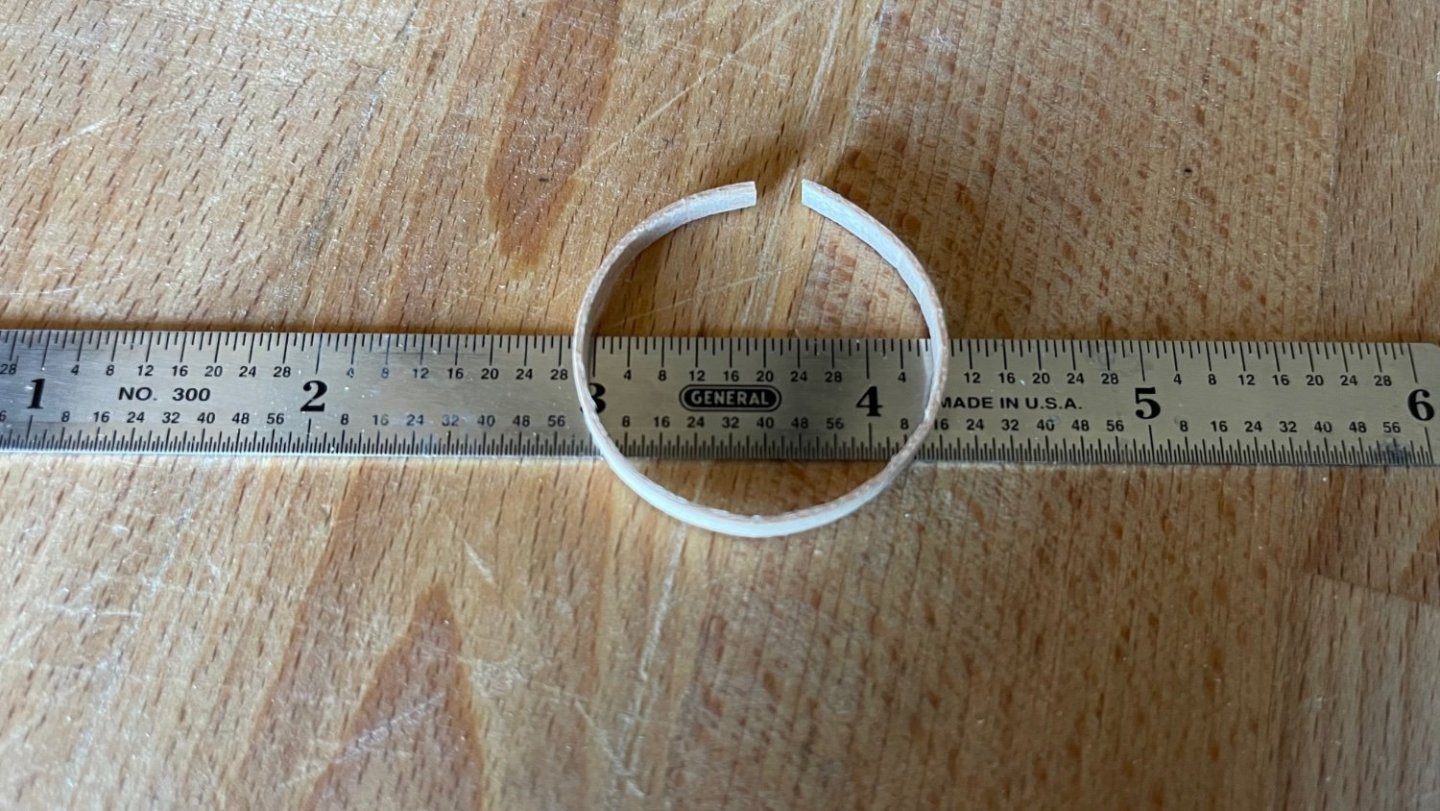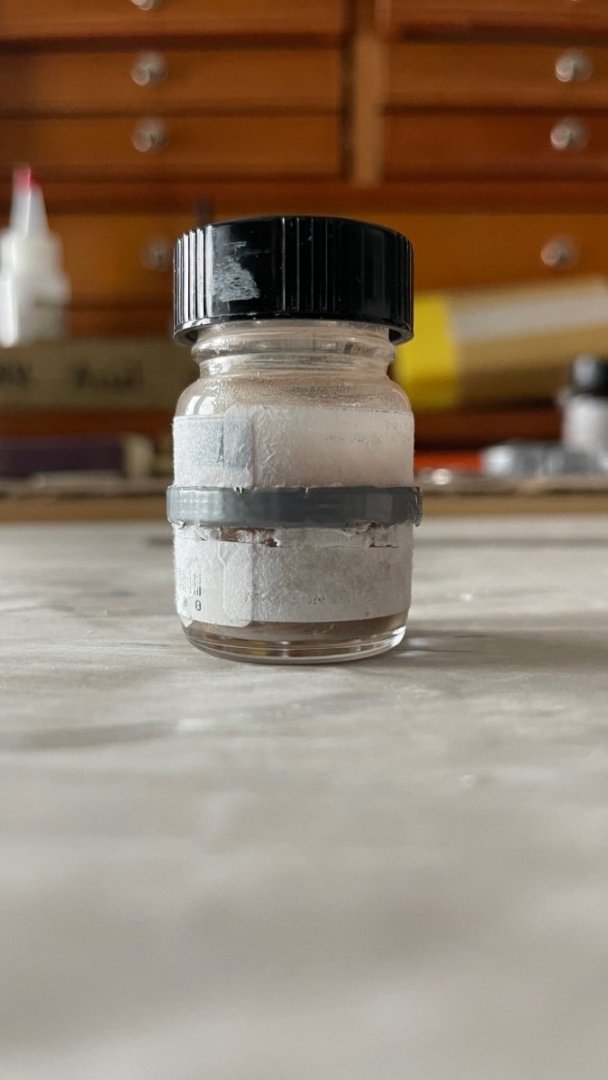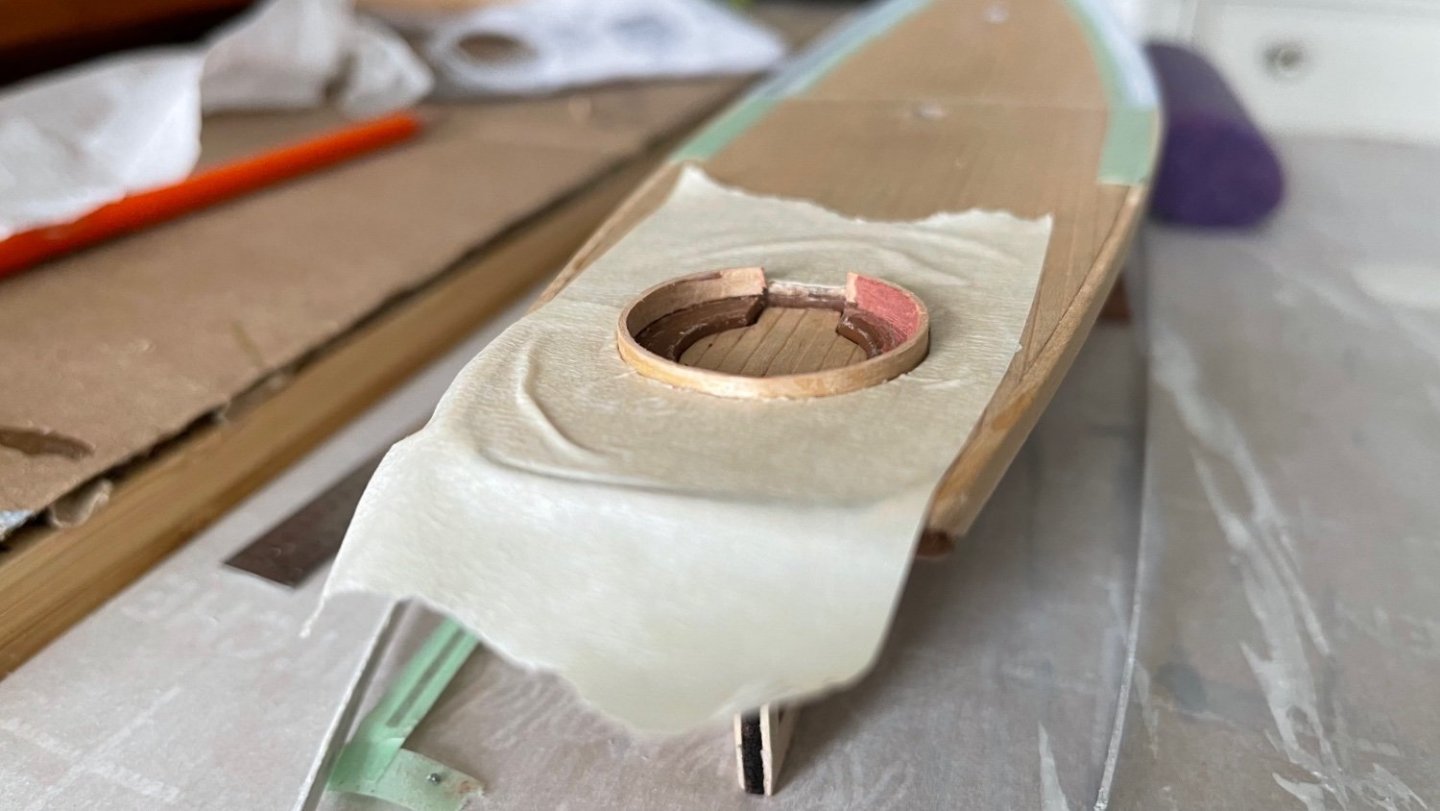-
Posts
150 -
Joined
-
Last visited
Content Type
Profiles
Forums
Gallery
Events
Everything posted by closehaul
-
Thank you Nirvana, I look forward to improving on my builds with each successive vessel.
- 37 replies
-
- BlueJacket Shipcrafters
- America
-
(and 1 more)
Tagged with:
-
Me too Bob. The steel construction of Atlantic may account for the size difference over the wooden schooner yacht America.
- 37 replies
-
- BlueJacket Shipcrafters
- America
-
(and 1 more)
Tagged with:
-
Thank you gsdpic. This was a must build when I first saw it.
- 37 replies
-
- BlueJacket Shipcrafters
- America
-
(and 1 more)
Tagged with:
-
The last of America’s details have been added about the decks,hull and rigging. Anchors and chains set in place, the eagle mounted to the transom, flag hoisted, rope coils hung on belaying pins and the sheets flemished down on the deck. I used the whole 5 yards of .006 line provided in the kit to make the rope coils which surprisingly came off better than my last build, but the Flemish coils on deck kept separating and had to be done over or scrapped. The last items attached were the gudgeons and pintles on the sternpost and rudder. CA glue was used on all these above items except for the flag and rope coils which were brushed over with a 50/50 white glue/water mix. The bottom photo is of America snug in her new berth. Having completed this Bluejacket kit I was quite pleased especially with the deck furniture and rigging coming off clean for me. The kit is rated intermediate so this being my first POF build it was inevitable I wouldn’t pull off a properly faired hull. To compensate on the next build I’ll be using a Model Shipways fair-a-frame building slip and using Titebond II wood glue instead of CA glue and study the various fairing techniques in MSW. Ciao everyone! Ange
- 37 replies
-
- BlueJacket Shipcrafters
- America
-
(and 1 more)
Tagged with:
-
At this point of the build I thought I’d do a size comparison of America with my previous build of Atlantic. Both vessels share the same 1/8” scale.
- 37 replies
-
- BlueJacket Shipcrafters
- America
-
(and 1 more)
Tagged with:
-
The running rigging has been rove through all blocks using .010” 3 braided polyester line (top photo). The second photo down shows all running gear lines have been made fast to belaying pins and cleats about the spars and decks. The details of the belaying pins and some of the foremast gaff rigging lines are the 3rd and 4th photos. The bottom shot is the entire rigging having now been trimmed of excess line from the cleats and pins.
- 37 replies
-
- BlueJacket Shipcrafters
- America
-
(and 1 more)
Tagged with:
-
In the top photo all of the rigging shrouds have had the lanyards rove through the deadeyes and left slack. The forestay at one end, having been made fast on the lower mast cap ring is lead down through the hole at the tip of the bowsprit and rove through secured to the eyepin just above the waterline at the bow. Also the bobstay is run from the same eyepin up to the end of the bowsprit’s eye ring. The bobstay and forestay each have a pair of blocks with a lanyard rove to trim them. The main topsail stay and the mainmast spring stay (one length of cord for both) were rove starting at the upper end of the main topsail downward through the upper eyeband ring and back to the eye on the fore of the lower main mastcap. The last lines to complete the standing rigging are the jib club topping lift pendant and the main boom topping lift pendant. The bottom photo shows all standing rigging trimmed and ready now for the running rigging.
- 37 replies
-
- BlueJacket Shipcrafters
- America
-
(and 1 more)
Tagged with:
-
I applied 1/16” gold block letters to the transom for “America”. They will soon be brushed over with a flat topcoat (Minwax polycrylic). While paging through my copy of “The low black schooner” I couldn’t find any image of the ship’s namesake affixed on the bow planking so It remains it’s black base coat. I’m still working on painting the transom eagle figure. Painting the red and white striping on the Union shield is proving to be a challenge but it’s very easy to wipe it clean and try again. In between the painting attempts I started the standing rigging with the guys and moved onto the foremast shrouds using .020 black polyester thread. The deadeyes having been made fast to the shroud ends and chainplates (portside) are to be reeved next.
- 37 replies
-
- BlueJacket Shipcrafters
- America
-
(and 1 more)
Tagged with:
-
Blocks, cleats, belaying pins, mast hoops and mast boots have been affixed to the spars. The masts have beeb temporarily stepped for the photo only. Once they are removed I will attempt applying 1/16” block letters for the name on the bow and transom. (Lord willing) along with the eagle emblem. Note: the mast hoops (1/4" ID split rings) and boots (3/16" ID britannia metal) were additional parts I purchased from Bluejacket Shipcrafters in leu of scratch building them from the brass wire and basswood provided in the kit.
- 37 replies
-
- BlueJacket Shipcrafters
- America
-
(and 1 more)
Tagged with:
-
The spars having been shaped were then painted at their spar tips, bases and mastheads. Eight eyepins were inlayed into each of the spiderbands on the fore and main masts and their accompanying belaying pins then glued into the eyes. One note of caution, if you plan on using eyepins for the bands as the instructions direct then you will need more eyepins than the thirty the kit provides. (I had extra eyepins I ordered on my previous build of Atlantic.) One alternative would be to just drill eight vertical holes through the bands to secure the belaying pins. The jaws rest for the main boom was then affixed just above the spiderband. The remaining blocks and mast hoops were then painted with modelmasters flat military brown enamel.
- 37 replies
-
- BlueJacket Shipcrafters
- America
-
(and 1 more)
Tagged with:
-
This quote is a remedial post of the transom correction I’ve been working on the last six weeks. A new transom has been fashioned according to scale from the sail plan. After having pressed the curve into the new transom, a 1/32” thick wood insert was glued to widen the stern section along the top of the transom and puttied to plan. My error in the first attempt was not taking time to properly interpret the sail plan and to stop the build until the plan was fully comprehended.
- 37 replies
-
- BlueJacket Shipcrafters
- America
-
(and 1 more)
Tagged with:
-
All deck hardware has been installed minus the blocks for the eyes and horse. The blocks were drilled clean with a #75 bit and had burrs smoothed down with an Emory board. Then they were pre-cleaned, rinsed and dried before being coated with a thinned half and half coat of True North grey primer.
- 37 replies
-
- BlueJacket Shipcrafters
- America
-
(and 1 more)
Tagged with:
-
So now I’m drilling #75 bit holes for the eye and cleat positions about the decks. The furniture is set according to the deck layouts but at this point in the build I have to point out a major inconsistency in the build. The actual deck aft of the cockpit extends well beyond the plan about 3/16” further to the stern bulwark. The position of the cockpit was built on the laser precut hole in the sub quarterdeck that lies beneath the scribed decking cut out for it but the main mast hole of the same subdeck was in line perfectly to accommodate the mast. At this point I’m at a loss to pinpoint how I could have rectified this after rolling it around my head for the last couple of days but will simply contribute it to operator error. Otherwise America is coming along swimmingly.
- 37 replies
-
- BlueJacket Shipcrafters
- America
-
(and 1 more)
Tagged with:
-
I was just browsing and ran across your latest build log Bob. Your detailed building techniques especially concerning the fairing of Flirt’s frame and hull are the skills needed for me to properly assemble a planked vessel after I’ve finished the Bluejacket 1/8” scale America. I’ll be studying your log closely to avoid the pitfalls I experienced in fairing America’s hull which were naturally to be expected in my learning process. It’s quite admirable how quickly and accurately you built Flirt’s frame and faired the bulkheads to lay the planking flush against them, just one of many techniques I intend on mastering in my own future builds.
Ciao! Angelo -
It’s been a few weeks since the last post. I was fussing on the deck furniture getting them straight and plumb. The quarterdeck skylight was particularly troblsome having to do it over twice but satisfactory result upon completion.
- 37 replies
-
- BlueJacket Shipcrafters
- America
-
(and 1 more)
Tagged with:
-
The hull is now completed and mounted on the kit stand per instruction booklet. The trailboards were time consuming, making several attempts of painting the guild scrollwork onto them. Once painted they were lightly ca glued to the beak just under the hawse holes. A photo of the trailboard on America 2.0 I took when it was docked in Key West shows the intricate scrollwork that just wasn’t going to happen on this build unfortunately. Upon completing the hull painting, it was sealed with a polycrylic clear matte coating both sides, display stand included.
- 37 replies
-
- BlueJacket Shipcrafters
- America
-
(and 1 more)
Tagged with:
-
I came to a point in the build where a bowsprit eye and had to be placed so this was good timing for working with the metal toners on all four of the britannic metal eye bands while hull bottom paint coats were being applied. The top photo is the prepped eye bands that were filed and fine sanded smooth. Next photo down, a 10 minute immersion in the cleaning solution afterwards rinsed in warm water and immersed in a 1:10 solution of toner to water. Third photo down they have been removed, rinsed in warm water and air dried. The forth photo is the finished eye bands after they have been tumbled in a container of coarse sawdust to give uniform blackening to the pieces. Fifth photo is the eye and placed on the bowsprit. The whole process went pretty smooth and the results were much better than if I had painted them instead. Finally after applying 10 coats of bottom paint the waterline tape was removed and the results were very satisfying. Although there are some small areas that need further finishing, the waterline sharpness was the result I was aiming for.
- 37 replies
-
- BlueJacket Shipcrafters
- America
-
(and 1 more)
Tagged with:
-
After removing the cap rails from the bending form, they were sanded and had a fruitwood stain applied and CA glued to the top edge of the bulwarks. The 12” long cap rails were about a half inch short of the transom so a cap rail was cut for the shortage and transom, sanded and puttied at the seams where the cap rails joined port and starboard a half inch forward of the transom (note the photo of the putty can bottom label recommends it for fruitwood stain). Once the cap rails were affixed I turned my attention back to the hull and prepped the waterline, primed and painted the the hull with 50/50 paint to thinner mixture. The picture of the bottom paint is it’s third coat of ten. The paint color presented a problem because modelmasters no longer puts out the British crimson red required so I reluctantly used Testors’ rust red ironically to match as close as possible a brownish aged copper color for the bottom. The fact was when I visited Hobby Lobby they no longer had any Modelmasters paints at all on their shelves.
- 37 replies
-
- BlueJacket Shipcrafters
- America
-
(and 1 more)
Tagged with:
-
Thank you Bob for telling me about this. Instead of my lap top I used the photo library on my iPhone and that fixed it. I’ll be posting from the Iphone from now on.
- 37 replies
-
- BlueJacket Shipcrafters
- America
-
(and 1 more)
Tagged with:
-
The topside painting is coming along and the channels have been added although I forgot to ca glue them before painting. The trail boards took me several trial & errors before I got them down right: the little ball at their forward end kept breaking along the grain when trying to cut them carefully out. So I punched out a small round of 1/32" thick stock, sanded it flat on its diameter and CA glued it onto the trail boards. The bowsprit painting is near complete with only some minor finishing remaining.
- 37 replies
-
- BlueJacket Shipcrafters
- America
-
(and 1 more)
Tagged with:
-
The last few areas on the hull and bulwarks have bondo applied, finished smooth with 400 grit and primed. Turning my attention to the timberheads, 1/16”” mahogany stock is then painted and cut to lengths of 1/4” & 1/8” for the bulwarks along the quarter and main decks. A total of 44 timberheads are ca glued at 1/2” intervals along the bulwarks. The 5th photo down is the bowsprit shaped from 3/16” square basswood stock and sanded first with 120 grit and final surfacing with 400 grit.
- 37 replies
-
- BlueJacket Shipcrafters
- America
-
(and 1 more)
Tagged with:
-
Putting 120 grit sandpaper to the hull planking I carefully worked the high spots but not so much as to thin out the 1/32” plank thickness. After the initial application of bondo to the obvious surface discontinuities, 400 grit paper worked it slightly more fair. A first coat of primer was brushed on and sanded down the next day again with 400 grit. Subsequent 2nd and 3rd bondo spacklings were applied and primed. As it stands now I have a few small spots to hit and that should bring it to my satisfaction. In between priming and puttying, I set up a form to bend the three 12” long planks (one of them is a spare just in case) for the cap rails which were first soaked in distilled water one day and taped down flat to the form in place. After completely drying out, they’ll then be removed off the form and glued on to the bulwarks once the timberheads have been installed.
- 37 replies
-
- BlueJacket Shipcrafters
- America
-
(and 1 more)
Tagged with:
-
The three photos below are of the bulwark planking around the deck. Using one of the kits 1/32” x 1/8” x 12” planks, It was immersed in water for 24 hrs. Next a bending form was fashioned from some 1/8” thick scrape basswood and slowly pressed the plank as shown in the photo. I removed it from the form the next day, extended additional planks to the bow, and then ca glued it to where it sets along the transom at present.
- 37 replies
-
- BlueJacket Shipcrafters
- America
-
(and 1 more)
Tagged with:
-
The three photos below are of the cockpit coaming made from 1/32” x 1/8” x 4” plank. After soaking the wood for a day I layed it on duct tape and then slowly (1rpm) wrapped it around a paint bottle allowing it to dry (make sure the duct tape is adequately trimmed off the sides of the plank to facilitate drying) a day also. This process was repeated 3 times to achieve it without major creasing of the wood. After removing it off the glass form I did find small creases on the inner circumference. Auto body putty was applied and sanded with 400 grit then the coaming was ca glued in place and painted.
- 37 replies
-
- BlueJacket Shipcrafters
- America
-
(and 1 more)
Tagged with:
-
The sail plan you sent is a great help so that I now see the issue. I drilled holes through the top mast for both #1 & #2 lines instead of wrapping them. Running lines thru the mast top is not actually on the ship. I did it to facilitate the rigging process due to my lack of skill in wrapping them around it instead. You may want to try wrapping them to have a more authentic model instead of the shortcut I took. I hope this expands on my previous reply, and good luck! It sounds like you are progressing well into the build.
- 127 replies
About us
Modelshipworld - Advancing Ship Modeling through Research
SSL Secured
Your security is important for us so this Website is SSL-Secured
NRG Mailing Address
Nautical Research Guild
237 South Lincoln Street
Westmont IL, 60559-1917
Model Ship World ® and the MSW logo are Registered Trademarks, and belong to the Nautical Research Guild (United States Patent and Trademark Office: No. 6,929,264 & No. 6,929,274, registered Dec. 20, 2022)
Helpful Links
About the NRG
If you enjoy building ship models that are historically accurate as well as beautiful, then The Nautical Research Guild (NRG) is just right for you.
The Guild is a non-profit educational organization whose mission is to “Advance Ship Modeling Through Research”. We provide support to our members in their efforts to raise the quality of their model ships.
The Nautical Research Guild has published our world-renowned quarterly magazine, The Nautical Research Journal, since 1955. The pages of the Journal are full of articles by accomplished ship modelers who show you how they create those exquisite details on their models, and by maritime historians who show you the correct details to build. The Journal is available in both print and digital editions. Go to the NRG web site (www.thenrg.org) to download a complimentary digital copy of the Journal. The NRG also publishes plan sets, books and compilations of back issues of the Journal and the former Ships in Scale and Model Ship Builder magazines.

